Best Graphics Cards for Gaming in 2022
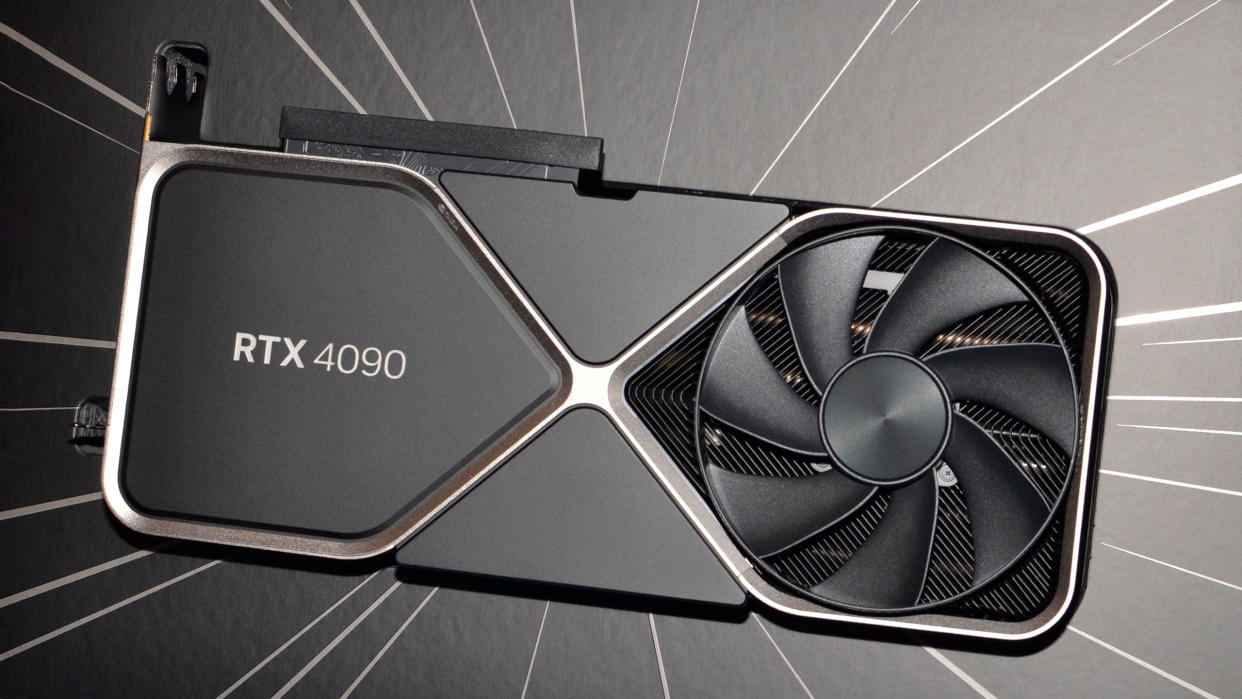
The best graphics cards are the beating heart of any gaming PC, and everything else comes second. Without a powerful GPU pushing pixels, even the fastest CPU won't manage much. While no one graphics card will be right for everyone, we'll provide options for every budget and mindset below. Whether you're after the fastest graphics card, the best value, or the best card at a given price, we've got you covered.
Where our GPU benchmarks hierarchy ranks all of the cards based purely on performance, our list of the best graphics cards looks at the whole package. Price, availability, performance, features, and efficiency are all important, though the weighting becomes more subjective.
The long, dark night of GPU shortages and horrible prices is coming to an end... sort of. The recently launched GeForce RTX 4090 unfortunately sold out immediately, and we've seen scalpers and profiteers offering cards at significantly higher prices. But we'll need to see what happens in the next month or two, because a card like the 4090 was always going to sell out at launch.
Now that cryptocurrency GPU mining profitability is in the toilet (every GPU would cost more in electricity than you could possibly make from any current coin), graphics card prices are dropping and there's an excess of supply for now-previous-gen cards. The major GPUs are all in stock, mostly for less than their official MSRPs — though you may need to hit up Best Buy to get MSRPs on some of the Nvidia RTX 30-series cards.
Besides the RTX 4090, we've also tested and reviewed the Intel Arc A770 and Intel Arc A750, two newcomers that target the midrange value sector and deliver impressive features and performance — assuming you don't happen to run a game where the drivers hold Arc back. We've added the A770 16GB model to our list as a "lucky" number 13. There are still more upcoming cards, with RTX 4080 (formerly 4080 16GB) coming in November, and AMD's RDNA 3 may arrive next month as well, with an AMD reveal set for November 3.
Graphics Card | Value — Online (MSRP) | Performance | DXR Performance |
|---|---|---|---|
13 — $2179 ($1600) | 1 — 145.1 | 1 — 149.3 | |
12 — $950 ($1100) | 2 — 120.6 | 3 — 68.4 | |
6 — $600 ($650) | 3 — 106.6 | 4 — 56.7 | |
11 — $730 ($700) | 4 — 104.0 | 2 — 79.9 | |
3 — $550 ($580) | 5 — 95.9 | 7 — 48.4 | |
7 — $470 ($550) | 6 — 85.6 | 8 — 40.3 | |
5 — $400 ($400) | 7 — 78.0 | 5 — 53.1 | |
8 — $350 ($350) | 8 — 69.1 | 6 — 47.2 | |
2 — $300 ($500) | 9 — 66.0 | 11 — 30.2 | |
9 — $369 ($330) | 10 — 59.9 | 9 — 39.7 | |
1 — $248 ($330) | 11 — 54.6 | 12 — 24.5 | |
4 — $237 ($350) | 12 — 45.4 | 10 — 29.1 | |
10 — $160 ($200) | 13 — 23.3 | 13 — 7.9 |
Note: We're showing current online prices alongside the official launch MSRPs in the above table, though the "value" column uses the retail price.
Our list consists almost entirely of current generation cards — or "previous" generation now that the RTX 4090 has arrived — except for the RTX 2060. That's slightly faster than the newer RTX 3050, and while it 'only' has 6GB VRAM, the current price of $238 at Newegg makes up for that. Note also that prices have slowed or in some cases completely stopped their downward trend, at least compared to last month. That's probably more to do with the high price of the RTX 4090 than decreased supply or increased demand.
We sorted the above table in order of performance, considering both regular and DXR performance, which is why the RTX 4090 sits at the top. We also factor in 1080p, 1440p, and 4K performance for our standard benchmarks, though it's worth noting that the 4090 can't really flex its muscle until at least 1440p. Our subjective rankings below factor in price, power, and features colored by our own opinions. Others may offer a slightly different take, but all of the cards on this list are worthy of your consideration.
Best Graphics Cards for Gaming 2022
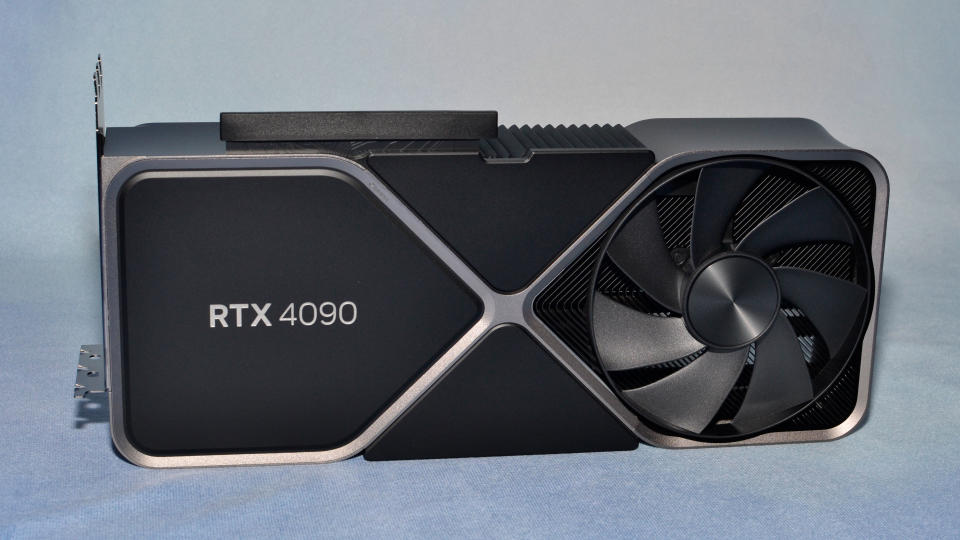
1. GeForce RTX 4090
Fastest Graphics Card, Great for Creators
GPU: Ada AD102 | GPU Cores: 16384 | Boost Clock: 2,520 MHz | Video RAM: 24GB GDDR6X 21 Gbps | TBP: 450 watts
The fastest GPU, period
Excellent 4K and maybe even 8K gaming
Powerful ray tracing hardware
DLSS and now DLSS 3
24GB is great for content creation workloads
Extreme price and power requirements
Cards are mostly out of stock
Needs a fast CPU and large PSU
Need to see what RDNA 3 can do
For some, the best graphics card is the fastest card, pricing be damned! Nvidia's GeForce RTX 4090 caters to precisely this category of user. It's also the debut of Nvidia's brand-new Ada Lovelace architecture, and as such will represent the most potent card Nvidia has to offer... at least until the inevitable RTX 4090 Ti shows up.
If you were disappointed that the RTX 3090 Ti was only moderately faster (~30%) than an RTX 3080 in most workloads, RTX 4090 will have something more to offer. Across our standard suite of gaming benchmarks, it was 55% faster than the 3090 Ti on average. Fire up a game with heavy ray tracing effects, and that lead grows to 78%! Against AMD's currently fastest GPU, the RX 6950 XT, the 4090 is 65% faster in traditional rasterization games and nearly triple the performance in ray tracing games.
Let's be clear about something: You really need a high refresh rate 4K monitor to get the most out of the RTX 4090. At 1440p its advantage over a 3090 Ti shrinks to 30%, and only 16% at 1080p. It's also just 10% faster than AMD's 6950 XT at 1080p ultra, though it's still more than double the performance in demanding ray tracing games.
It's not just gaming performance, either. In professional content creation workloads like Blender, Octane, and V-Ray, the RTX 4090 is about 80% faster than the RTX 3090 Ti. With Blender, it's six times faster than the RX 6950 XT. Nvidia knows a thing or two about professional applications, and the only potential problem is that it locks improved performance in some apps (like those in SPECviewperf) to professional cards like the RTX 6000 48GB.
We still need to see AMD's response to Ada Lovelace, and we'll learn more on November 3 about what RDNA 3 will offer, and how much it will cost. You might also want a CPU and power supply upgrade to get the most out of the 4090. And there's still the matter of finding RTX 4090 cards in stock — they sold out almost immediately at launch, and scalpers (and companies following their example) have pushed prices well above $2,000 for the time being. Hopefully prices come down quickly this round, and with the lack of GPU mining profits, that ought to be the case.
Read: Nvidia GeForce RTX 4090 Review
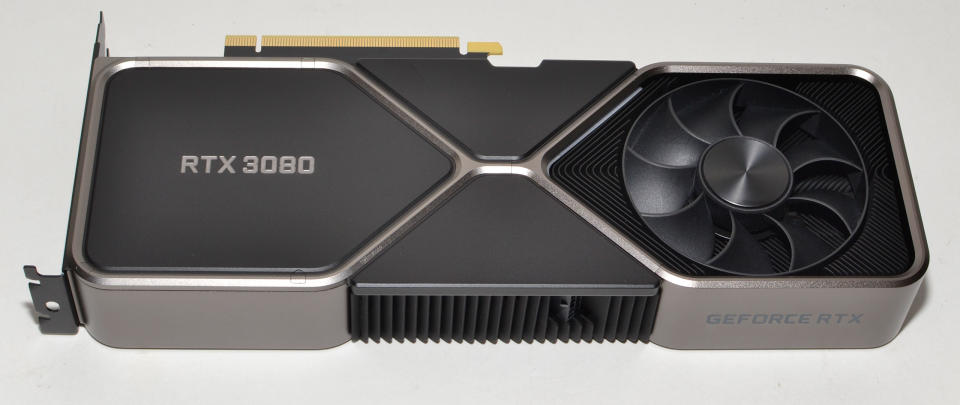
2. GeForce RTX 3080
Last Generation's Best Overall Pick
GPU: Ampere GA102 | GPU Cores: 8704 | Boost Clock: 1,710 MHz | Video RAM: 10GB GDDR6X 19 Gbps | TBP: 320 watts
Good bang for the buck
Can mostly do 4K at 60 fps or more
DLSS and DXR performance
Prices remain above MSRP
More Ada cards are coming
Overkill for 1080p displays
Nvidia's GeForce RTX 3080 with the now previous generation Nvidia Ampere architecture continues to be a great alternative, though it's now lost some of its luster. The recommendation also applies to all RTX 3080 cards, including the RTX 3080 Ti and RTX 3080 12GB — depending on current prices. Right now, the best deals we can find are $730 for the 10GB card, $740 for the 12GB model, or $800 for the 3080 Ti.
If you like to max out all the graphics settings and play at 4K or 1440p, this is a great choice. It's more than you'll generally need for 1080p gaming, unless you're running the latest ray tracing games, in which case DLSS support should also help performance. DLSS also works without ray tracing, and is currently available in over 200 games, so it's definitely a feature that's worth a bit extra.
AMD offers the universal FSR 2.0 as an alternative to DLSS, but it's not in nearly as many games. Intel's XeSS meanwhile sounds a lot like DLSS, only for Intel GPUs, which limits its utility — on non-Arc GPUs, even though XeSS can run, it doesn't look as nice and doesn't improve performance as much as DLSS or FSR2.
The biggest problem with buying an RTX 3080-series card right now is the upcoming RTX 4080 (and presumably RTX 4070), along with AMD's RDNA 3 GPUs. The RTX 4090 represents the ultimate in graphics performance, and it can more than double the RTX 3080 performance — and price. We should see more reasonable RTX 4080 and 4070 models in the coming months, which makes the prospect of spending anything north of $500 on a 30-series GPU rather unappealing.
Further Reading:
Nvidia GeForce RTX 3080 Review
Nvidia GeForce RTX 3080 12GB Review
Nvidia GeForce RTX 3080 Ti Review
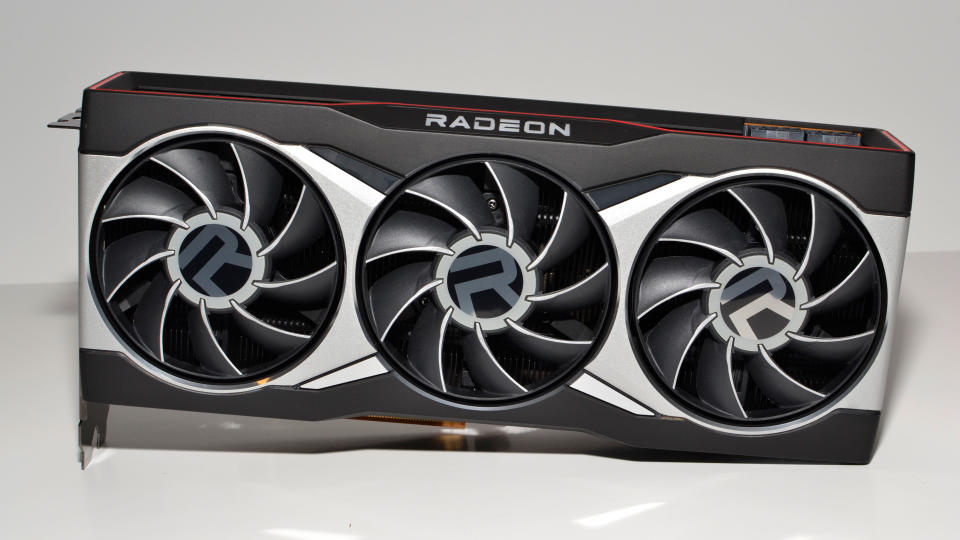
3. Radeon RX 6800 XT
Best Overall AMD GPU, Forget About DLSS and DXR
GPU: Navi 21 XT | GPU Cores: 4608 | Boost Clock: 2,250 MHz | Video RAM: 16GB GDDR6 16 Gbps | TBP: 300 watts
Easily handles 4K and 1440p
Lots of VRAM for the future
Impressive Infinity Cache
FSR 2.0 needs wider adoption
Weaker ray tracing performance
RDNA 3 arrives next month
AMD's Navi 21 GPUs like the Radeon RX 6800 XT represent the best cards for Team Red. The RX 6800 XT provides a massive boost in performance and features relative to the previous generation RX 5700 XT, as well as adding ray tracing support (via DirectX Raytracing or VulkanRT) thanks to the RDNA 2 architecture. At current prices, which have dropped quite a bit in the past few months, the RX Radeon 6900 XT and RX 6800 are also worth a look. The 6900 XT for example now costs 17% more for about 5% higher performance, while the RX 6800 drops performance by 7% and also costs 7% less.
The Navi 21 GPU was affectionately dubbed 'Big Navi' prior to launch by the enthusiast community, and we got exactly what we wanted. It's over twice the size of the previous generation Navi 10, with twice the shader cores and twice the RAM. Clock speeds are also boosted into the 2.1-2.4 GHz range (depending on the card model), and AMD did all this without substantially increasing power requirements: The RX 6800 XT has a 300W TBP, slightly lower than the RTX 3080's 320W TBP.
A big part of AMD's performance comes thanks to the massive 128MB Infinity Cache. It improves the effective bandwidth by 119%, according to AMD. Few if any games need more than 16GB, so the 6800 XT is in a great position in that area.
What's not to like? The ray tracing performance is mediocre, due to AMD's lack of hardware BVH traversal (it shares the texture units for that). There's also no Tensor cores or DLSS, though FSR 2.0 at least partially makes up for that. As with Nvidia's top GPUs, the biggest concern is the upcoming RDNA 3. If you don't already have one of AMD's top GPUs, waiting for the RX 7000-series to arrive (before the end of the year) makes more sense than plunking down $600 or more on a GPU from two years ago.
Further Reading:
AMD Radeon RX 6800 XT and RX 6800 Review
AMD Radeon RX 6900 XT Review
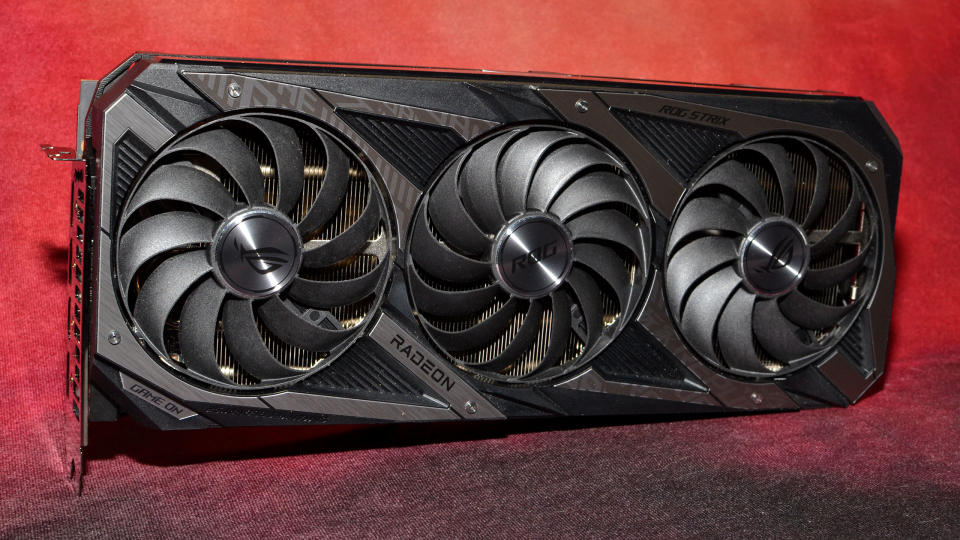
4. Radeon RX 6700 XT
Excellent Performance at a Reasonable Price
GPU: Navi 22 | GPU Cores: 2560 | Boost Clock: 2581 MHz | Video RAM: 12GB GDDR6 16 Gbps | TBP: 230 watts
Great 1080p and 1440p performance
Plenty of VRAM
Excellent price to performance ratio
Weaker RT performance
FSR can't defeat DLSS
Incoming RDNA 3 models
Start with the Navi 21 GPU and then cut down the various functional units to create a smaller die that can sell at lower prices and you have AMD's Navi 22 and the RX 6700 XT. The RX 6750 XT is basically the same GPU, with a slight boost to clock speeds, memory speeds, and power consumption — about 5% faster overall, but with a 12% price hike.
The 6700 XT has the same number of GPU cores as the previous generation RX 5700 XT, but significantly higher clock speeds and more cache give it about a 25% boost to performance (at higher settings and resolutions, at least). During testing, the RX 6700 XT hit clock speeds in excess of 2.5GHz while gaming — and that's at stock, on the reference card. Factory overclocked models can push that closer to 2.7GHz, still without cooking the GPU.
In our performance testing, the RX 6700 XT traded blows with the RTX 3070 and RTX 3060 Ti. It's a bit faster than the latter, and a bit slower than the former, but the going price of around $390 lands below both of those. Still, if we include pretty much any games with DLSS or ray tracing, the 6700 XT comes in well behind the 3060 Ti and almost looks like a 3060 competitor.
This card has moved up in our overall rankings thanks to its excellent online prices. It's currently available at prices starting below $400, basically $100 off the MSRP. While we don't expect a mainstream RX 7000 replacement until early 2023, that's not guaranteed, and we need to see what RDNA 3 brings to the table next month.
Further Reading:
AMD Radeon RX 6700 XT review
AMD Radeon RX 6750 XT review
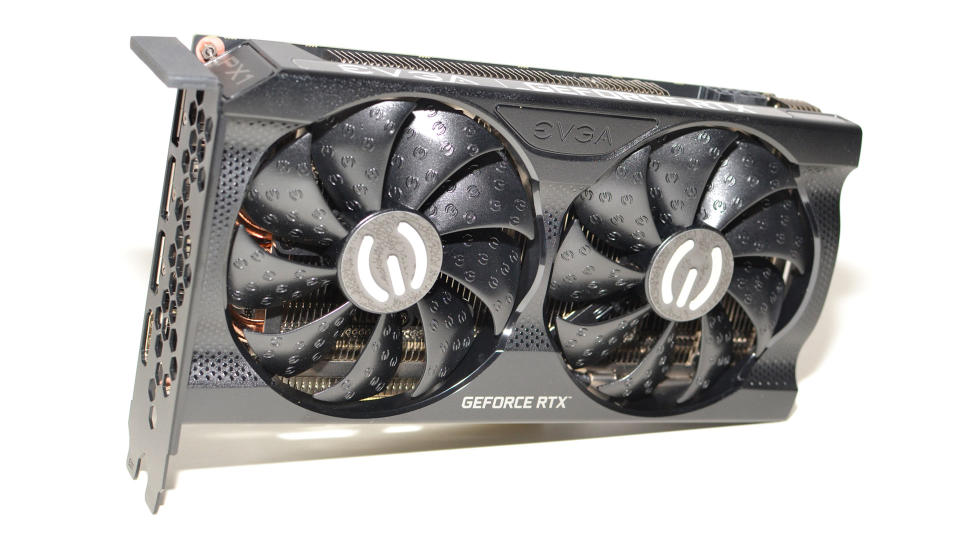
5. GeForce RTX 3060
Great Bang for the Buck Without Breaking the Bank
GPU: Ampere GA106 | GPU Cores: 3840 | Boost Clock: 1,777 MHz | Video RAM: 12GB GDDR6 15 Gbps | TBP: 170 watts
Good 1080p/1440p performance
Plenty of VRAM for the future
Great value now
Tied with the old RTX 2070
12GB of limited benefit
Only 192-bit bus
As we enter the lower end of the price and performance ladder with Nvidia's desktop Ampere lineup, the cuts to processing power become more significant. The RTX 3060 uses Nvidia's GA106 GPU, with a 192-bit memory interface and 12GB VRAM. That's quite a bit better than the RTX 3050 but still a big step down from the GA104 chip used in RTX 3060 Ti, which has 36% more GPU cores.
Overall performance is similar to the RTX 2070, so two and a half years later, you can match the performance of a formerly $500 graphics card with a $330 alternative. And hey, right as we commence with the next-generation RTX 40-series cards, the RTX 3060 is finally available for close to its MSRP — Amazon has this RTX 3060 for $341. The RTX 3060 still delivers a great overall value, factoring in ray tracing and DLSS performance.
VRAM capacity isn't a problem, and there are a few instances where the 3060 starts to close the gap with the 3060 Ti. It never quite gets there, however, and the 3060 Ti might be a better choice if you can find one at a reasonable price. And if you don't want an AMD card and are still hoping for something extra, check out our wild card pick a couple slots down, the Intel Arc A770 16GB.
Discounting ray tracing and DLSS, in our testing the RTX 3060 ends up being roughly the same performance as AMD's RX 5700 XT, 18 months later. That's not going to set the world on fire, but then that's typical of mainstream parts. With DXR and DLSS, however, the 3060 can even trade blows with AMD's RX 6800. We'll likely see an RTX 4060 "replacement" some time in 2023.
Read: Nvidia GeForce RTX 3060 Review
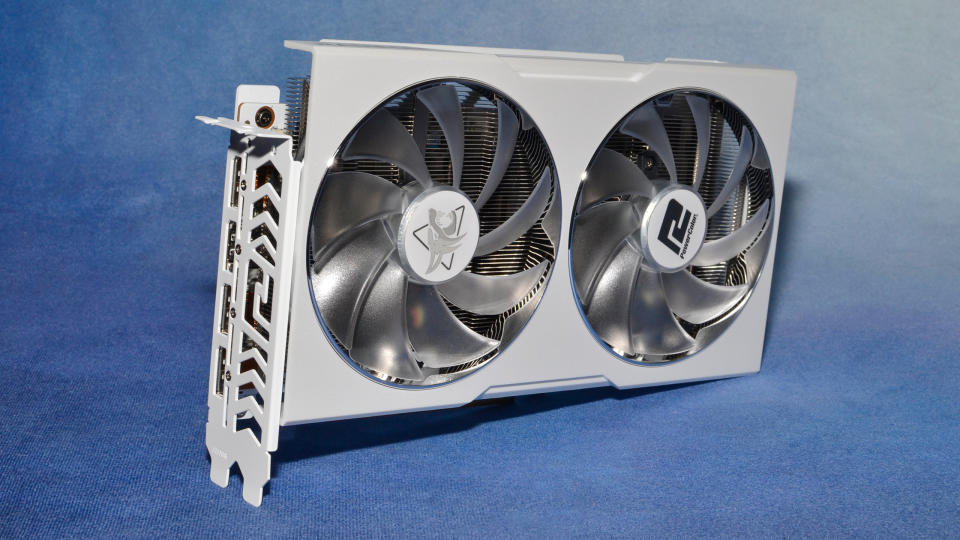
6. Radeon RX 6650 XT
Good Mainstream Performance, Weak RT
GPU: Navi 23 | GPU Cores: 2048 | Boost Clock: 2,635MHz | Video RAM: 8GB GDDR6 18 Gbps | TBP: 180 watts
Often faster than 3060 and RX 5700 XT
Power efficient design
Good 1080p performance
Available well below MSRP
Only 8GB VRAM on a 128-bit bus
Poor ray tracing performance
Expensive for 1080p
AMD's answer to the RTX 3060 comes via the Navi 23 architecture. Normally, we'd expect a 32 CU variant of Navi 22, dubbed the RX 6700 non-XT, but AMD trimmed CU counts, memory interface width, and Infinity Cache sizes to get a smaller and less expensive chip that still performs well. (Note that the Radeon RX 6700 now exists, with 10GB of VRAM, though it costs quite a bit more.)
Performance ends up slightly above the previous gen RX 5700 XT, which is impressive considering the memory bus has been cut in half to just 128 bits. There's understandable concern with the 8GB of VRAM, however, and there are certainly cases where the RTX 3060 ends up as the better choice — especially if you factor in DLSS. Still, it's surprising how much even a 32MB Infinity Cache boosts performance, when you look at the memory bandwidth. This is basically a chip that's smaller than Navi 10, built on the same TSMC N7 node, and it delivers 10–15% better framerates at 1080p.
There are instances where it struggles, however, ray tracing being a big one. Several games that we tested with DXR (DirectX Raytracing) support couldn't even do 20 fps at 1080p. Nvidia's RTX 3060 was about twice as fast, without using DLSS, and typically got an additional 40% faster with DLSS Quality mode. FSR doesn't really fix that, either, since it provides a similar boost in performance to both AMD and Nvidia — and even Intel — GPUs. After delivering impressive amounts of VRAM on the other Big Navi chips, the the RX 6650 XT and RX 6600 XT feel like a letdown.
That's reflected in current online pricing, which has helped turn things around a bit. The RX 6600 XT has a $379 MSRP and the RX 6650 XT bumped that to $399, but both are available starting at less than $300. Against the RTX 3050, which carries a similar online price, the RX 6650 XT looks awesome. AMD isn't due to replace its current midrange offerings until some time later in 2023.
Further Reading:
AMD Radeon RX 6650 XT Review
AMD Radeon RX 6600 XT Review
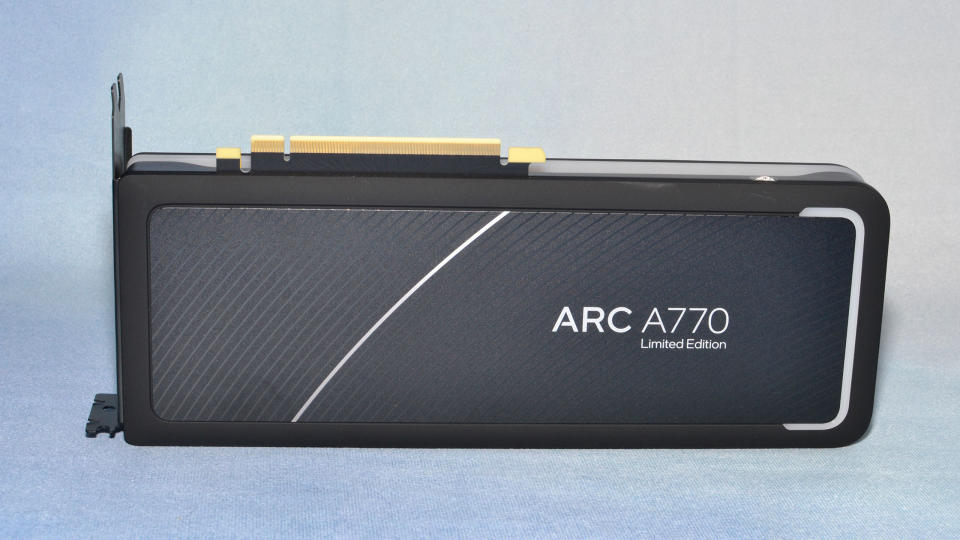
7. Intel Arc A770 16GB Limited Edition
Team Blue's Wild Card
GPU: Alchemist ACM-G10 | GPU Cores: 4096 | Boost Clock: 2,100 MHz | Video RAM: 16GB GDDR6 17.5 Gbps | TBP: 225 watts
Faster than RTX 3060 and 6650 XT
Lots of VRAM (get a 16GB model)
AV1 encoding and XeSS upscaling
Player three has joined the game
Drivers and inconsistent performance
Needs modern PC with ReBAR
Not especially power efficient
Currently out of stock
Testing the Intel Arc A770 Limited Edition was a bit like dealing with Dr. Jekyll and Mr. Hyde. At times, performance looked excellent, sometimes even matching the GeForce RTX 3060 Ti. Other times, Arc came up far short of expectations, trailing the RTX 3060. The drivers continue to improve, however, and we can't help but feel there's a lot of as-yet-untapped potential.
The feature set with the A770 Limited Edition also impresses: a full 16GB of GDDR6 running at 17.5 Gbps, on a 256-bit memory interface. That's double the AMD competition and 33% more than the RTX 3060. Intel also doesn't make any apologies for its ray tracing performance, going blow for blow with the 3060 and coming out on top — except in Minecraft where the game doesn't as yet allow Arc GPUs to enable ray tracing.
Intel was also the first company to deliver hardware accelerated AV1 encoding and decoding support, and QuickSync continues to deliver an excellent blend of encoding performance and quality. There's also XeSS, basically a direct competitor to Nvidia's DLSS, except it uses Arc's Matrix cores when present, and can even fall back into DP4a mode for non-Arc GPUs. But DLSS 2 still comes out on top, and it's in far more games.
If you discount ray tracing and XeSS, the A770 competes against AMD's RX 6650 XT with relatively similar performance. Again, drivers can hold it back, so this is a card for hardware enthusiasts that want to give something new a shot. The biggest concern is that the cards are routinely out of stock and currently only found on Newegg (in the US). Still, $350 for a 16GB card that legitimately beats the RTX 3060 leaves us looking forward to Intel's future Arc Battlemage GPUs, though they're probably at least a year out.
Read: Intel Arc A770 Limited Edition Review
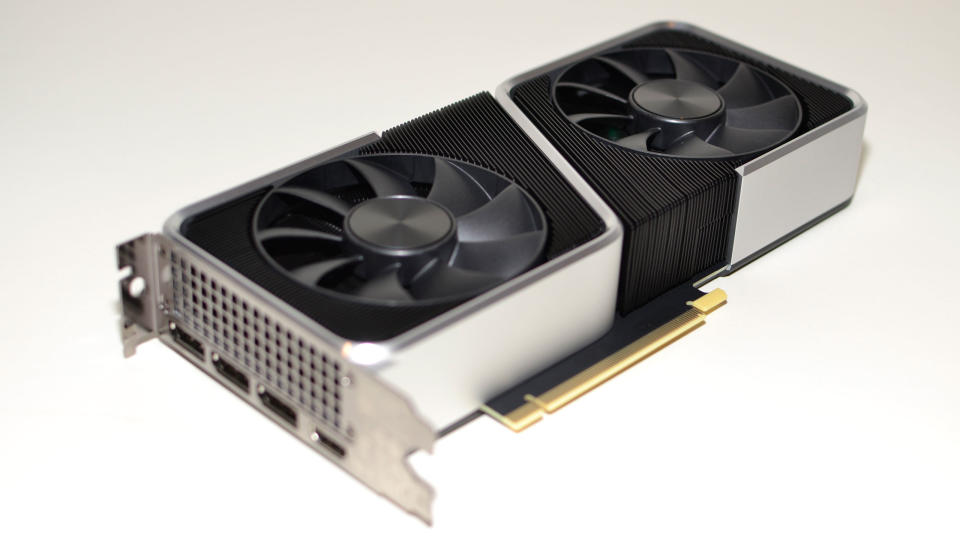
8. GeForce RTX 3060 Ti
Good for 1440p and Ray Tracing
GPU: Ampere GA104 | GPU Cores: 4864 | Boost Clock: 1,665 MHz | Video RAM: 8GB GDDR6 14 Gbps | TBP: 200 watts
Good overall value (fps/$)
Great for RT at 1440p with DLSS
Finally available for $399
4K is a a stretch even with DLSS
8GB VRAM can be limiting
Coming up on two years old
When we tested the GeForce RTX 3060 Ti, we felt it might be the best of the bunch for Nvidia's Ampere GPUs. It has all the same features as the other 30-series GPUs, with a starting price of just $399. That was only in theory at the time, but things have finally changed and you can frequently find the RTX 3060 Ti Founders Edition at Best Buy for $399. Just in time for the next-gen GPUs to launch.
The RTX 3060 Ti beat the previous gen 2080 Super in our testing, winning in every game we ran. It was also only about 9 percent slower than the RTX 3070 but costs 20 percent less. If you're still sitting on an older GTX 1070 or RX Vega 56, the 3060 Ti is up to twice as fast — sometimes even more, in the latest games.
The only real concern is the lack of VRAM. 8GB is mostly enough, for now, but some games are starting to push beyond that threshold. Of course you can drop the texture quality a notch, and you might not even notice the difference, but deep down inside you'll feel regret. (Not really — high settings often look indistinguishable from ultra settings.)
AMD's RX 6700 XT and RX 6650 XT give the 3060 Ti some stiff competition. Nvidia's part is still faster than the 6650 XT, and unequivocally faster in ray tracing games, but the RX 6650 XT currently costs about $100 less. The RX 6700 XT meanwhile gives you 50% more memory, 5–10% higher performance in standard games, and costs $10 less.
Read: Nvidia GeForce RTX 3060 Ti Review
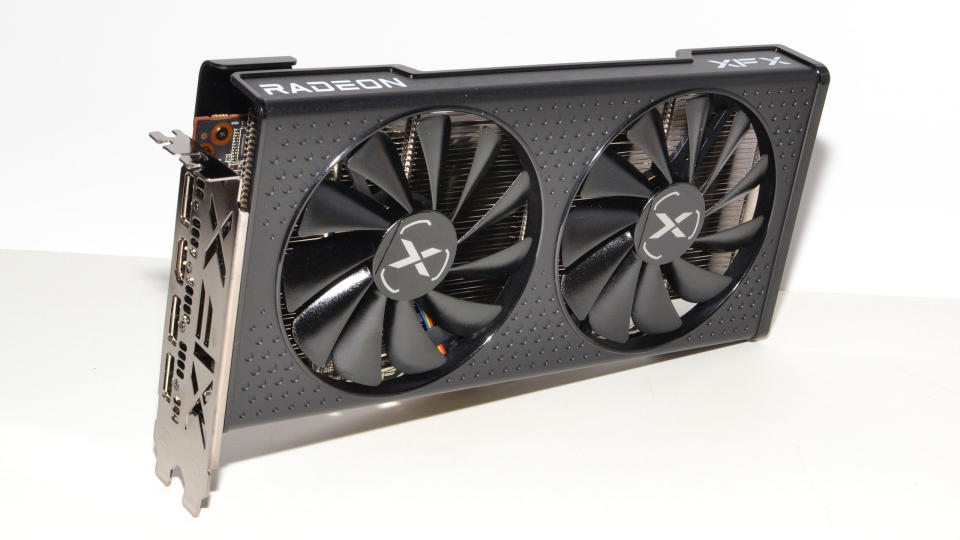
9. Radeon RX 6600
Best Overall Value
GPU: Navi 23 | GPU Cores: 1792 | Boost Clock: 2,491 MHz | Video RAM: 8GB GDDR6 14 Gbps | TBP: 132 watts
Power efficient
Runs 1080p max settings and 60fps
Typically costs less than MSRP
Not good for ray tracing
Can't match the RTX 3060
Only 8GB VRAM
The Radeon RX 6600 takes everything good about the 6600 XT and then scales it back slightly. It's about 15% slower overall, just a bit behind the RTX 3060 as well (in non-RT games), but in our testing it was still 30% faster than the RTX 3050. It's also priced to move, with the least expensive cards starting at just $234 — like this PowerColor RX 6600 card at Amazon.
That's a lot less than AMD's official $329 MSRP, which felt somewhat high at launch — not that we ever saw those prices in meaningful quantities until recent months. But with cards now shipping well below MSRP, this represents the market's best overall bang for the buck.
Midrange graphics cards are a competitive arena, and the RX 6600 goes up against both the RTX 3050 as well as previous generation RTX 20-series and GTX 16-series GPUs. It ended up delivering near-RTX 2070 performance in our testing, at least in non-ray tracing scenarios. With ray tracing enabled, however, it struggled badly, barely averaging 30 fps in our DXR test suite at 1080p medium and trailing Nvidia's RTX 2060 by 20%.
If you're not worried about ray tracing, the RX 6600 definitely warrants a look. AMD's Infinity Cache does wonders for what otherwise looks like a somewhat underpowered GPU, and the card only needs about 130W, far less than competing GPUs. About the only real potential competition on the immediate horizon is Intel's as-yet-unlaunched Arc A580; RDNA 3 GPUs likely won't reach the sub-$250 zone until mid-2023 or later.
Read: AMD Radeon RX 6600 Review
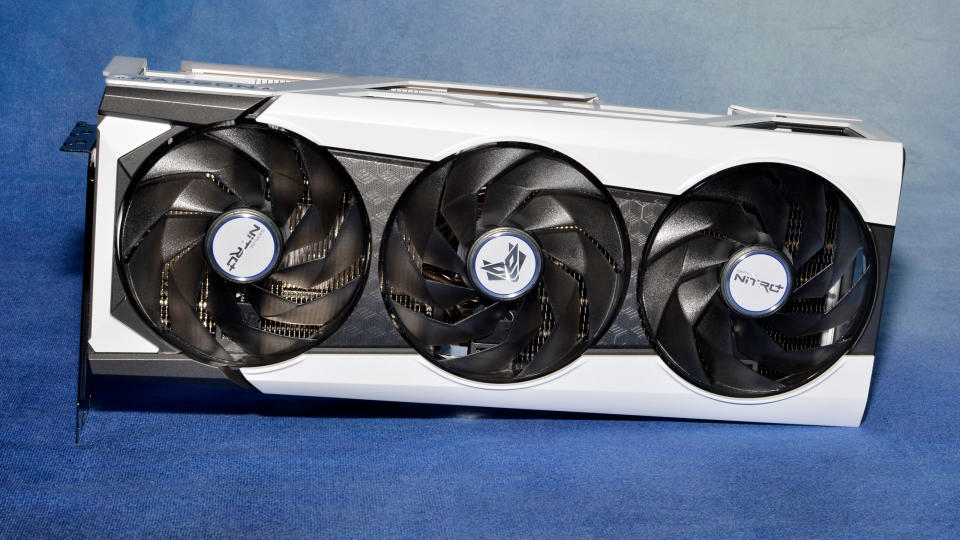
10. Radeon RX 6950 XT
AMD's Fastest GPU, for Now
GPU: Navi 21 XTX | GPU Cores: 5120 | Boost Clock: 2310 MHz | Video RAM: 16GB GDDR6 18 Gbps | TBP: 335 watts
Good overall performance
Lots of VRAM and Infinity Cache
Great for non-RT workloads
Good SPECviewperf results
High starting MSRP
Much slower RT performance
RDNA 3 coming very soon now
The Radeon RX 6950 XT currently represents the ultimate in performance from the RDNA2 architecture, surpassing the old RX 6900 XT by about 9% on average. AMD set the MSRP at a rather high $1,099 at launch, but we're already seeing cards selling well below that mark. The RX 6950 and 6900 XT are basically the same GPU, but with faster 18Gbps GDDR6 on the 6950 along with a higher power limit and slightly higher GPU clocks.
The RX 6950 XT boasts slightly more GPU cores than the RX 6800 XT, and combined with the difference in clock speeds the 6950 XT is about 15% faster overall. However, the 6950 XT costs about 60% more, while the 6900 XT goes for about $200 less, so opting for AMD's penultimate GPU over the top card isn't a terrible idea.
In terms of standard gaming performance, the RX 6950 XT still claims the second spot in 1080p and 1440p gaming, but it falls behind the 3090 and 3090 Ti at 4K — never mind the new RTX 4090. The usual caveats about lower ray tracing performance and the lack of DLSS support apply as well, and while FSR 2.0 looks good, it's not widely supported by games yet. If you want the best DXR/RT experience right now, Nvidia still wins hands down— not that you need ray tracing to enjoy games.
While those who want the fastest AMD GPU may find something to like with the 6950 XT, there's little reason to buy one now. We know RDNA 3 and Navi 31 will launch before the end of the year, probably late next month. AMD says RDNA 3 will deliver a 50% improvement in performance per watt as well, which could result in a 4090 competitor. Maybe. At least in non-DXR games. Waiting another month to see how things turn out makes a lot more sense than upgrading to the 6950 XT at this late stage in the RDNA 2 life cycle.
Further Reading:
AMD Radeon RX 6950 XT review
AMD Radeon RX 6900 XT review
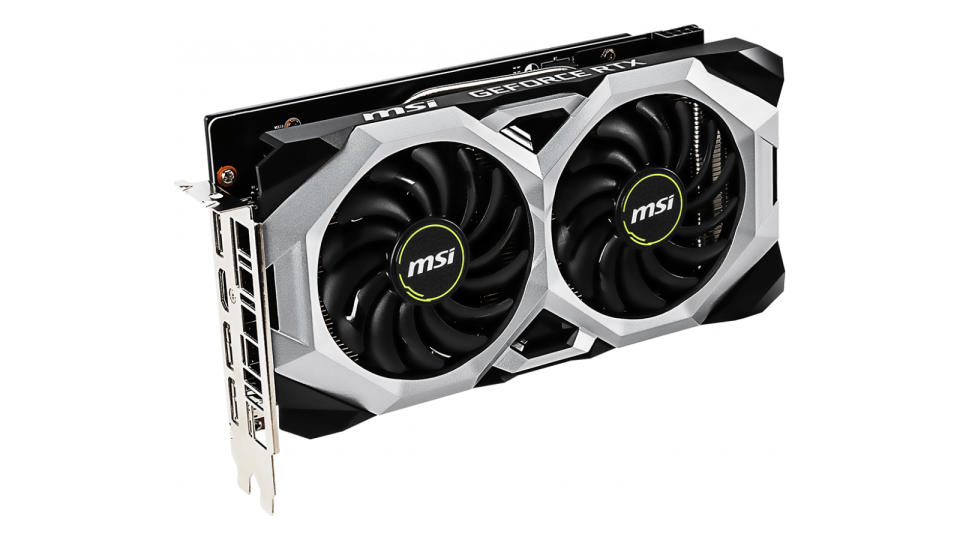
11. GeForce RTX 2060
Decently Fast With Bargain Pricing
GPU: Turing TU106 | GPU Cores: 1920 | Boost Clock: 1,680 MHz | Video RAM: 6GB GDDR6 14 Gbps | TBP: 160 watts
In stock at a great price
6GB VRAM is better than 4GB
Handles 1080p gaming fine
Only 6GB VRAM
Same price as the RX 6600
Inventory may dry up
Getting down to a price point of $200 requires making some compromises, like dropping support for ray tracing and DLSS and opting for Nvidia's previous generation GTX 1660. For $30 more, we'd much rather have the significantly faster and more capable GeForce RTX 2060. It's still a great card, even if it is using the older Turing architecture.
The RTX 2060 6GB is over 65% faster than the RX 6500 XT below, beats the newer RTX 3050 by about 8%, and outperforms the GTX 1660 Super by about 25%. There are a few edge cases where the extra 2GB VRAM helps the 3050, but the increased memory bandwidth and compute performance on the 2060 generally wins out. You could also look for an RTX 2060 12GB if you're worried about VRAM capacity, but supplies seem to be drying up and those currently cost well over $300.
As an RTX card, even the lowest tier 2060 6GB still has full DXR and DLSS support. Okay, sure, it won't be able to run the new DLSS 3 algorithm, but that's true of all RTX 20- and 30-series cards. The 6GB VRAM is a concern, but you can turn down texture settings a notch and you're still getting more memory than most of the alternatives (other than the RX 6600, which is rated higher than this). Nvidia's NVENC hardware also allows for live streaming and encoding your gameplay, which is another feature missing from AMD's Navi 24 hardware.
Our biggest concern is long-term availability. The RTX 2060 was out of stock for much of the past two years, along with everything else. Now it's back, chiefly from EVGA which has decided to exit the GPU market. Once the current supply is gone, RTX 20-series GPUs should disappear completely store shelves and will only be available at places like eBay.
Read: Nvidia GeForce RTX 2060 Review
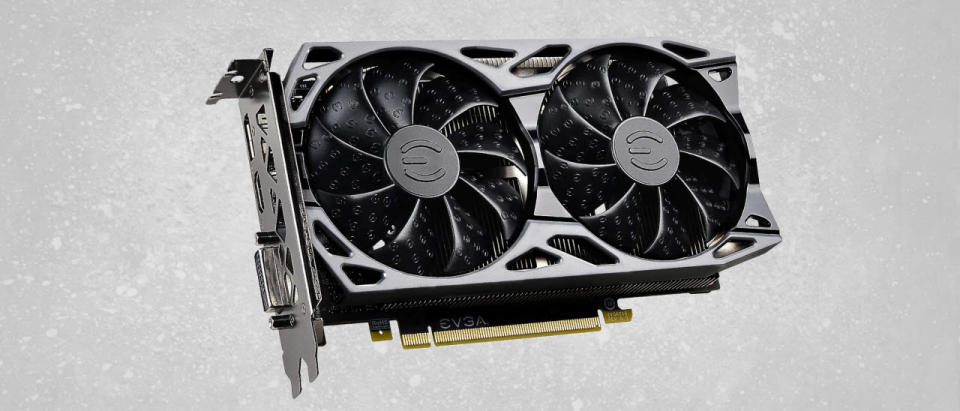
12. GeForce RTX 3050
Good 1080p Graphics With DXR and DLSS
GPU: Ampere GA106 | GPU Cores: 2560 | Boost Clock: 1,777 MHz | Video RAM: 8GB GDDR6 14 Gbps | TBP: 130 watts
Full RTX and DLSS feature set
Provides 8GB VRAM
Good 1080p performance
Slower than the RTX 2060
Also loses to RX 6600
Online prices remain inflated
Nvidia tried to create a "budget" RTX 30-series card with its GeForce RTX 3050, though the $250 recommended price still puts it firmly in the mainstream category. It's now available starting at $280, which is better than the launch prices but not as low as we'd like to see, considering it ended up being 7% slower than the previous generation RTX 2060 in our testing (see above).
In general, we'd rather pay for an RTX card than plunk down a similar amount of cash for a GeForce GTX 1660 Super or RX 5500 XT 8GB. In our testing, the RTX 3050 was about 15% faster than a GTX 1660 Super, plus it can legitimately run ray tracing games and it also supports DLSS. That's more than we can say for AMD's RX 6500 XT, which probably should have skipped RT support in exchange for more VRAM and bandwidth.
On the other hand, AMD's RX 6600 (above) was 30% faster in standard games and only 13% slower in DXR games, while costing $25 less than the cheapest 3050 we can find right now. Ideally, RTX 3050 would cost closer to $200 than $300, and we may yet see such prices. For now, AMD offers a better option and the RTX 2060 also looks better than the 3050. At least 3050 supplies aren't expected to dry up in the near future.
Read: Nvidia GeForce RTX 3050
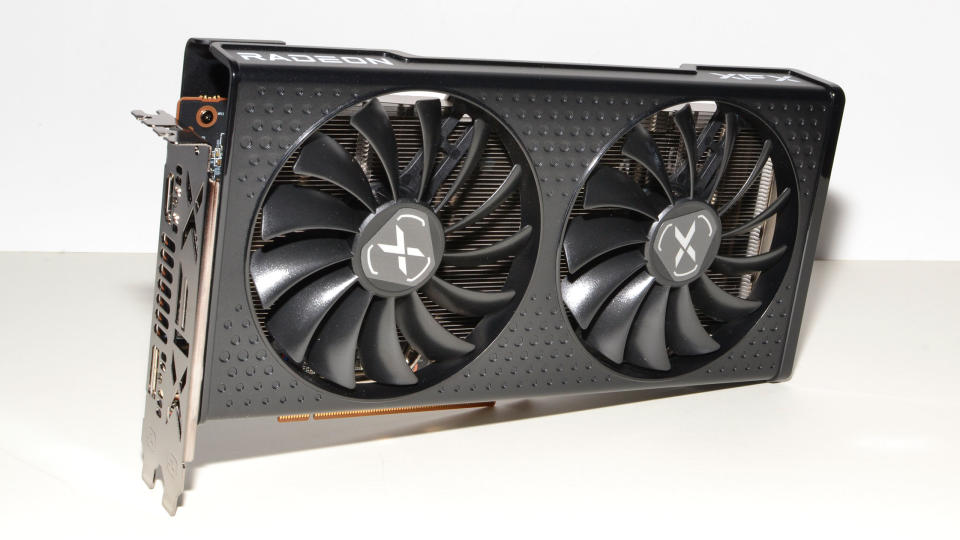
13. Radeon RX 6500 XT
Budget Gaming for Under $200
GPU: Navi 24 | GPU Cores: 1024 | Boost Clock: 2,815 MHz | Video RAM: 4GB GDDR6 18 Gbps | TBP: 107 watts
Handles 1080p medium
Actually affordable
Current generation architecture
4GB VRAM is limiting
Only two video ports
x4 PCIe link
Still needs a 6-pin power connector
Terrible RT performance
No video encoding hardware
The budget realm of GPUs often ends up going to older hardware, but the Radeon RX 6500 XT at least uses AMD's RDNA 2 GPU. Except, the Navi 24 chips really got cut down on the chopping block, with only a 64-bit memory interface, 16MB Infinity Cache, an x4 PCIe link, no video encoding support, and only two display outputs. That's a lot of potentially interesting features that got hacked off.
Still, if price is your driving concern, the RX 6500 XT starts at $170 on Amazon, which makes it less expensive than most other options. We'd encourage most gamers to try saving up for one of the above GPUs like the RX 6600, but for under $200 your only other choices are cards like the GTX 1650 Super, GTX 1650, or Intel Arc A380 — pick your poison.
Intel's Arc A380 actually represents a viable alternative, with substantially better video codec support, 50% more memory, and potentially more capable ray tracing and other hardware. Intel continues to work on its drivers, and if you tend to stick with popular games we'd give the A380 some serious thought — assuming it comes back in stock.
The RX 6500 XT mostly wins our sub-$200 budget recommendation by default. We'd much rather have a GTX 1660-series card, RTX 2060, or even the previous generation RX 5500 XT 8GB, but those all cost more than $200 — unless you shop on eBay, but buying a used graphics card represents a risk, with many miners likely offloading cards that have potentially been used hard for the past two years.
Read: AMD Radeon RTX 6500 XT Review
How We Test the Best Graphics Cards
Tom's Hardware 2022 GPU Testbed
Intel Core i9-12900K
MSI Pro Z690-A WiFi DDR4
Corsair 2x16GB DDR4-3600 CL16
Crucial P5 Plus 2TB
Cooler Master MWE 1250 V2 Gold
Cooler Master PL360 Flux
Cooler Master HAF500
Windows 11 Pro 64-bit
Determining pure graphics card performance is best done by eliminating all other bottlenecks — as much as possible, at least. Our 2022 graphics card testbed consists of a Core i9-12900K CPU, MSI Z690 DDR4 motherboard, 32GB Corsair DDR4-3600 CL16 memory, and Crucial P5 Plus 2TB SSD, with a Cooler Master PSU, case, and CPU cooler.
We test across the three most common gaming resolutions, 1080p, 1440p, and 4K, using 'medium' and 'ultra' settings. Where possible, we use 'reference' cards for all of these tests, like Nvidia's Founders Edition models and AMD's reference designs. Most midrange and lower GPUs do not have reference models, however, and in some cases we only have factory overclocked cards for testing. We do our best to select cards that are close to the reference specs in such cases.
For each graphics card, we follow the same testing procedure. We run one pass of each benchmark to "warm up" the GPU after launching the game, then run at least two passes at each setting/resolution combination. If the two runs are basically identical (within 0.5% or less difference), we use the faster of the two runs. If there's more than a small difference, we run the test at least twice more to determine what "normal" performance is supposed to be.
We also look at all the data and check for anomalies, so for example RTX 3070 Ti, RTX 3070, and RTX 3060 Ti all generally going to perform within a narrow range — 3070 Ti is about 5% faster than 3070, which is about 5% faster than 3060 Ti. If we see games where there are clear outliers (i.e. performance is more than 10% higher for the cards just mentioned), we'll go back and retest whatever cards are showing the anomaly and figure out what the "correct" result would be.
Due to the length of time required for testing each GPU, updated drivers and game patches inevitably come out that can impact performance. We periodically retest a few sample cards to verify our results are still valid, and if not, we go through and retest the affected game(s) and GPU(s). We may also add games to our test suite over the coming year, if one comes out that is popular and conducive to testing — see our what makes a good game benchmark for our selection criteria.
Choosing Among the Best Graphics Cards
We've provided a dozen options for the best graphics cards, recognizing that there's plenty of potential overlap. The latest generation GPUs consist of Nvidia's Ampere architecture cards and AMD's RDNA2 architecture offerings, and the Intel Arc Alchemist GPUs should arrive in the next couple of months. Conveniently, Arc Alchemist, RDNA2, and Ampere all support the same general features (DirectX 12 Ultimate and ray tracing), though Arc and RTX cards also have additional tensor core hardware.
We've listed the best graphics cards that are available right now, along with their current online prices, which we track in our GPU prices guide. With many cards now only costing 25% more than MSRP, plenty of people seem ready to upgrade, and supply also looks to be improving. Whether that will continue until the next-gen GPUs arrive remains to be seen.
Our advice: Don't pay more today for yesterday's hardware. If you want an RTX 30-series or RX 6000-series graphics card, be patient and you'll eventually be able to buy one at close to the official MSRP. At this point, you might just give Ampere and RDNA2 a pass and wait for Ada and RDNA3.
If your main goal is gaming, you can't forget about the CPU. Getting the best possible gaming GPU won't help you much if your CPU is underpowered and/or out of date. So be sure to check out the Best CPUs for Gaming page, as well as our CPU Benchmark hierarchy to make sure you have the right CPU for the level of gaming you're looking to achieve.
Our current recommendations reflect the changing GPU market, factoring in all of the above details. The GPUs are ordered using subjective rankings, taking into account performance, price, features, and efficiency, so slightly slower cards may end up higher on our list.
Additional Shopping Tips
When buying a graphics card, consider the following:
• Resolution: The more pixels you're pushing, the more performance you need. You don't need a top-of-the-line GPU to game at 1080p.
• PSU: Make sure that your power supply has enough juice and the right 6- and/or 8-pin connector(s). For example, Nvidia recommends a 550-watt PSU for the RTX 3060, and you'll need at least an 8-pin connector and possibly a 6-pin PEG connector as well.
• Video Memory: A 4GB card is the minimum right now, 6GB models are better, and 8GB or more is strongly recommended. A few games can now use 12GB of VRAM, though they're the exception rather than the rule.
• FreeSync or G-Sync? Either variable refresh rate technology will synchronize your GPU's frame rate with your screen's refresh rate. Nvidia supports G-Sync and G-Sync Compatible displays (for recommendations, see our Best Gaming Monitors list), while AMD's FreeSync tech works with Radeon cards.
• Ray Tracing, DLSS, and FSR: The latest graphics cards support ray tracing, which can be used to enhance the visuals. DLSS provides intelligent upscaling and anti-aliasing to boost performance with similar image quality, but it's only on Nvidia RTX cards. AMD's FSR works on virtually any GPU and also provides upscaling and enhancement, but on a different subset of games.
Graphics Cards Performance Results
Our current test suite of games consists of eight titles. The data in the following charts is from testing conducted during the past several months. Only the fastest cards are tested at 1440p and 4K, but we do our best to test everything at 1080p medium and ultra.
AMD's FSR has now been out for about a year now, with FSR 2.0 having just launched. Nvidia's DLSS in contrast has been around for a few years and has decent uptake. None of the games in our core suite of benchmarks support FSR, so we're running at native resolution for all of these tests. We have a separate article looking at FSR and DLSS, and the bottom line is that DLSS improves performance with less compromise to image quality, but FSR works on any GPU. The newer FSR 2.0 does a lot to bridge the gap, but DLSS has a big lead in game support.
The charts below contain all the current generation RTX 30-series and RX 6000-series, plus previous generation GPUs where applicable (meaning, non-RT cards can't run our DXR benchmarks). Our GPU benchmarks hierarchy contains additional results for those who are interested, along with performance testing from our 2020-2021 suite running on a Core i9-9900K. The charts are color coded with AMD in red/grey and Nvidia in blue/black to make it easier to see what's going on.
The following charts are up to date as of October 18, 2022. All current generation and previous generation GPUs are included.
Best Graphics Cards — 1080p Medium
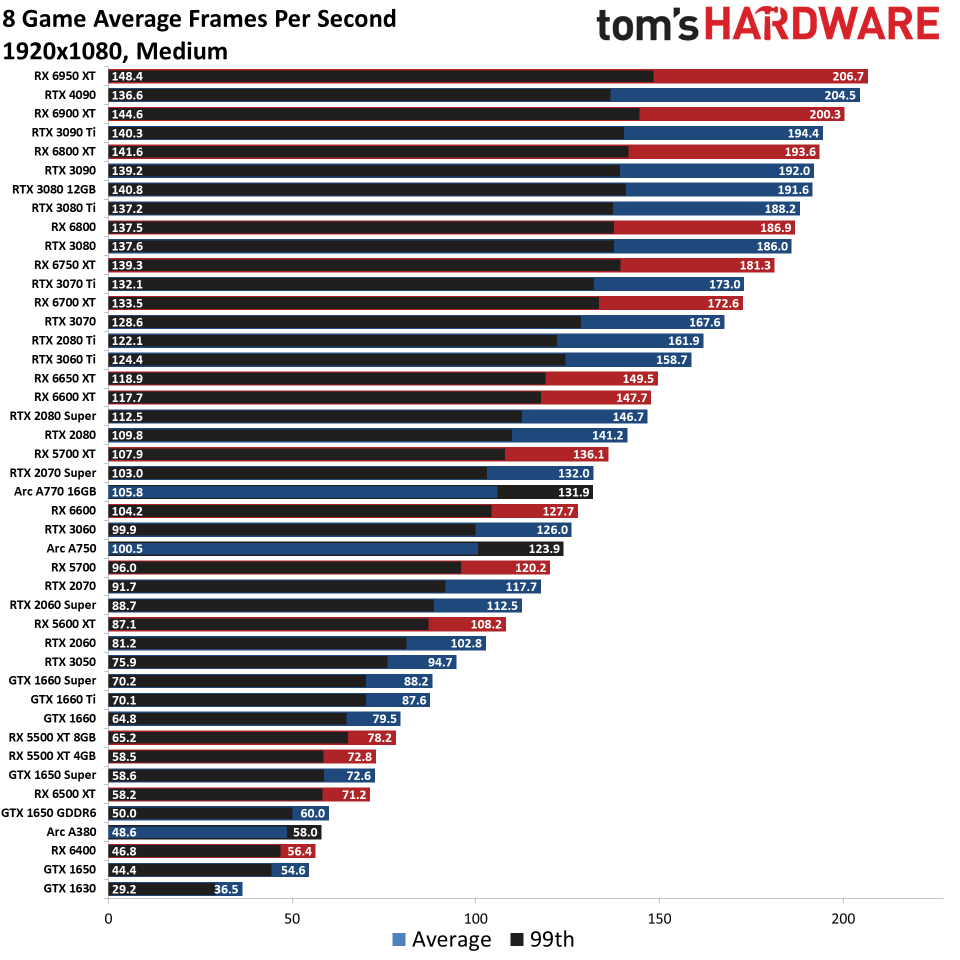
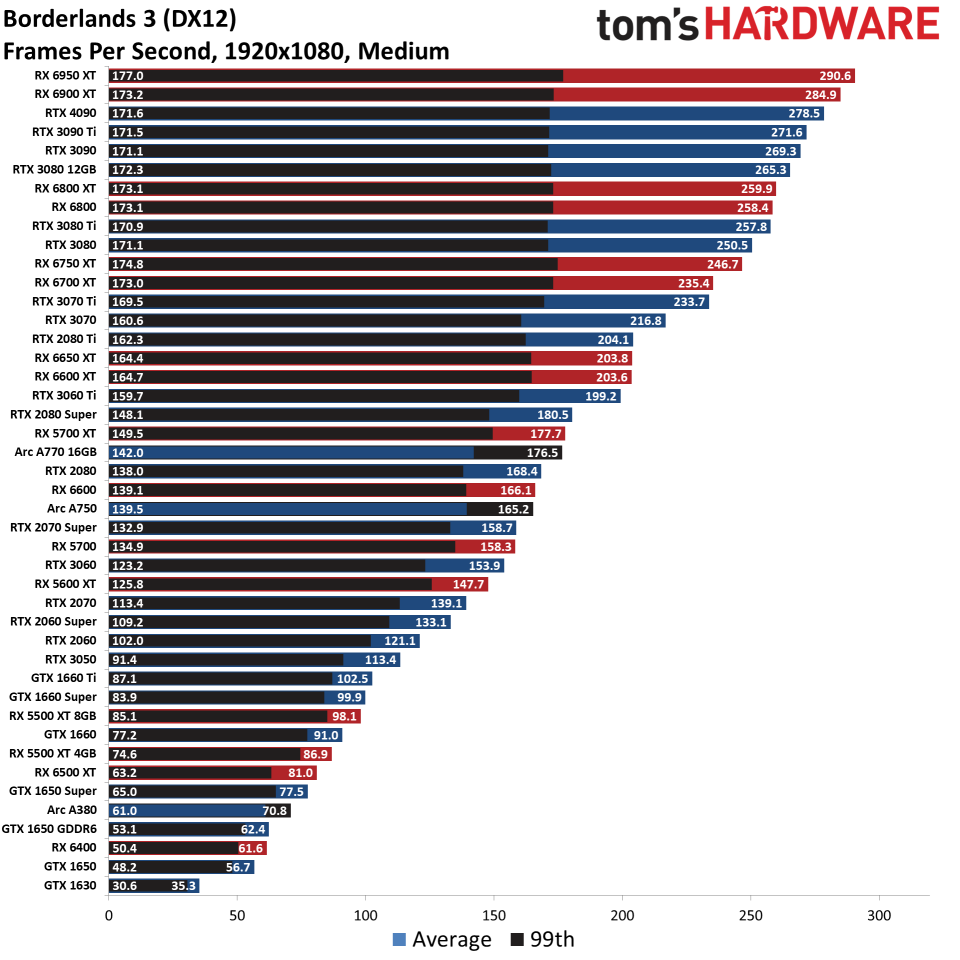
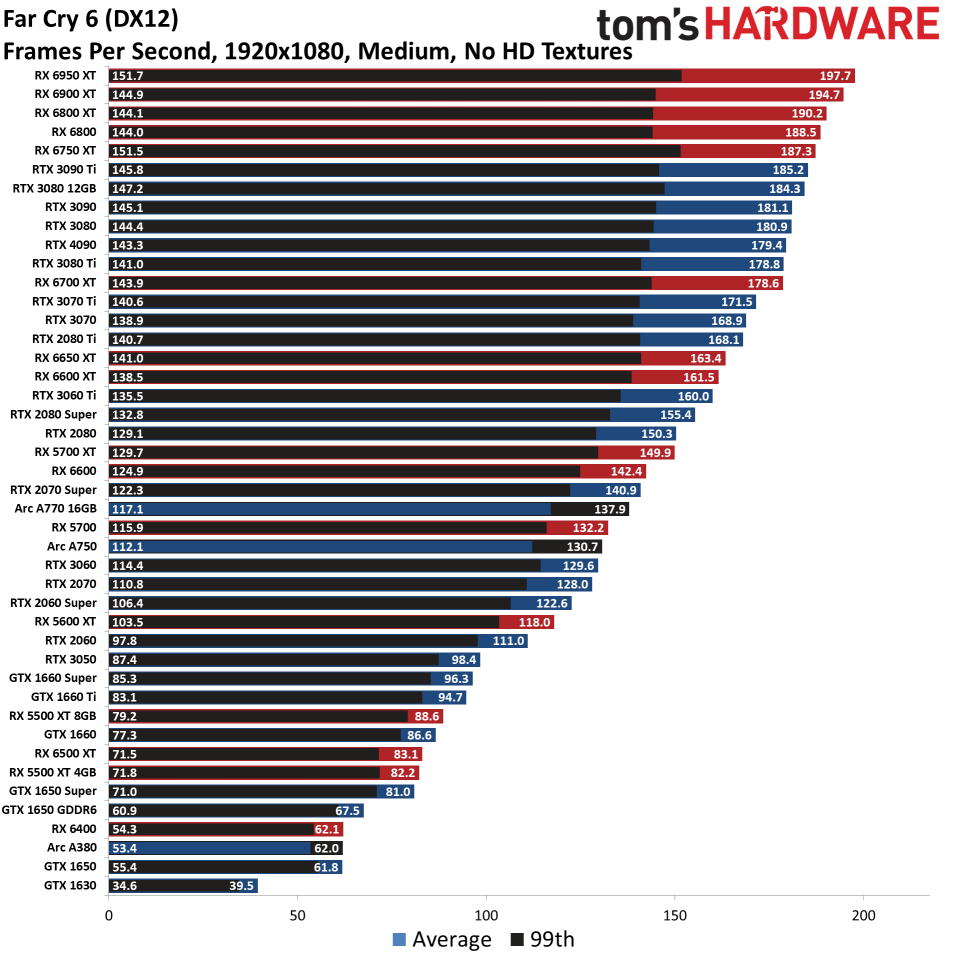
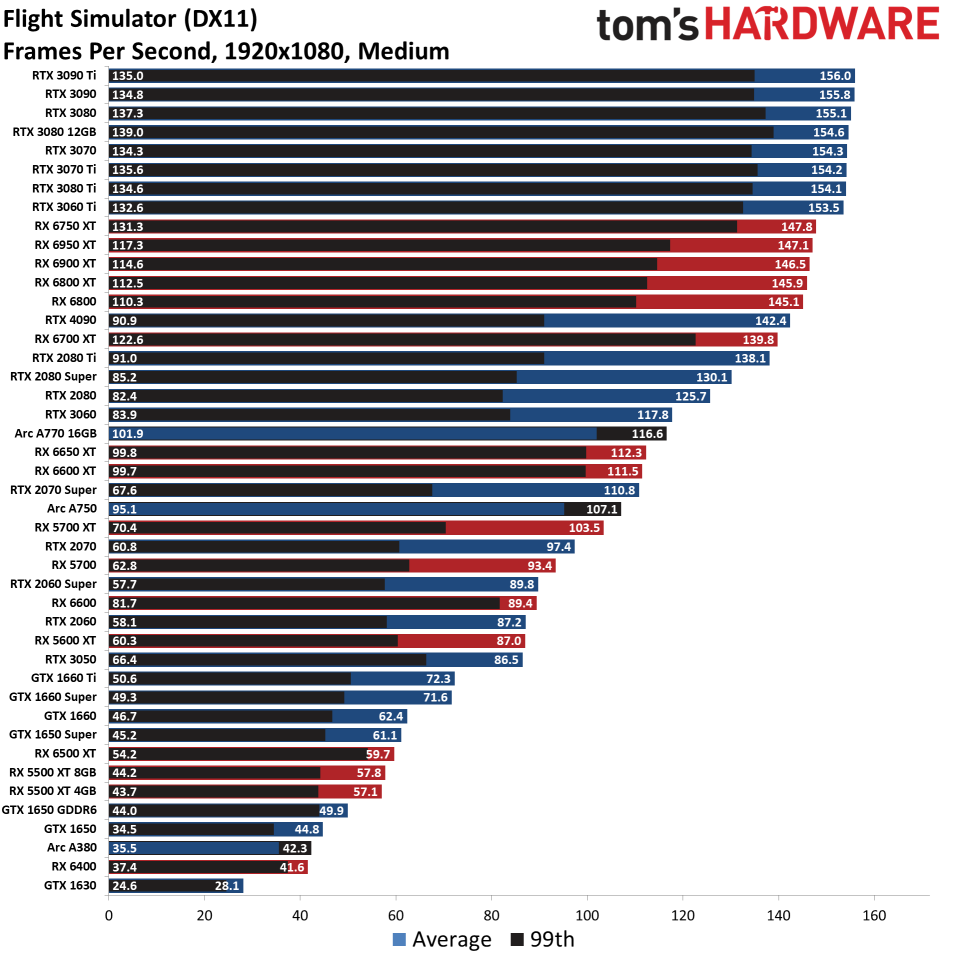

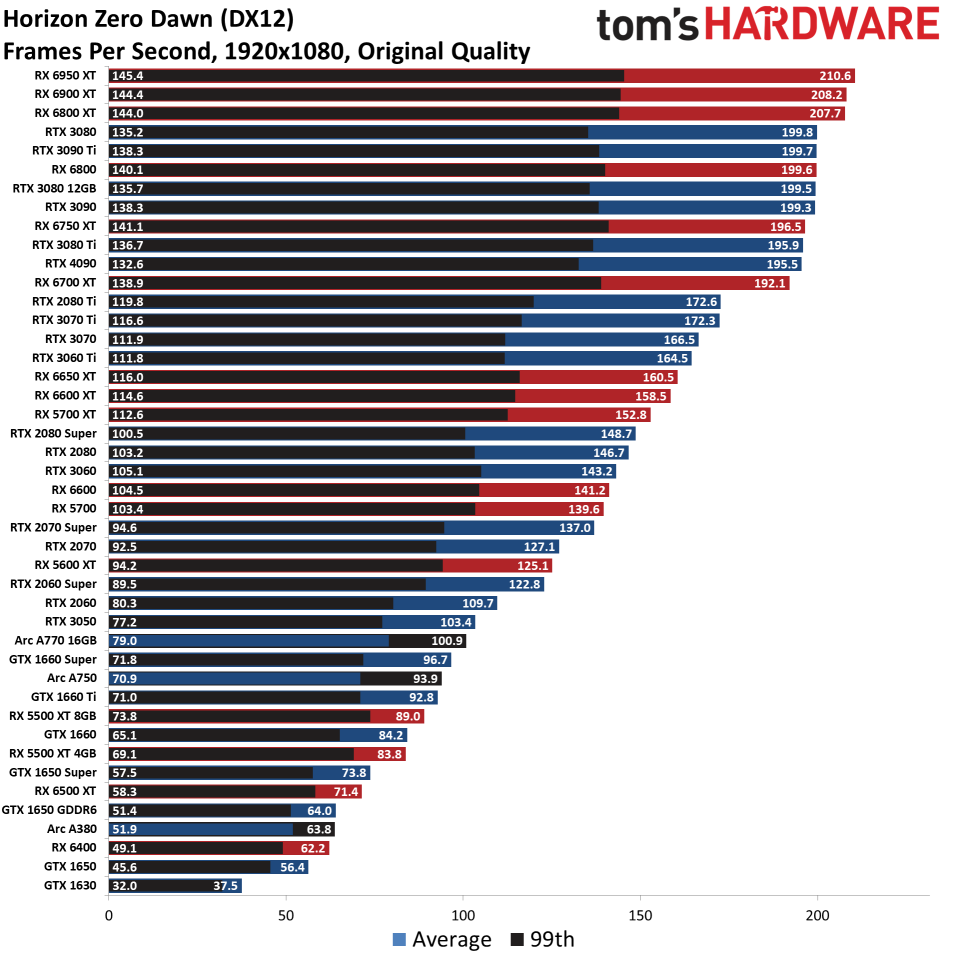
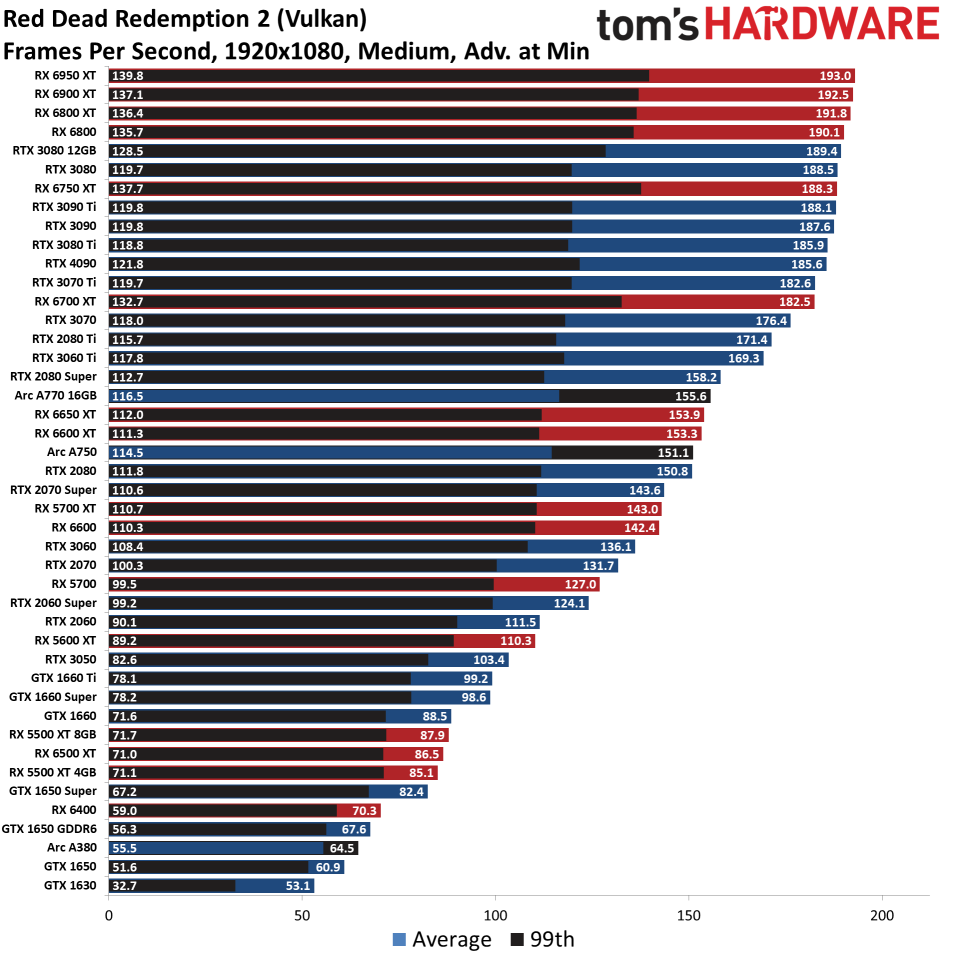
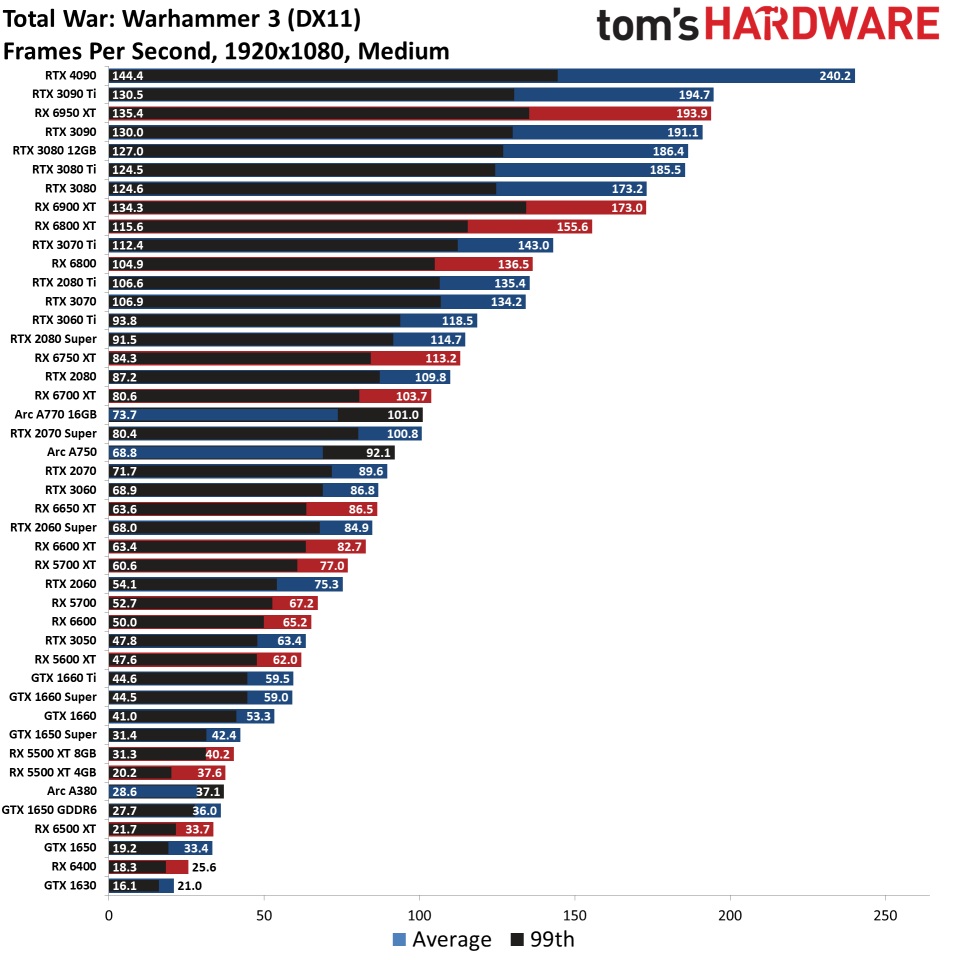
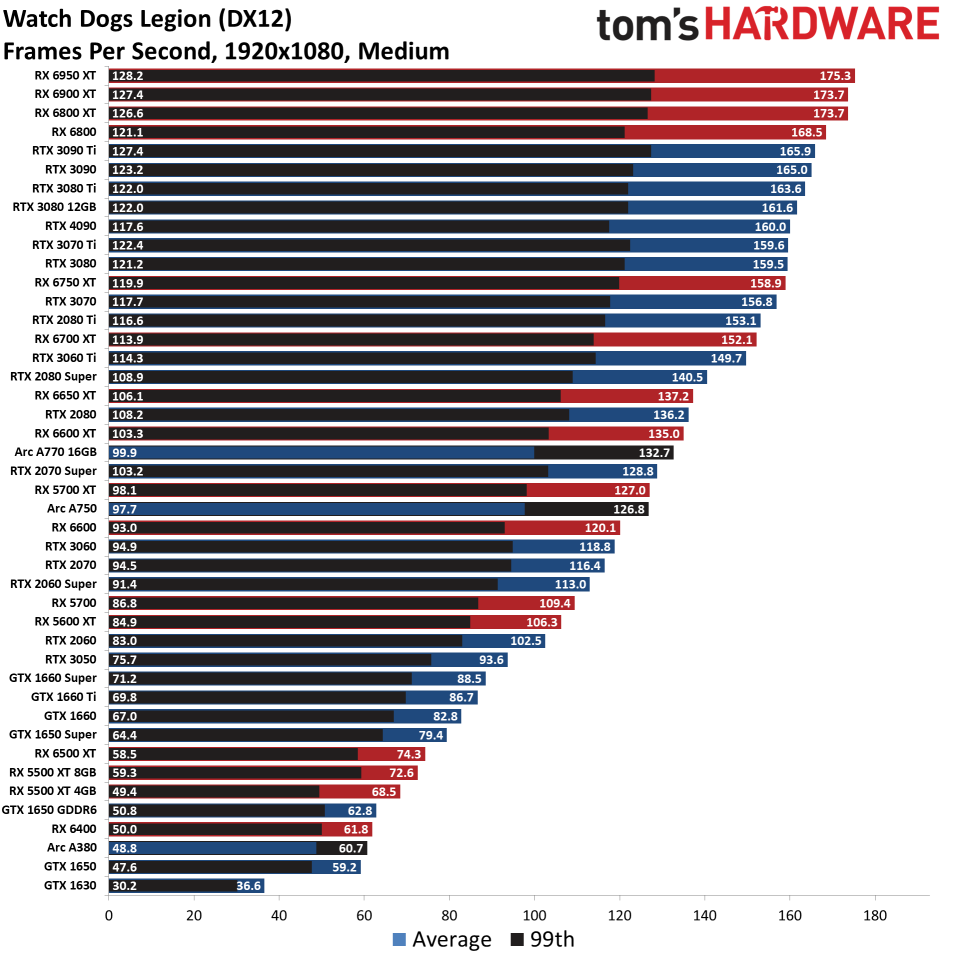
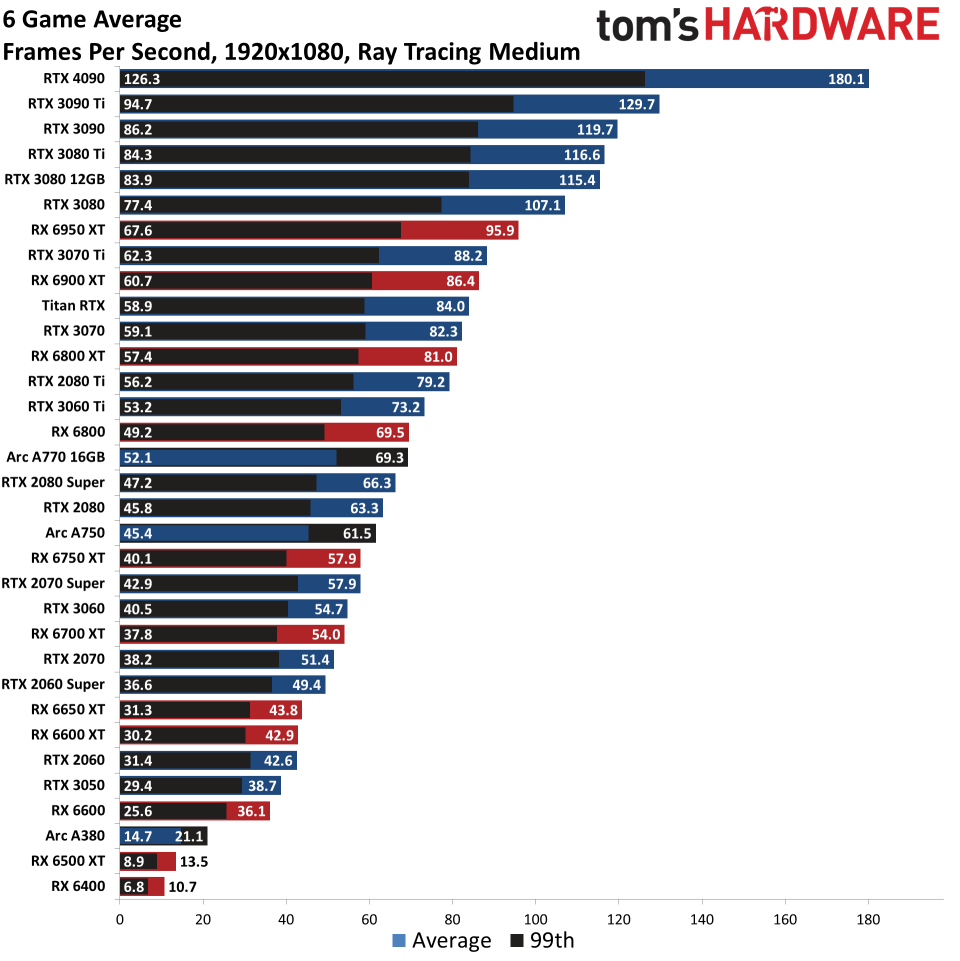
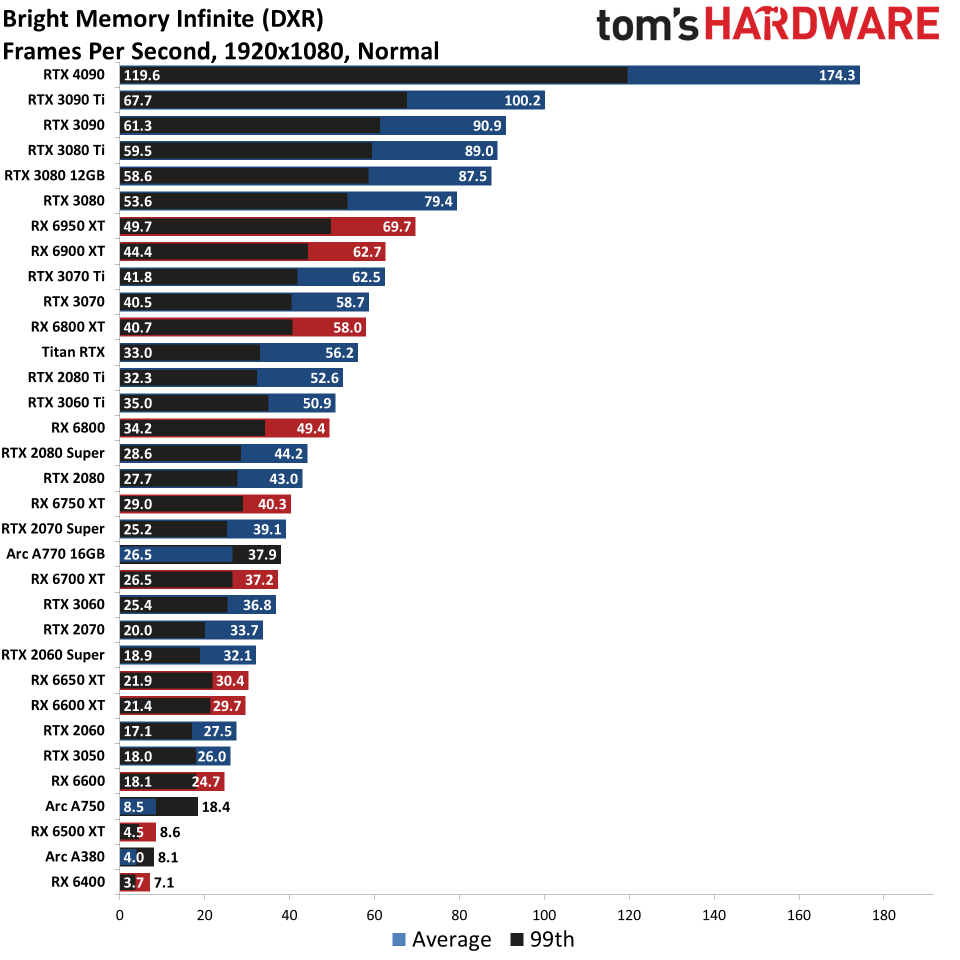
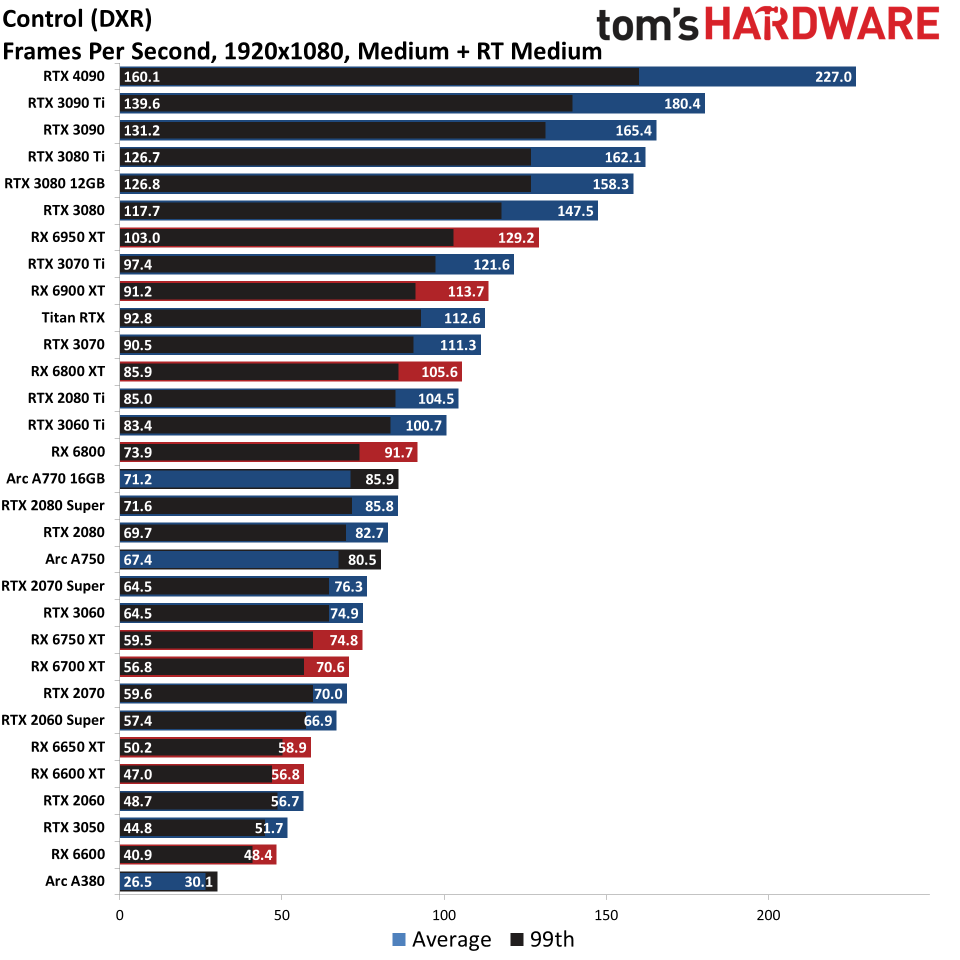
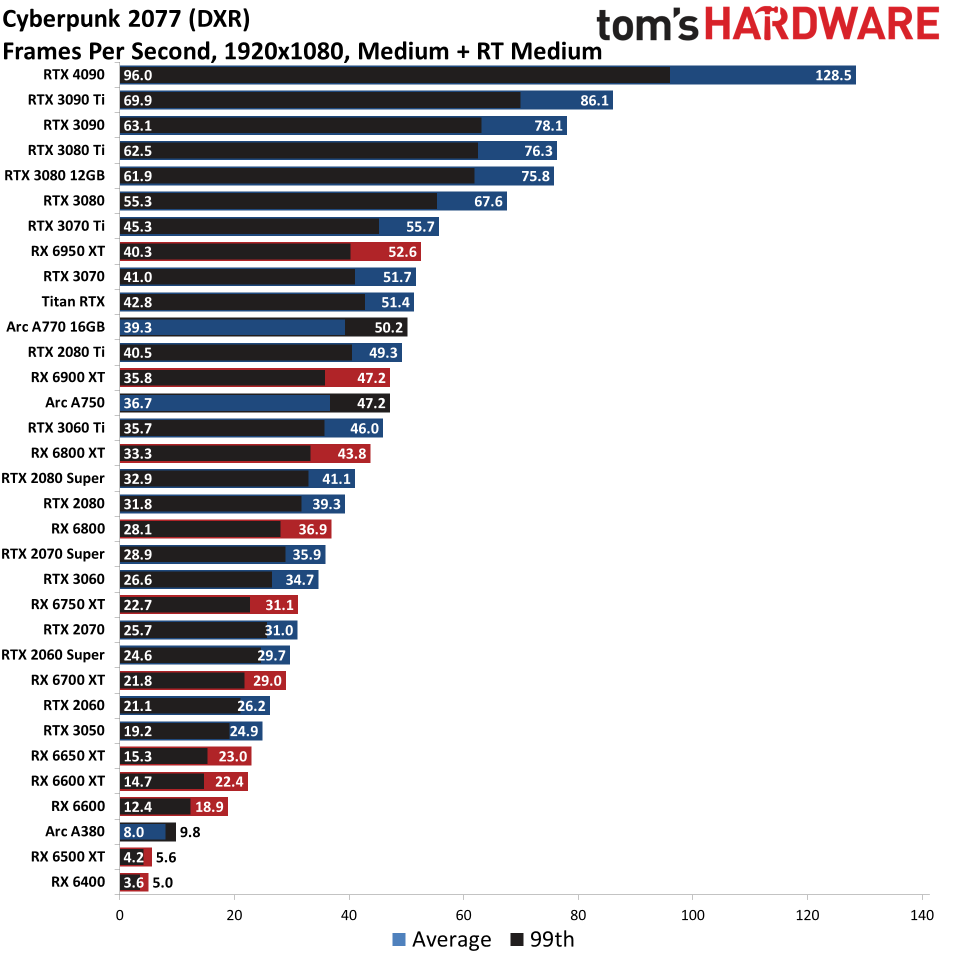
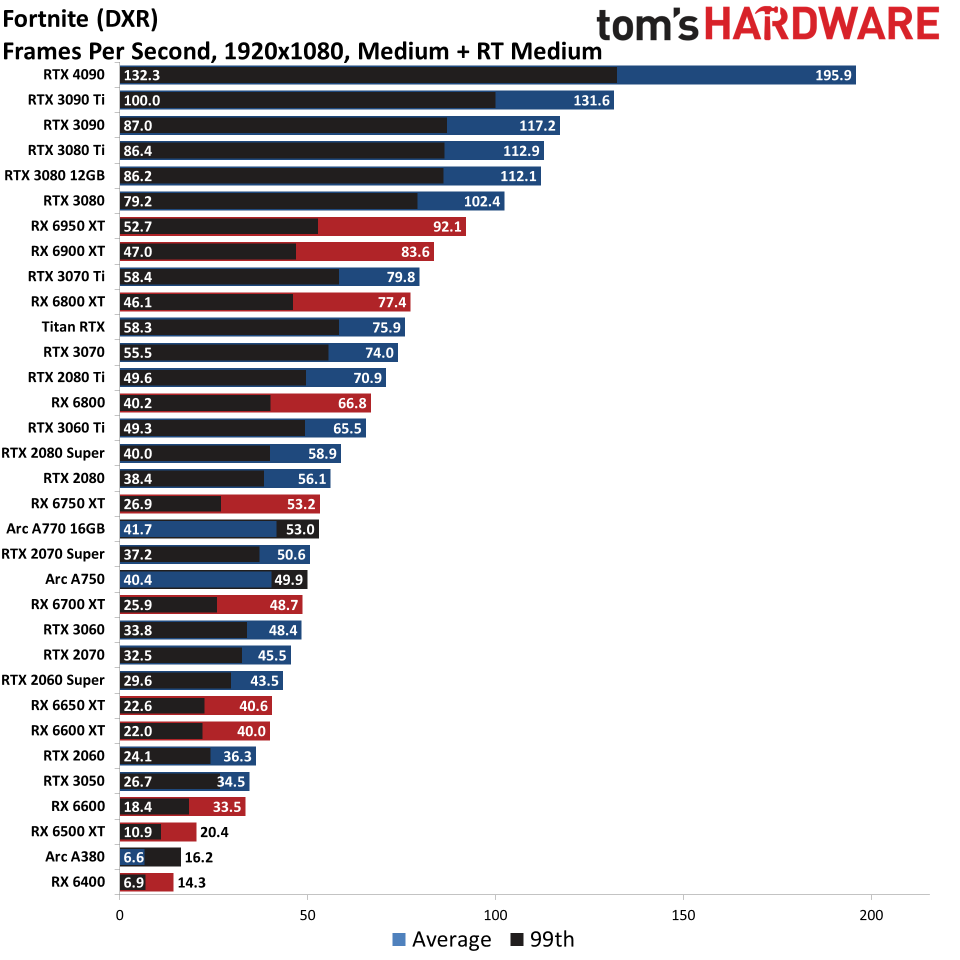
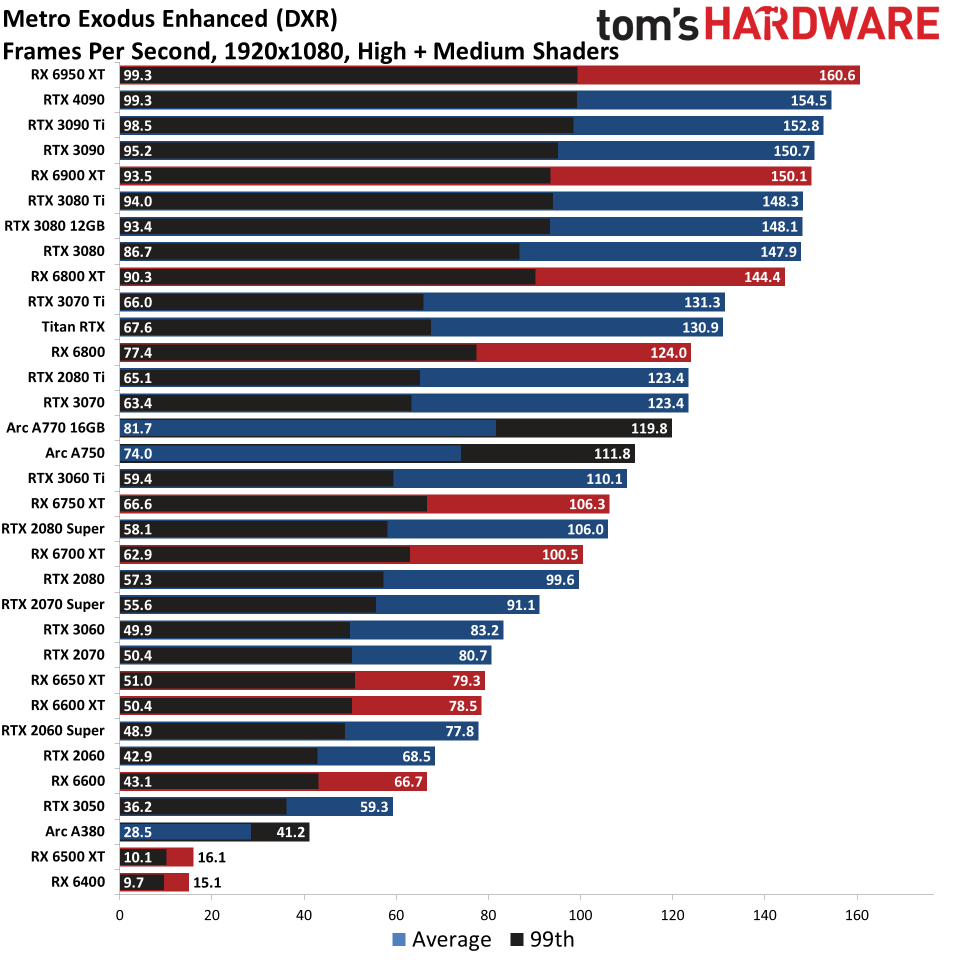
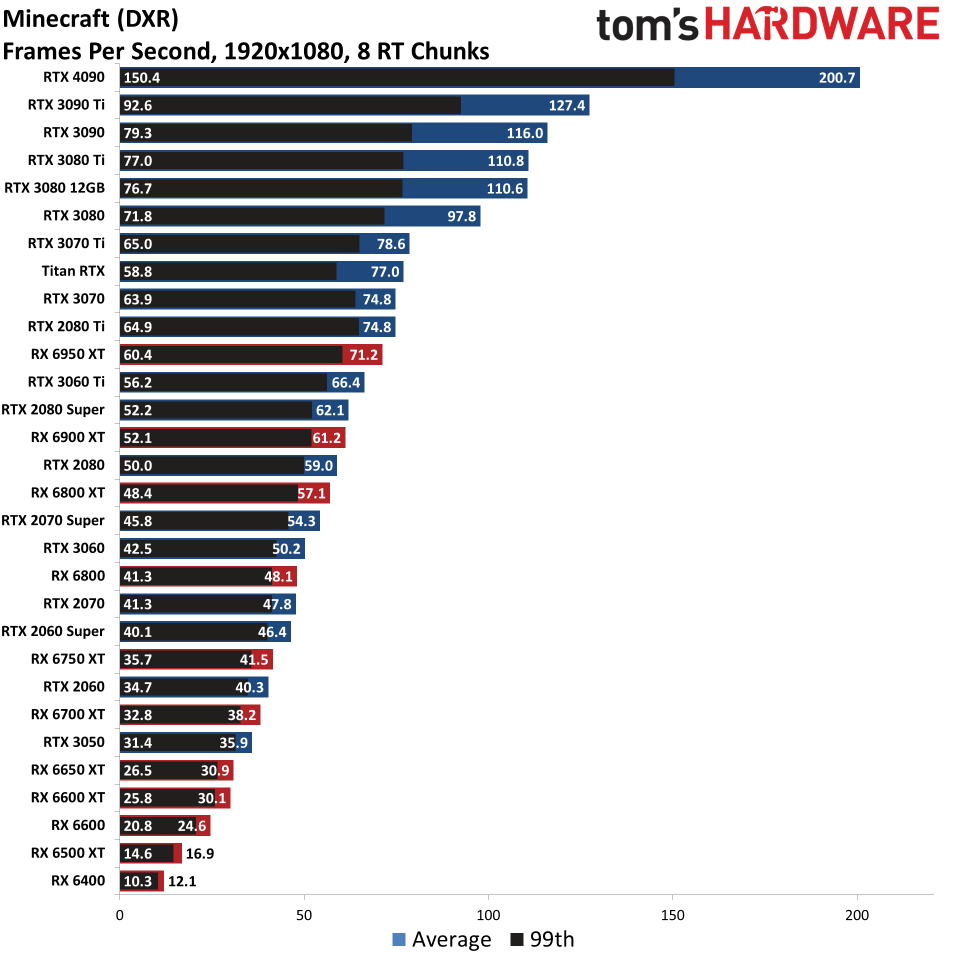
Best Graphics Cards — 1080p Ultra
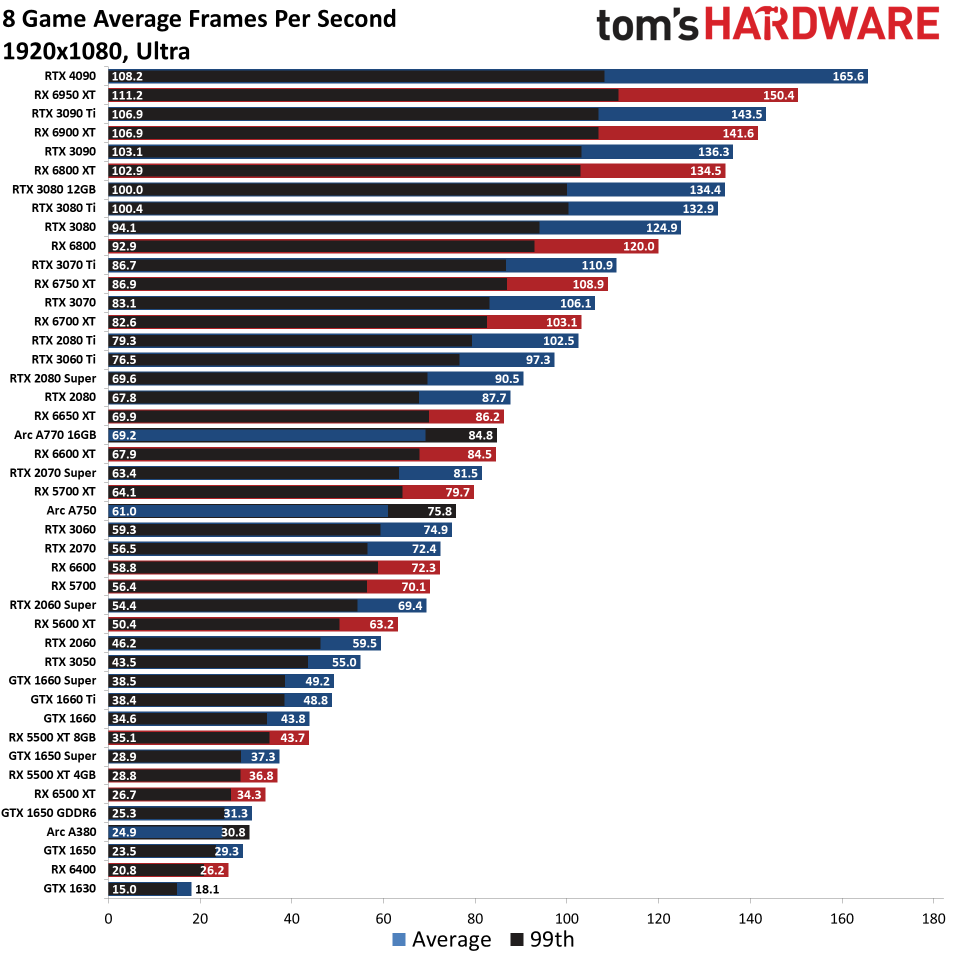
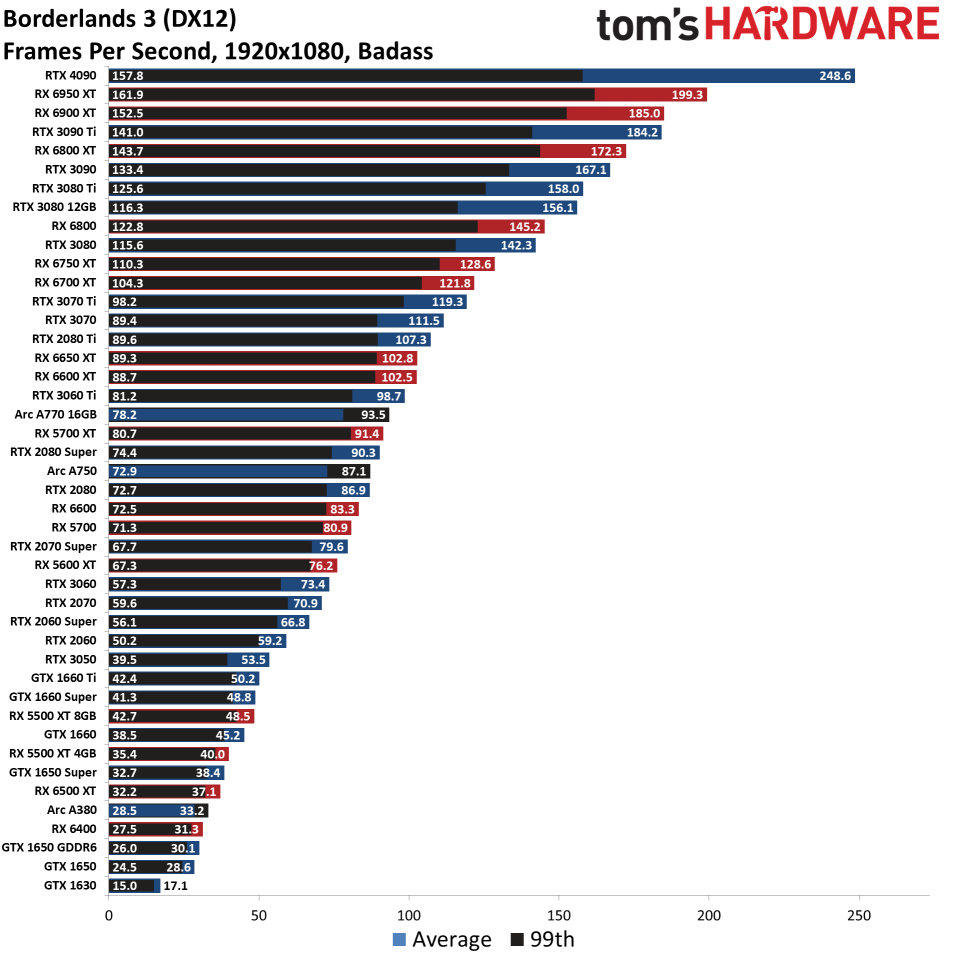
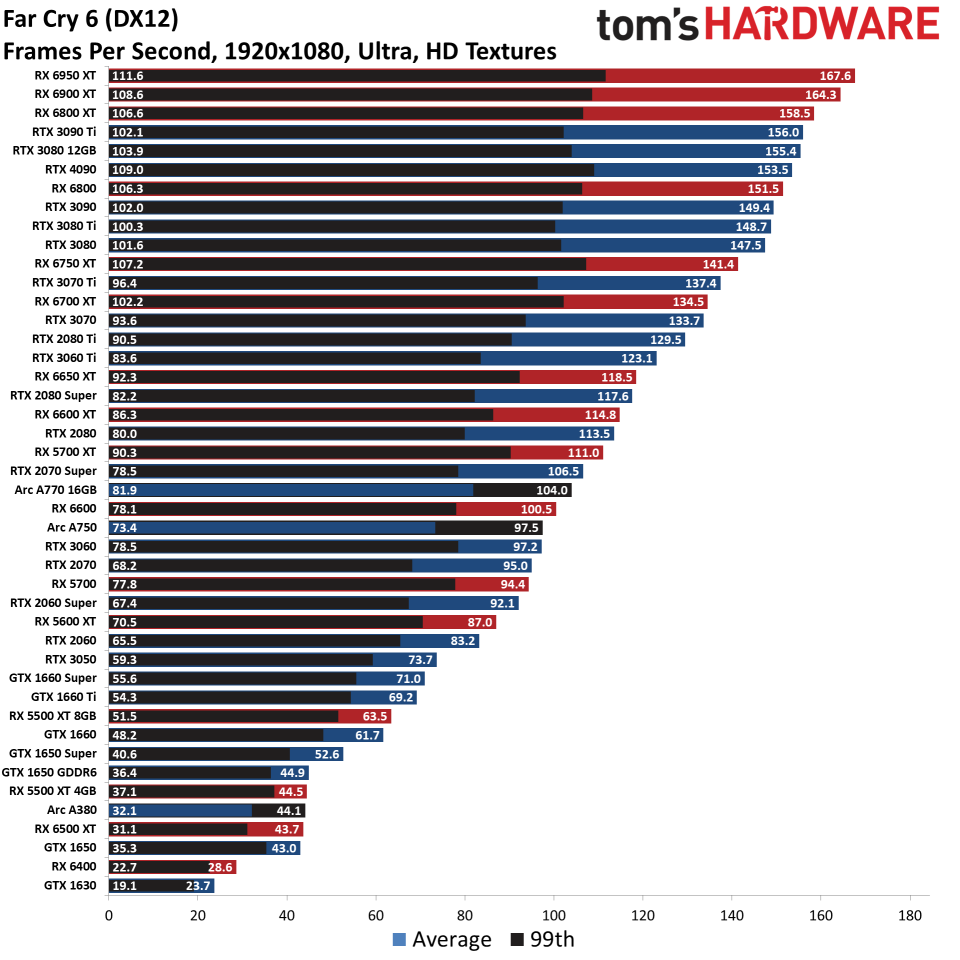
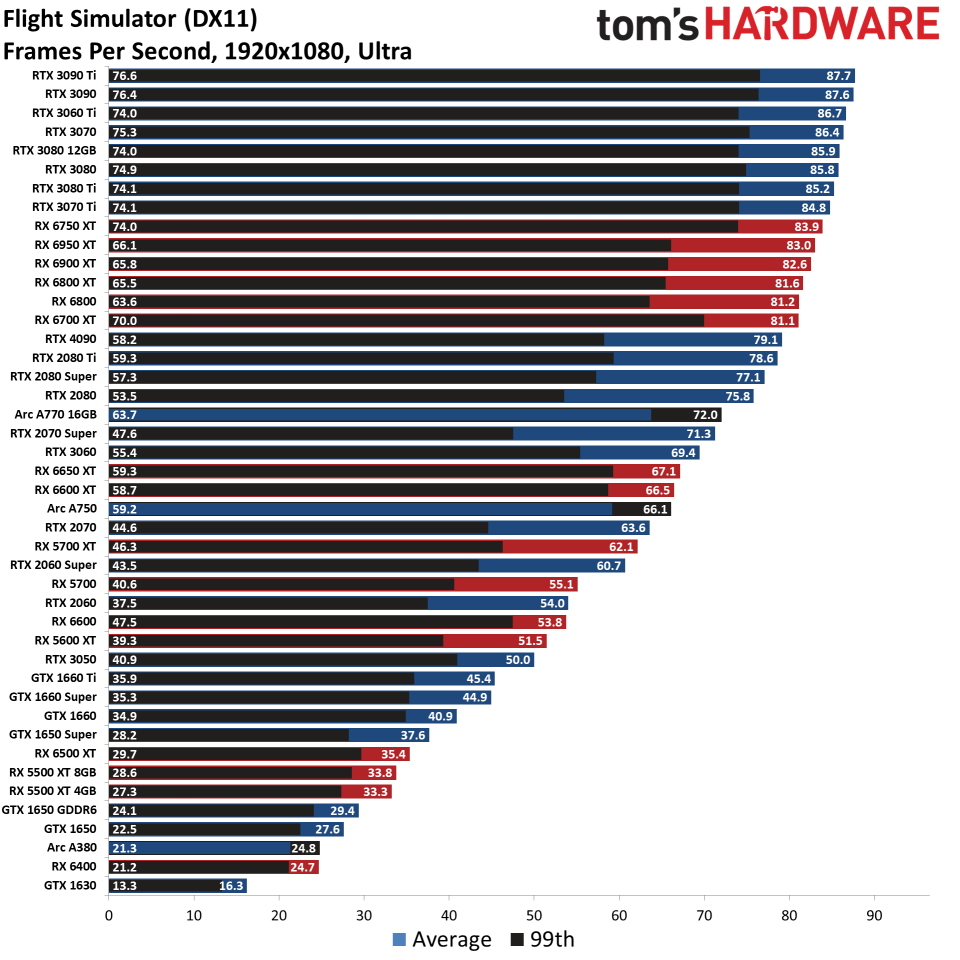
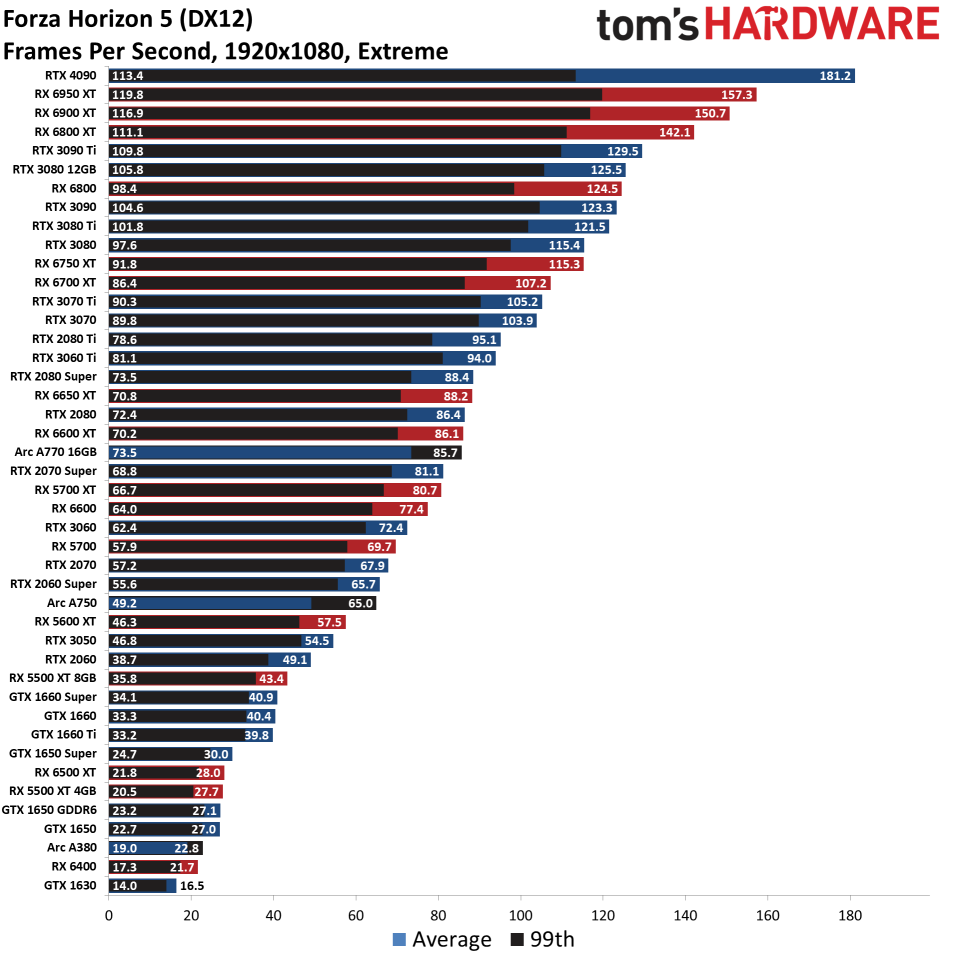
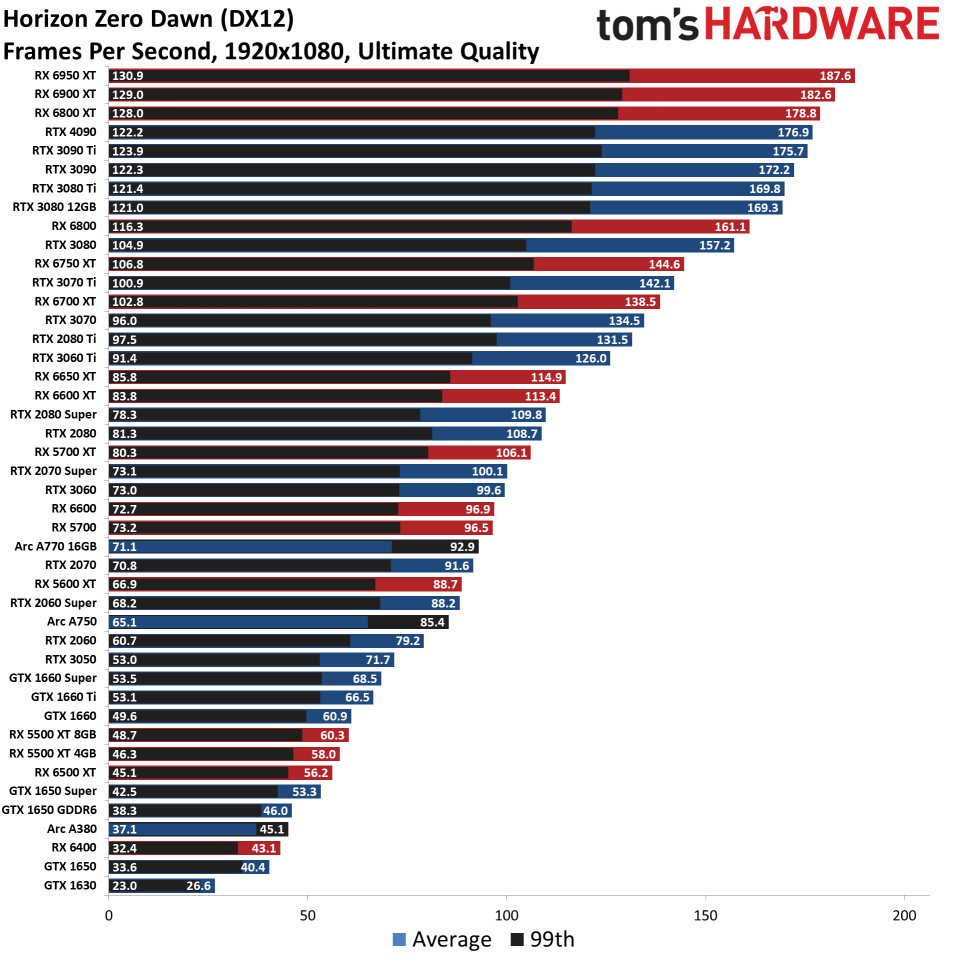
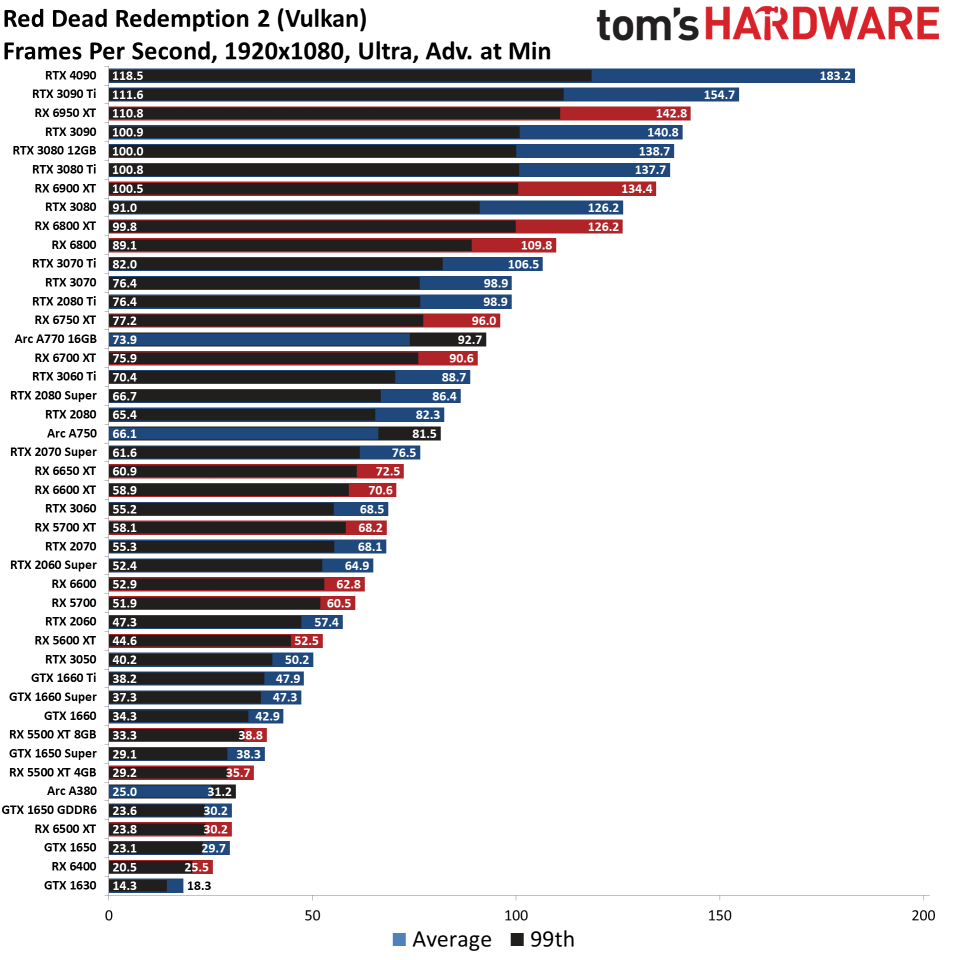
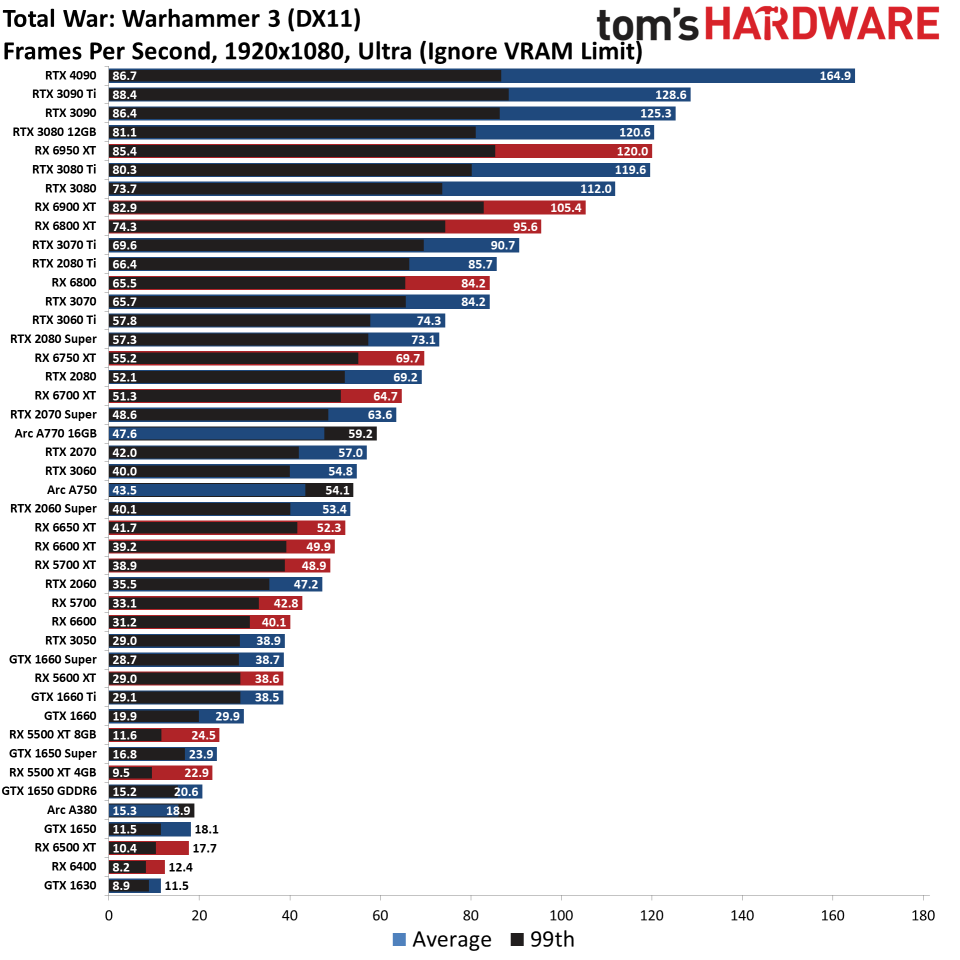
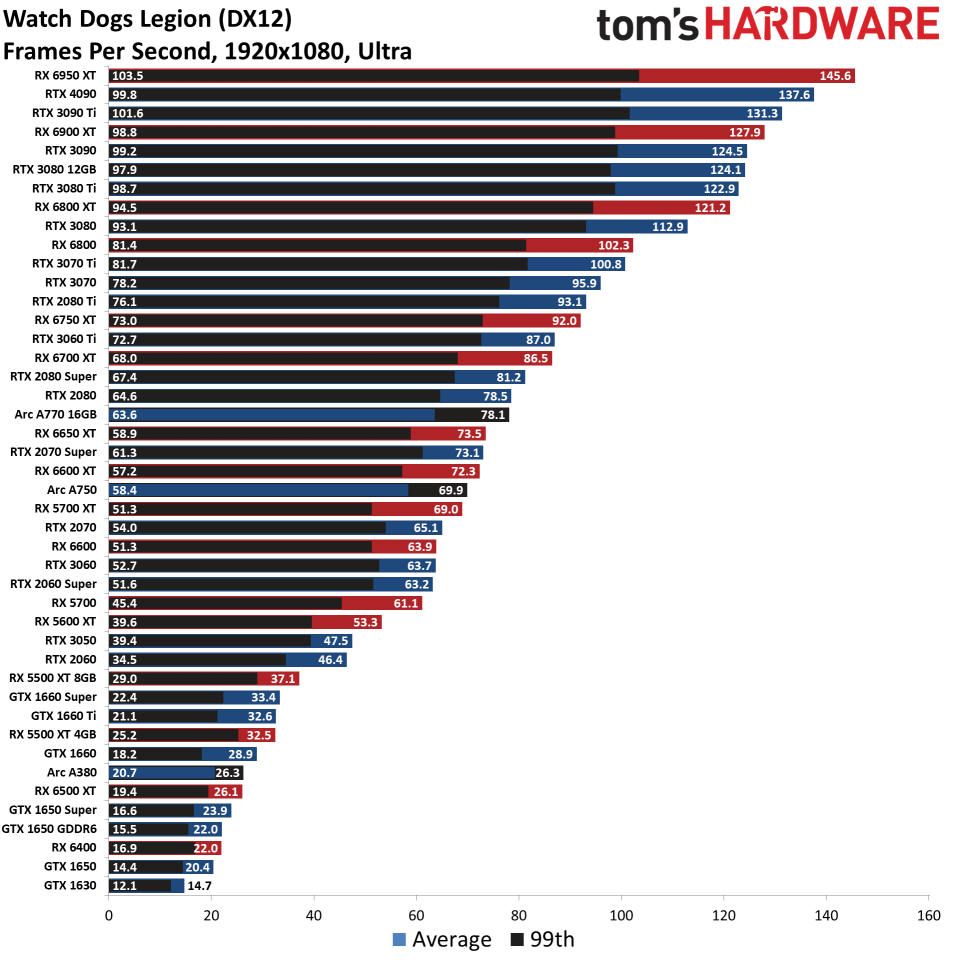
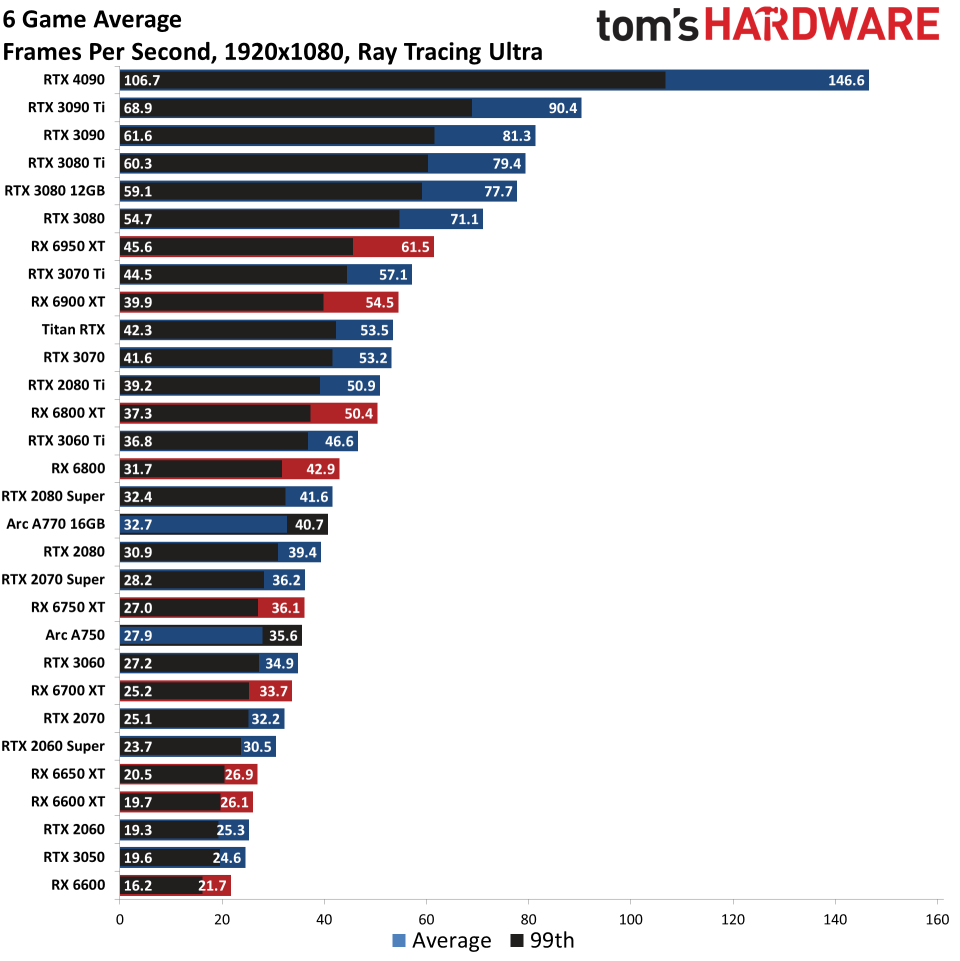
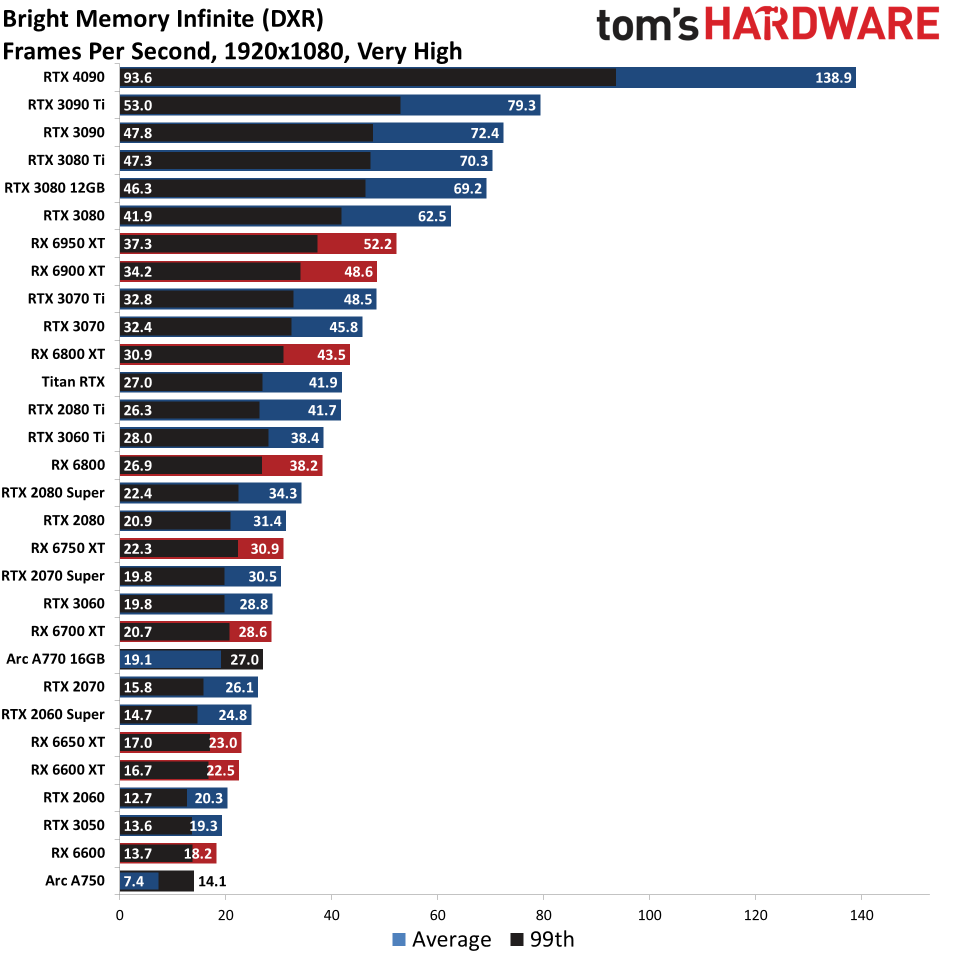
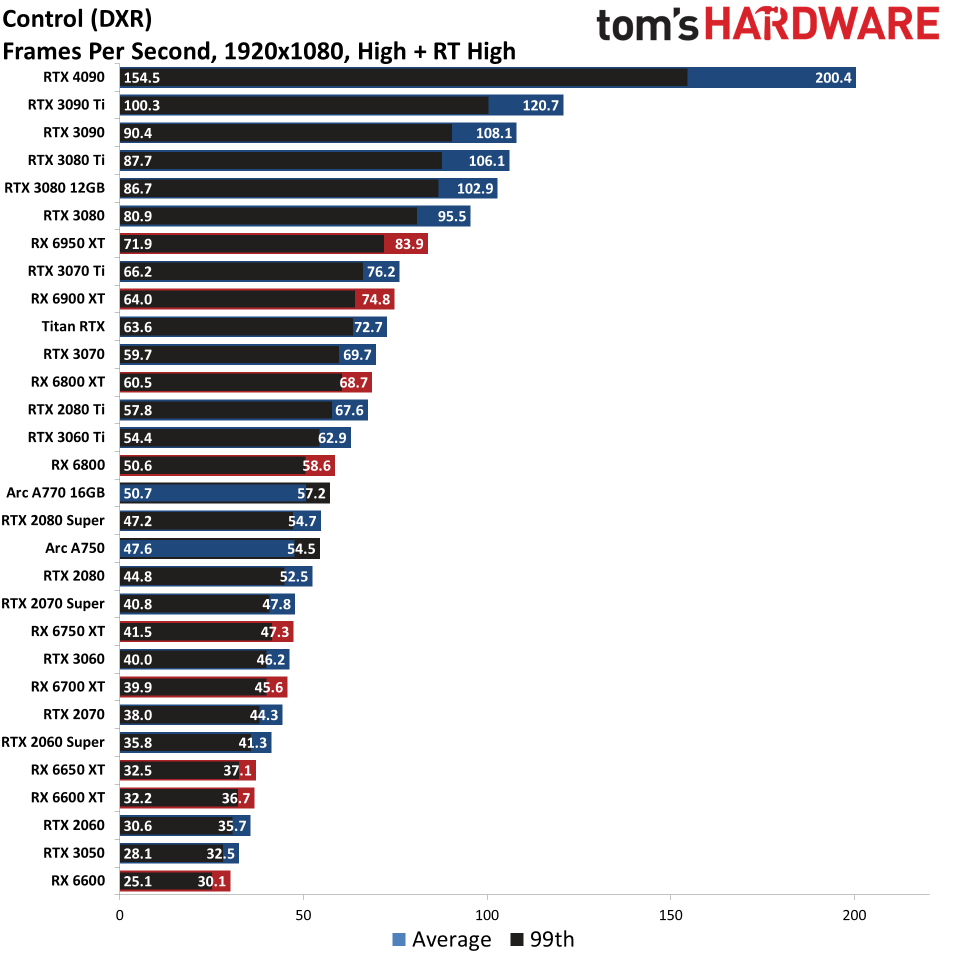
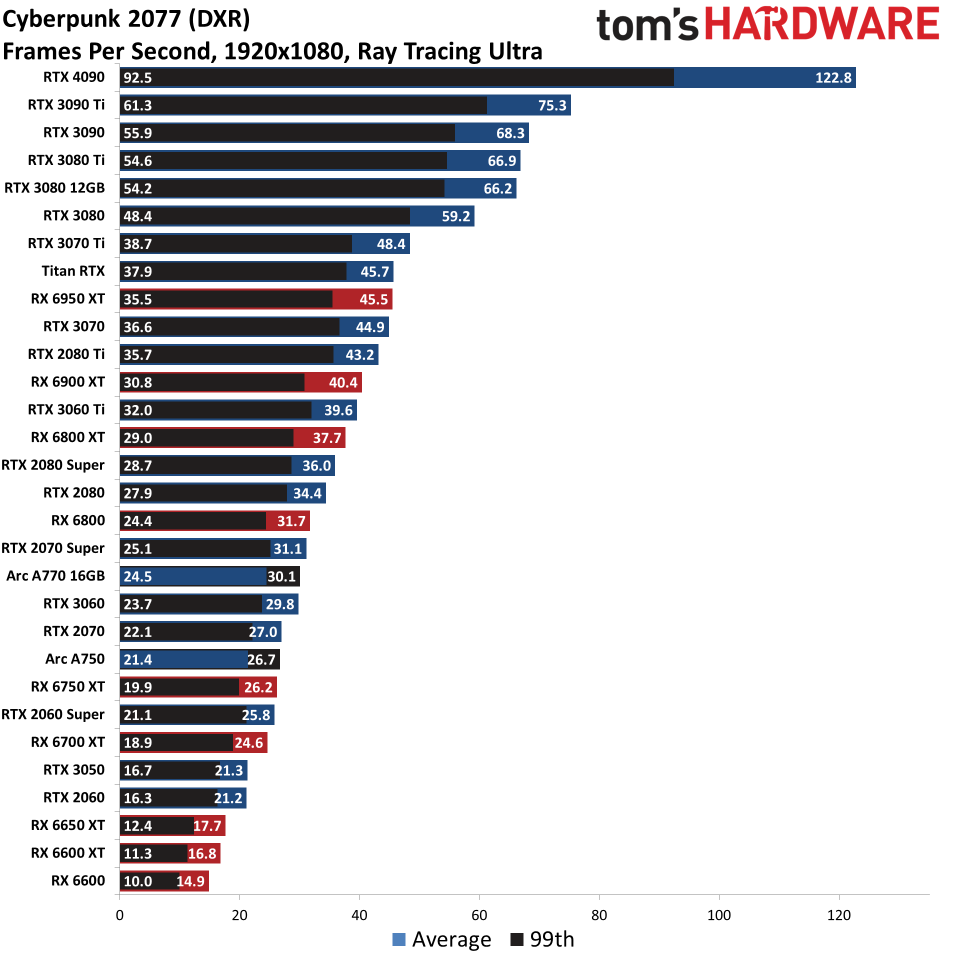
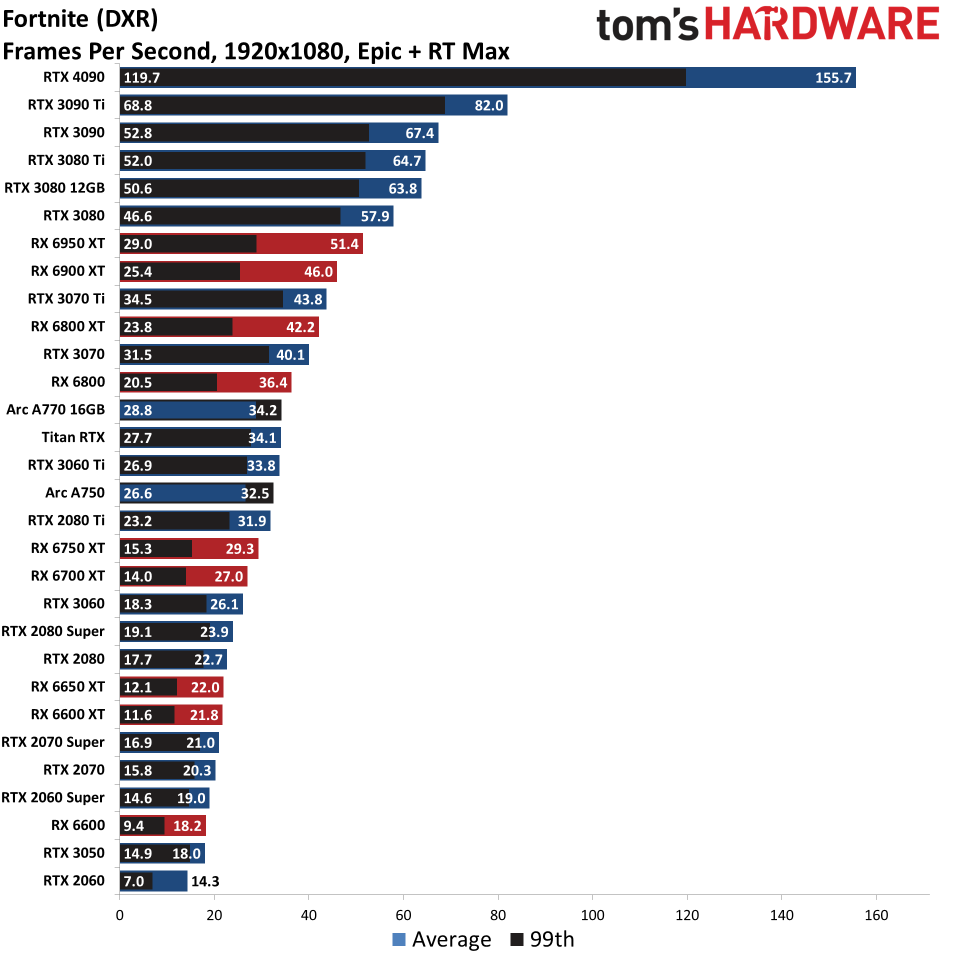
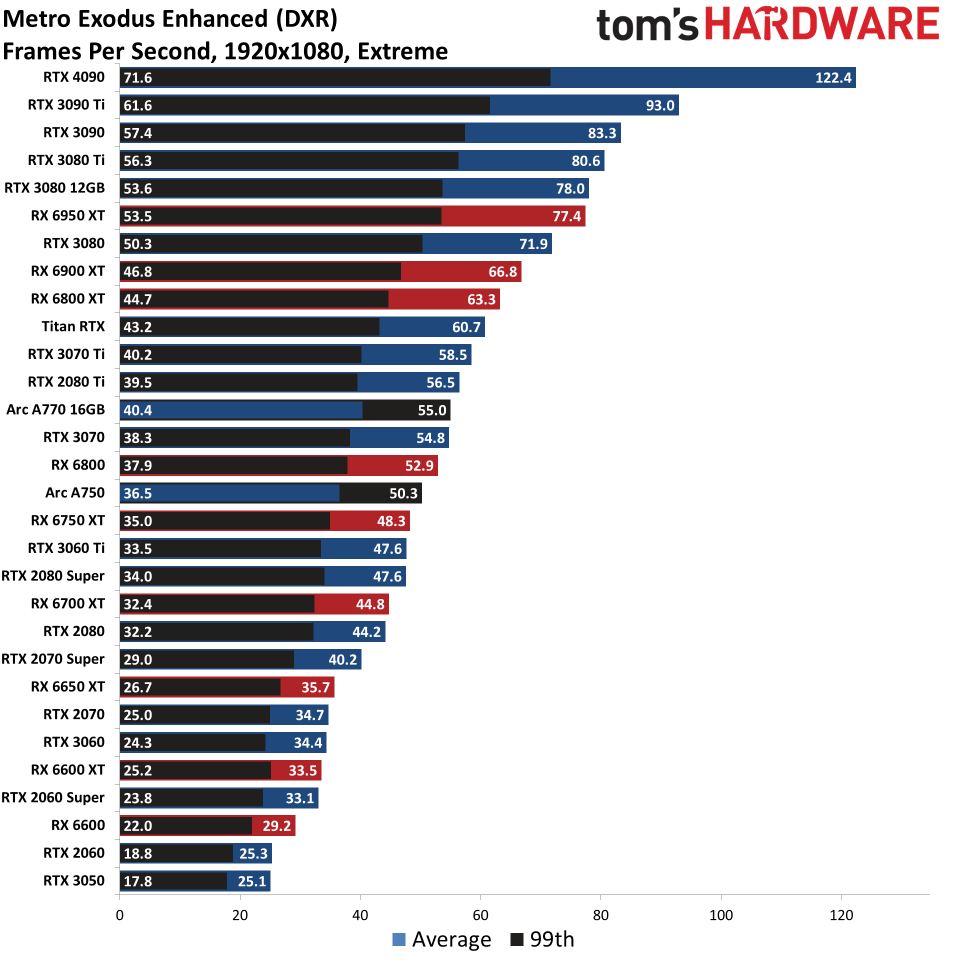
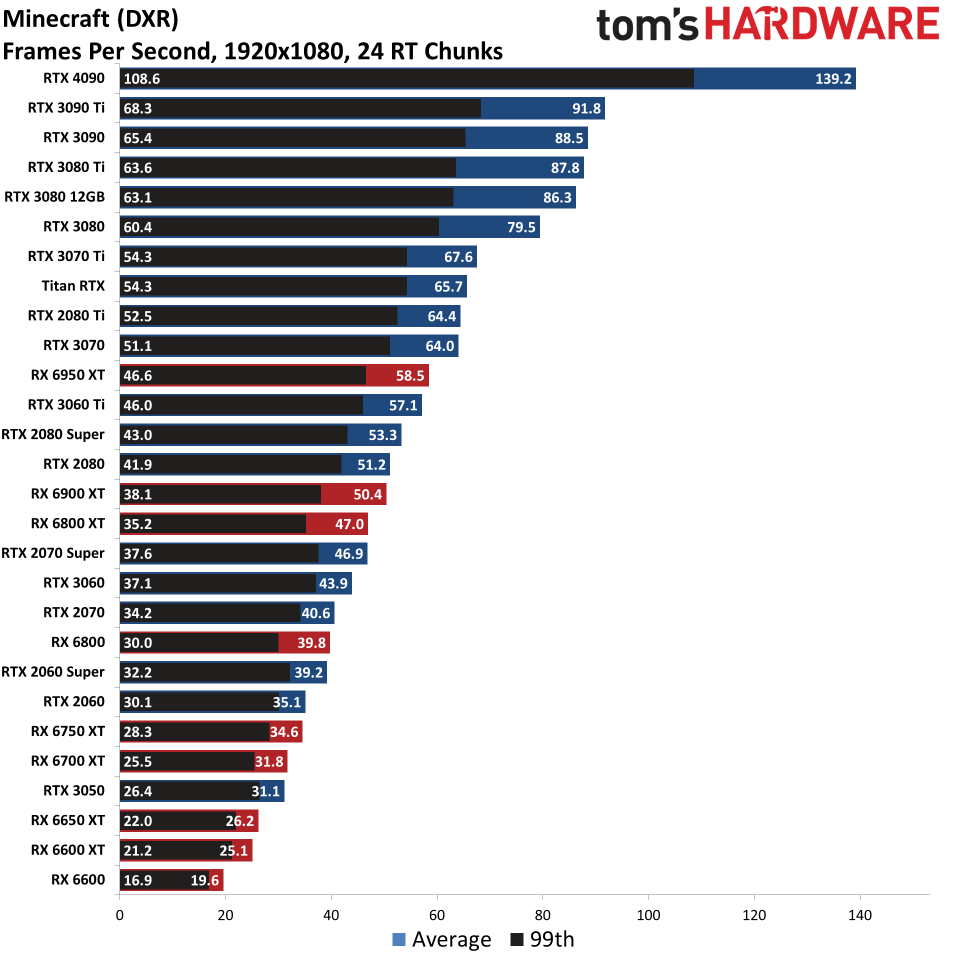
Best Graphics Cards — 1440p Ultra
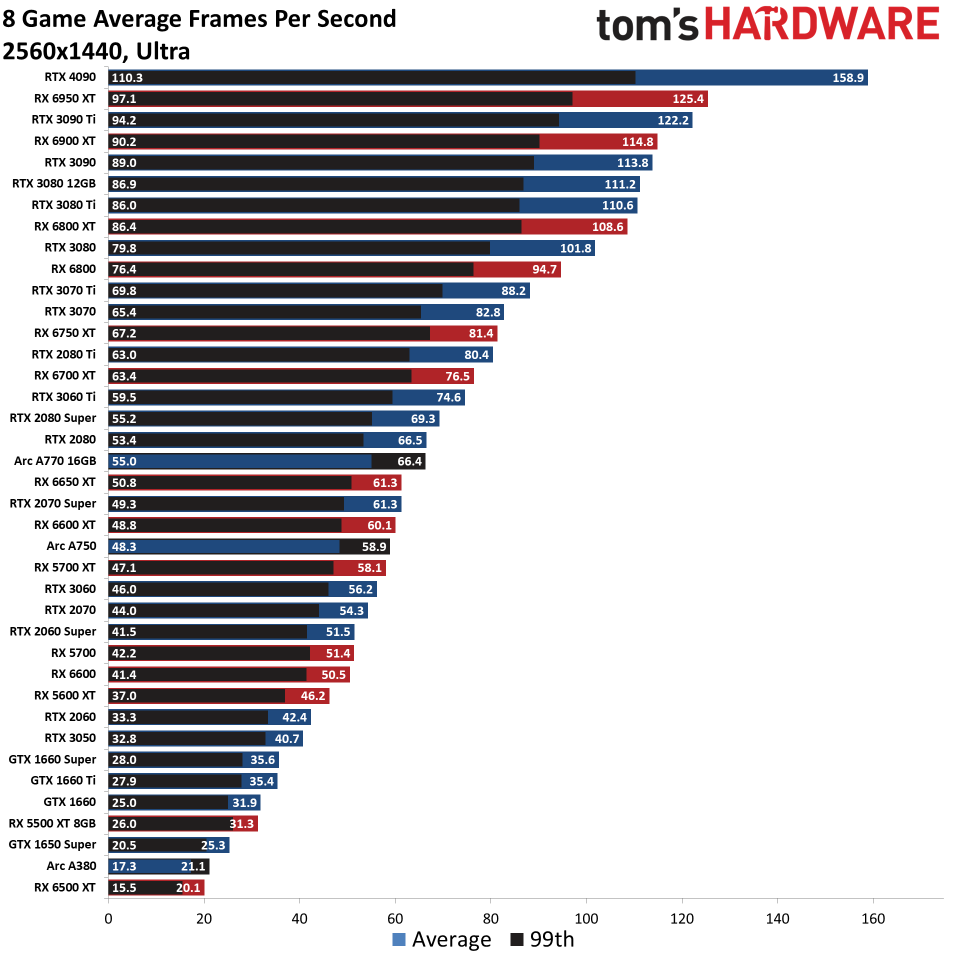
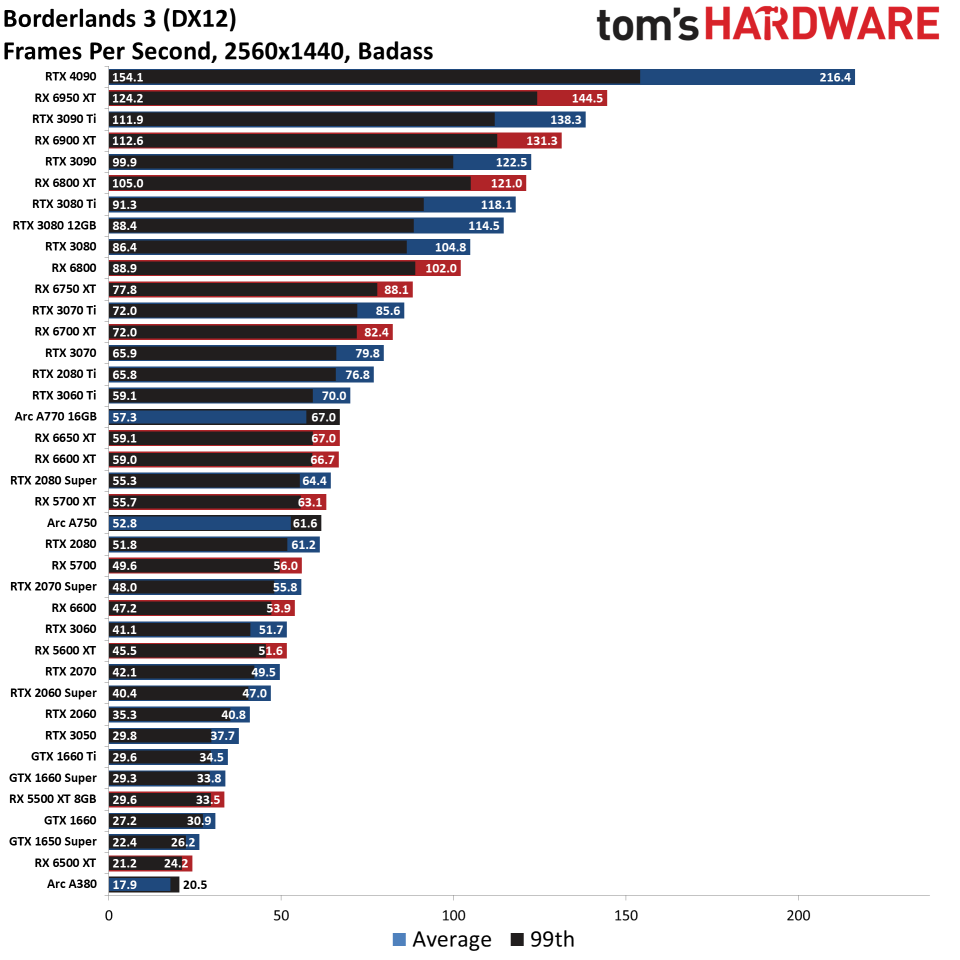
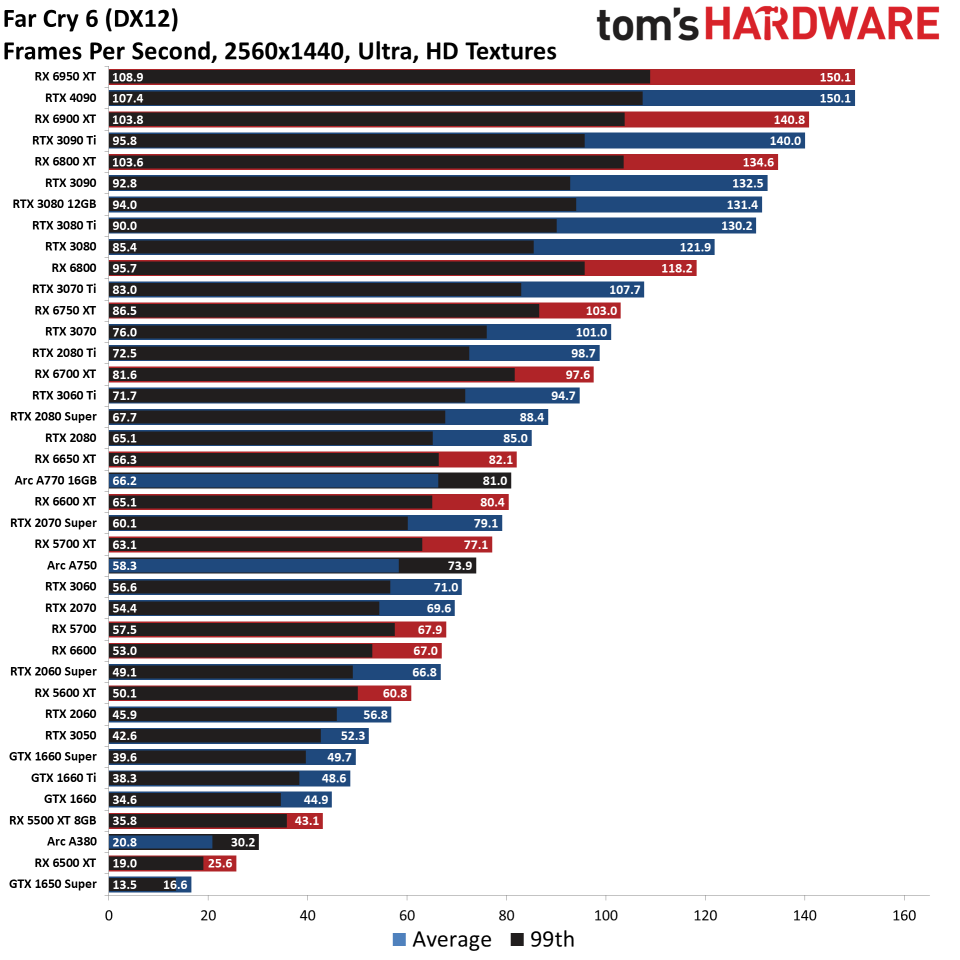
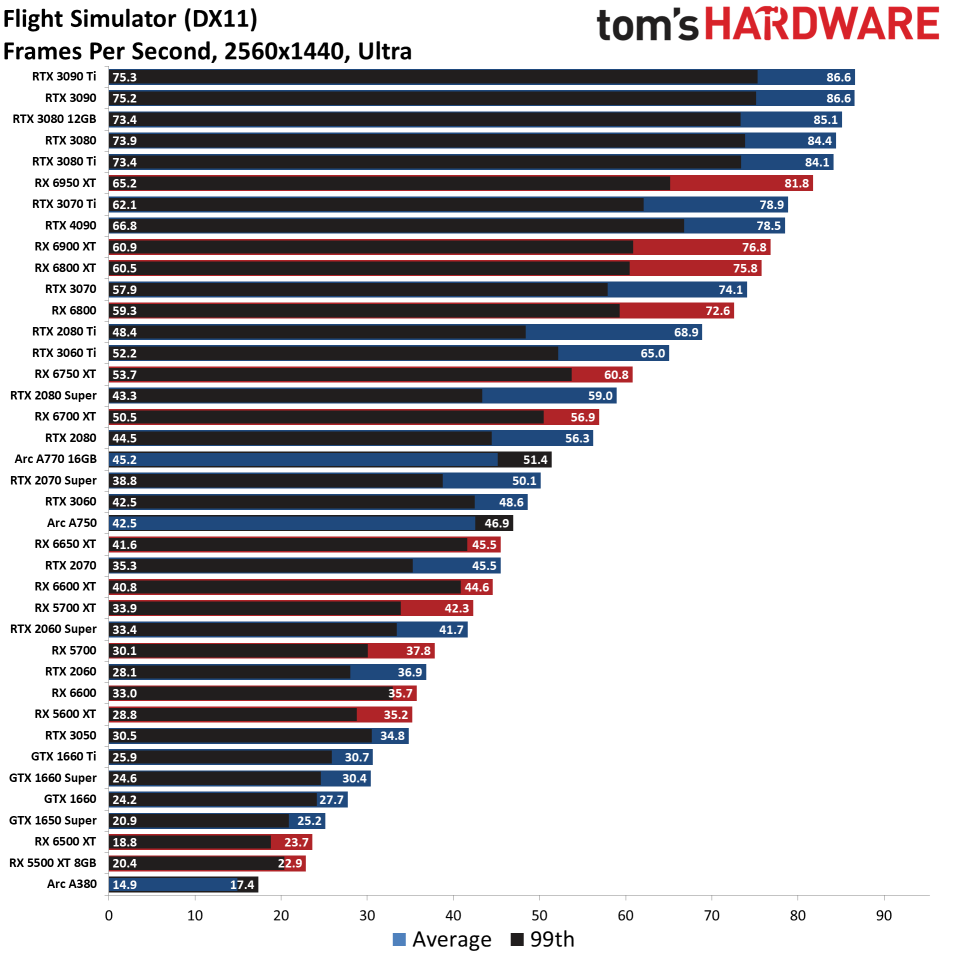
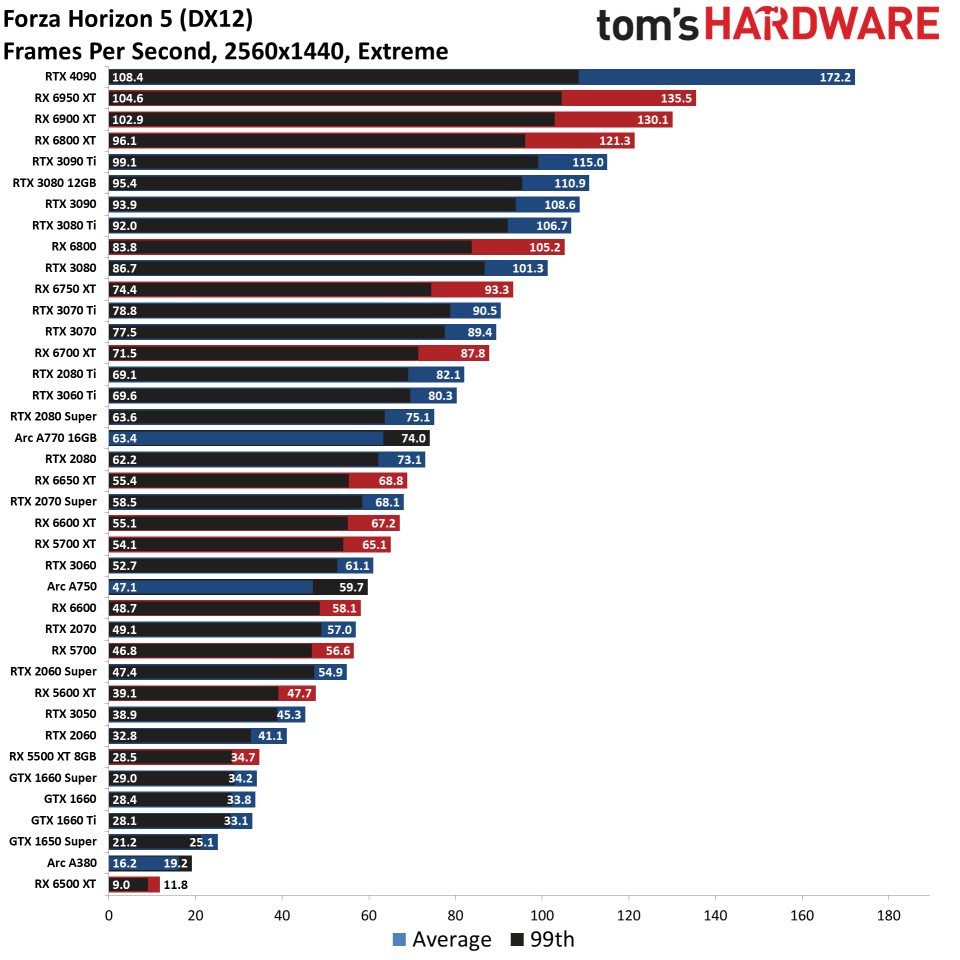
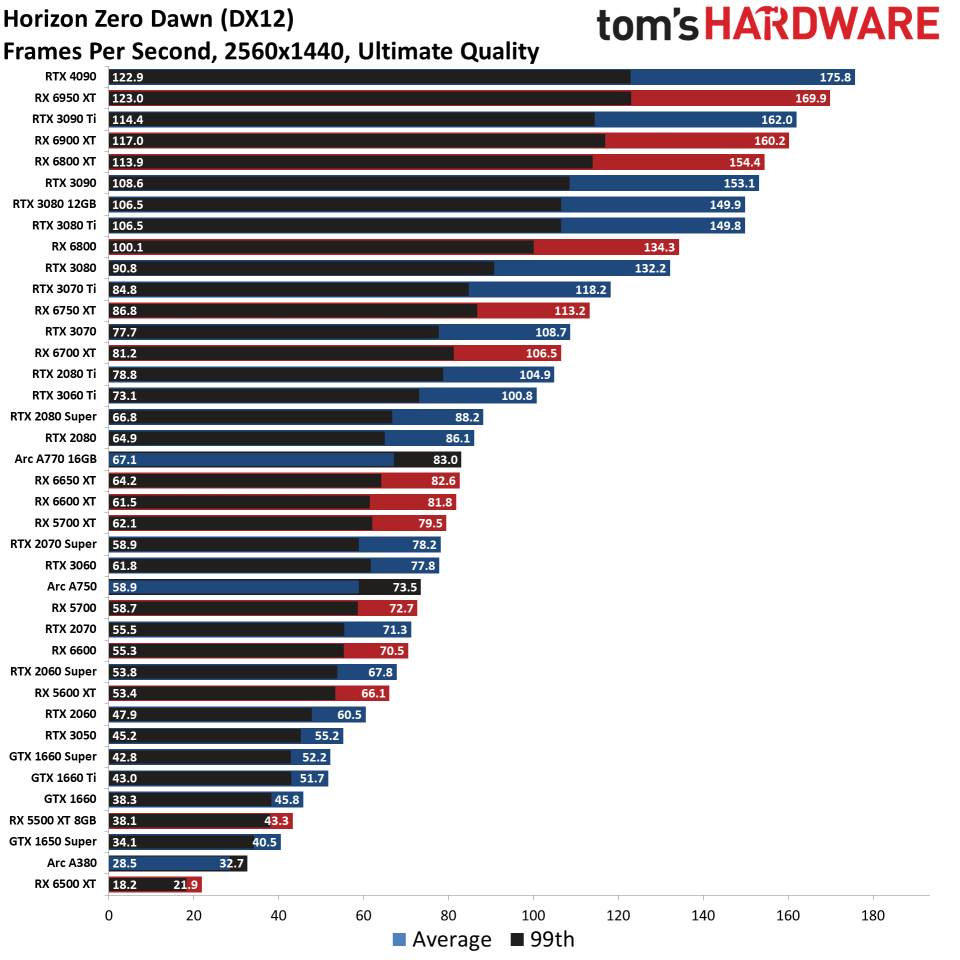
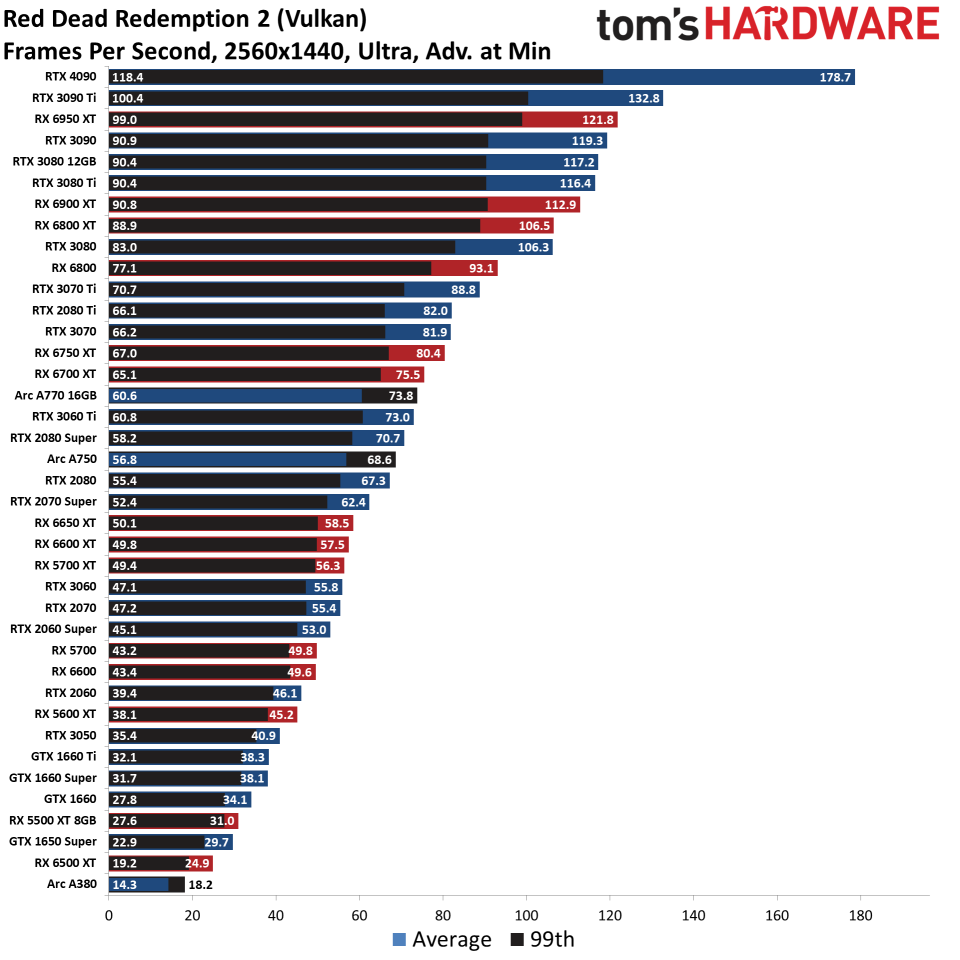
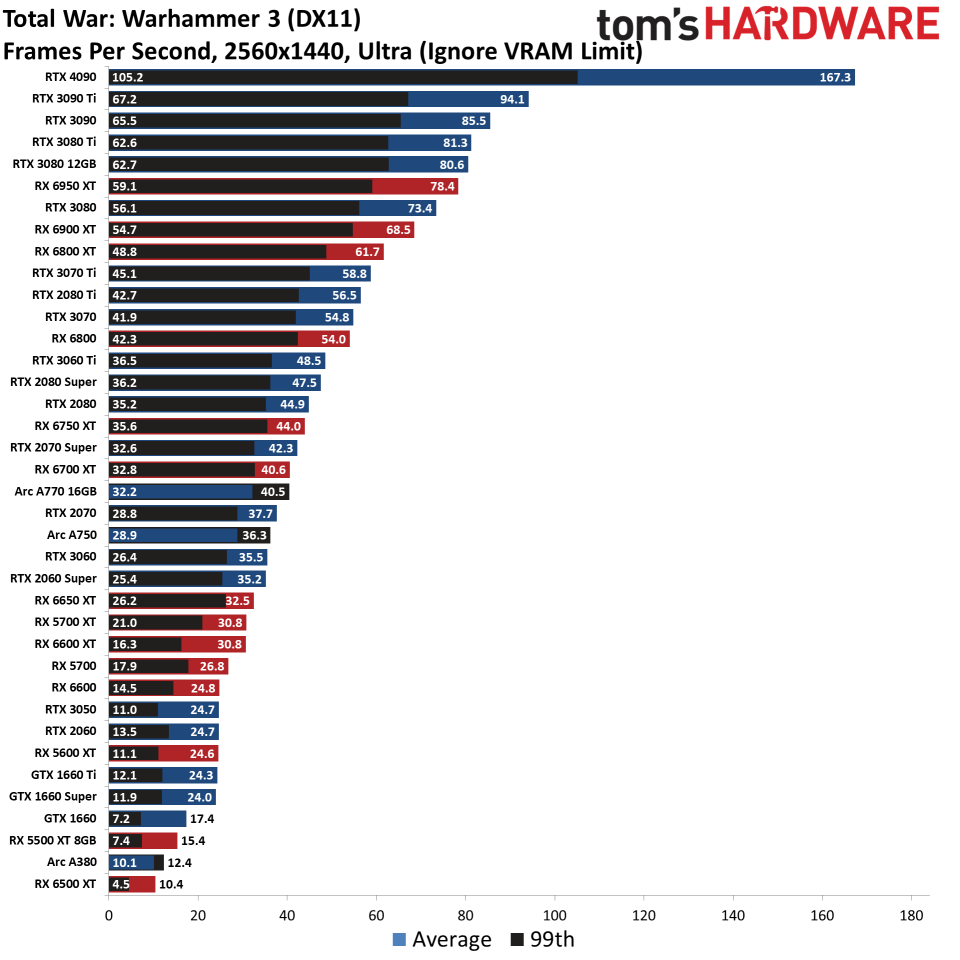
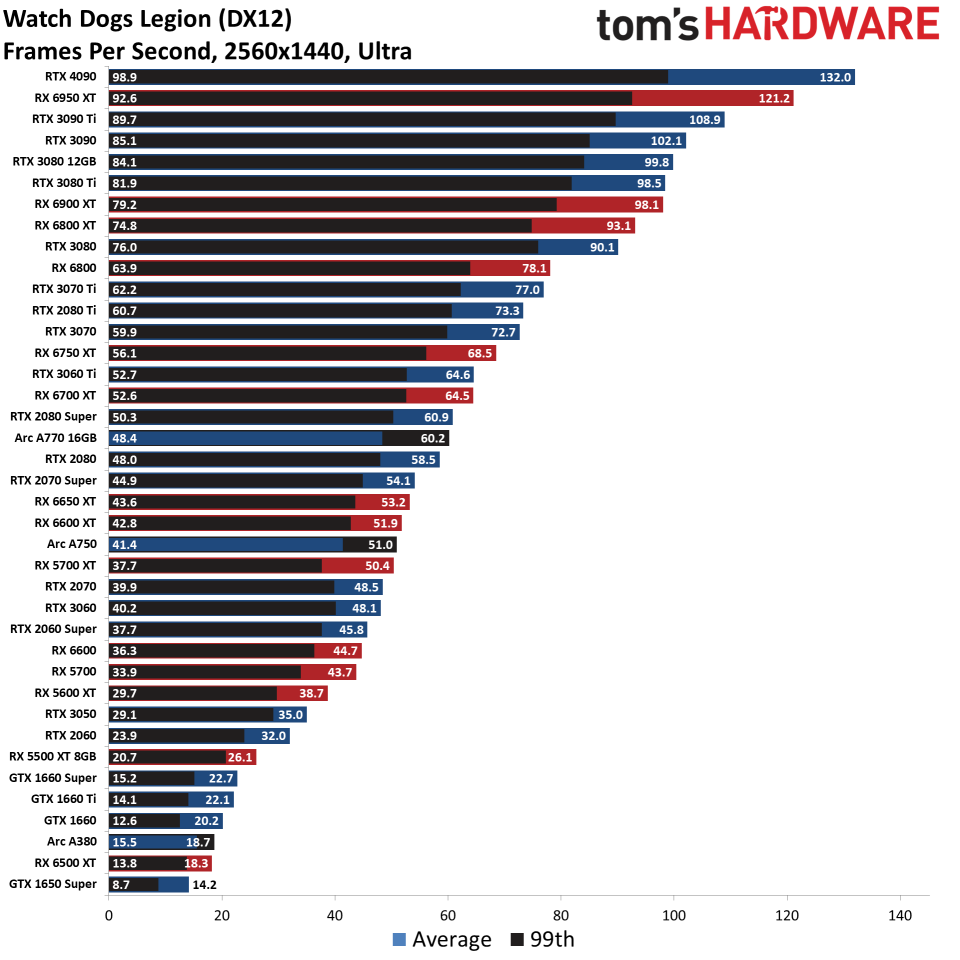
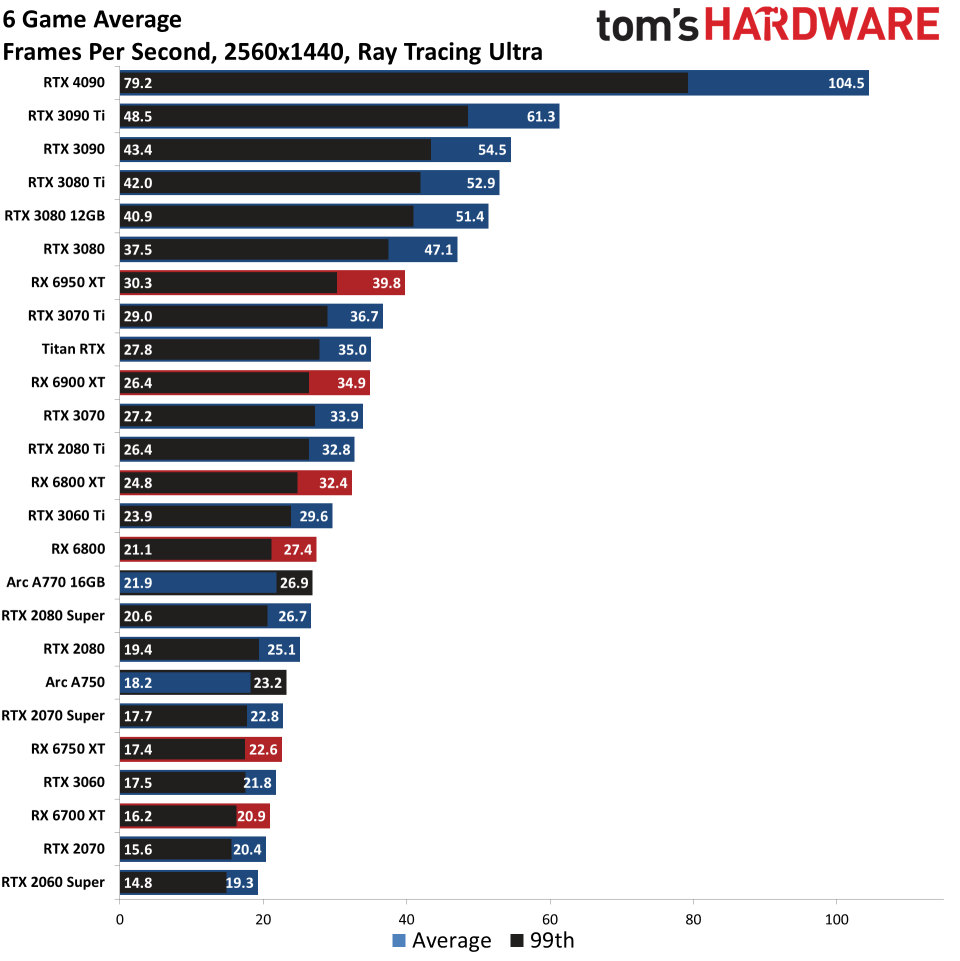
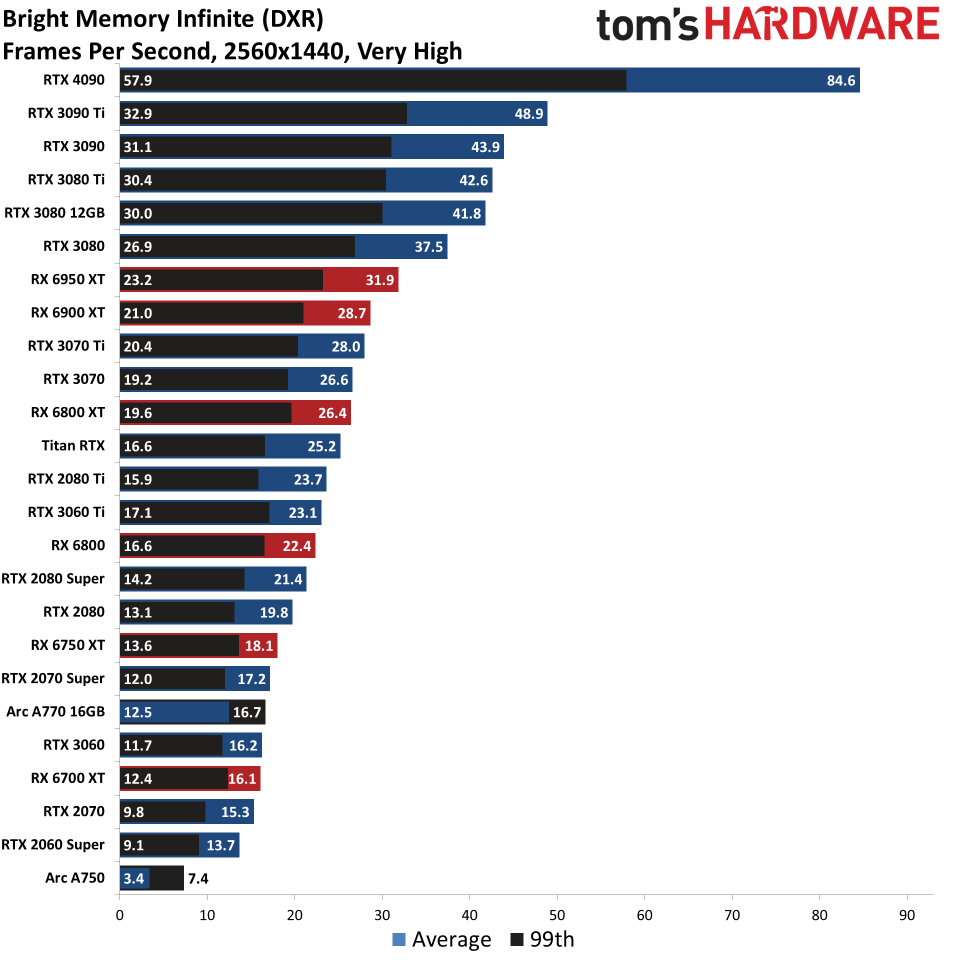
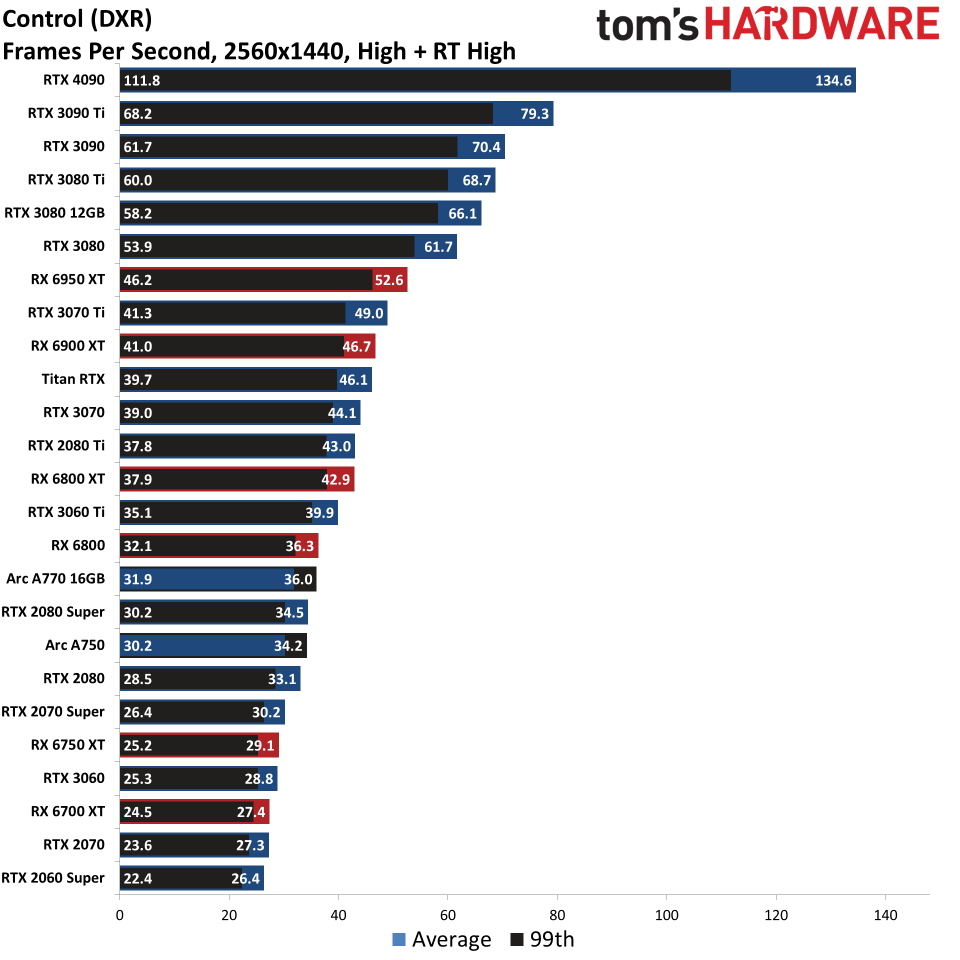
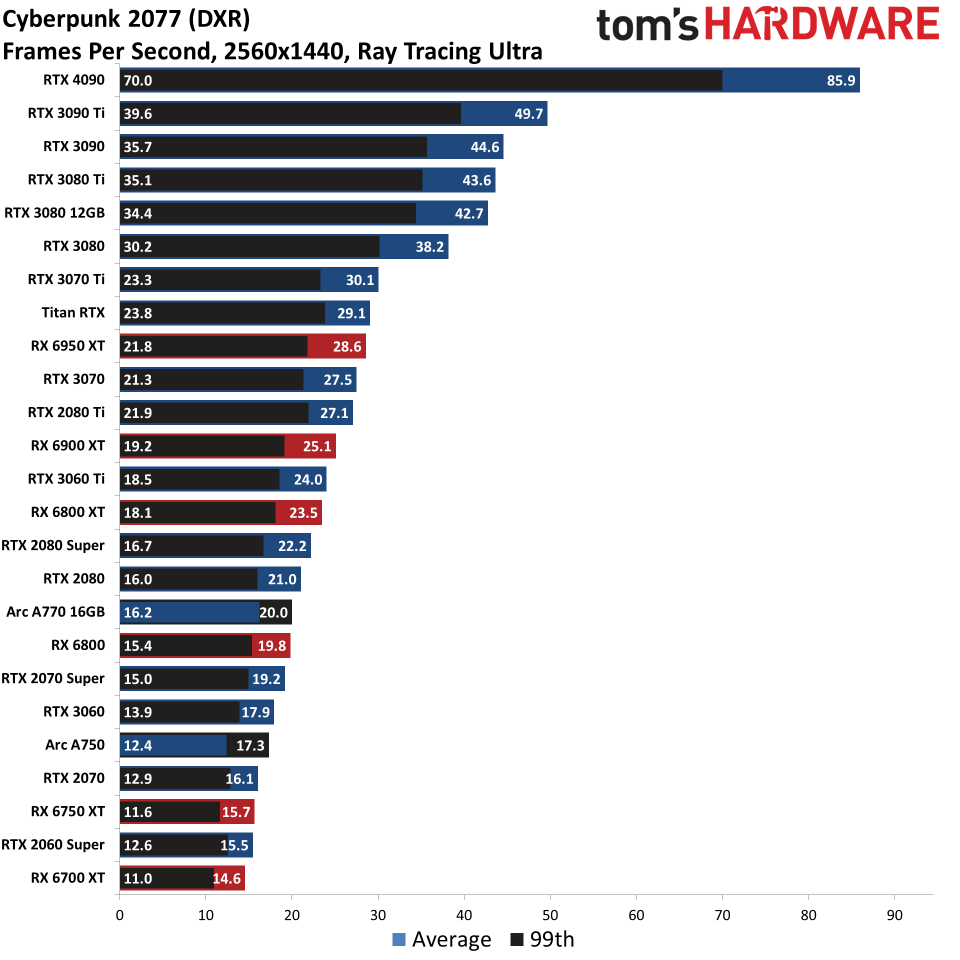
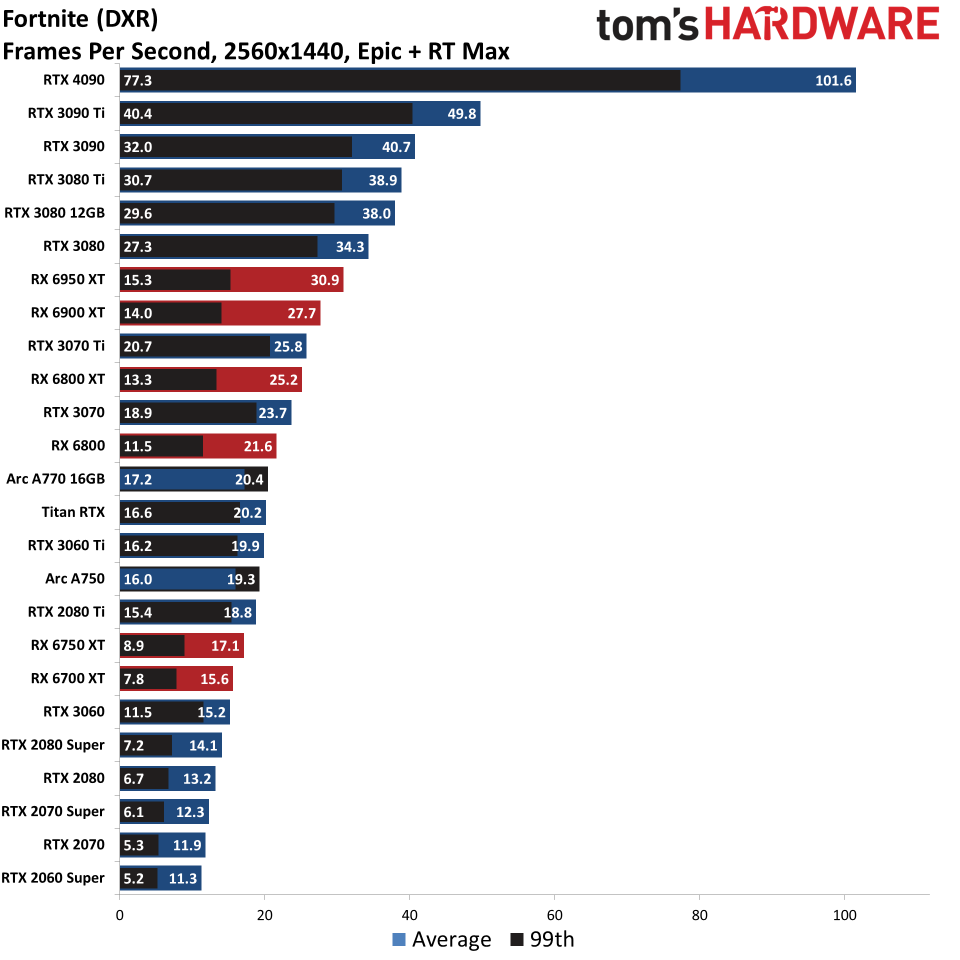
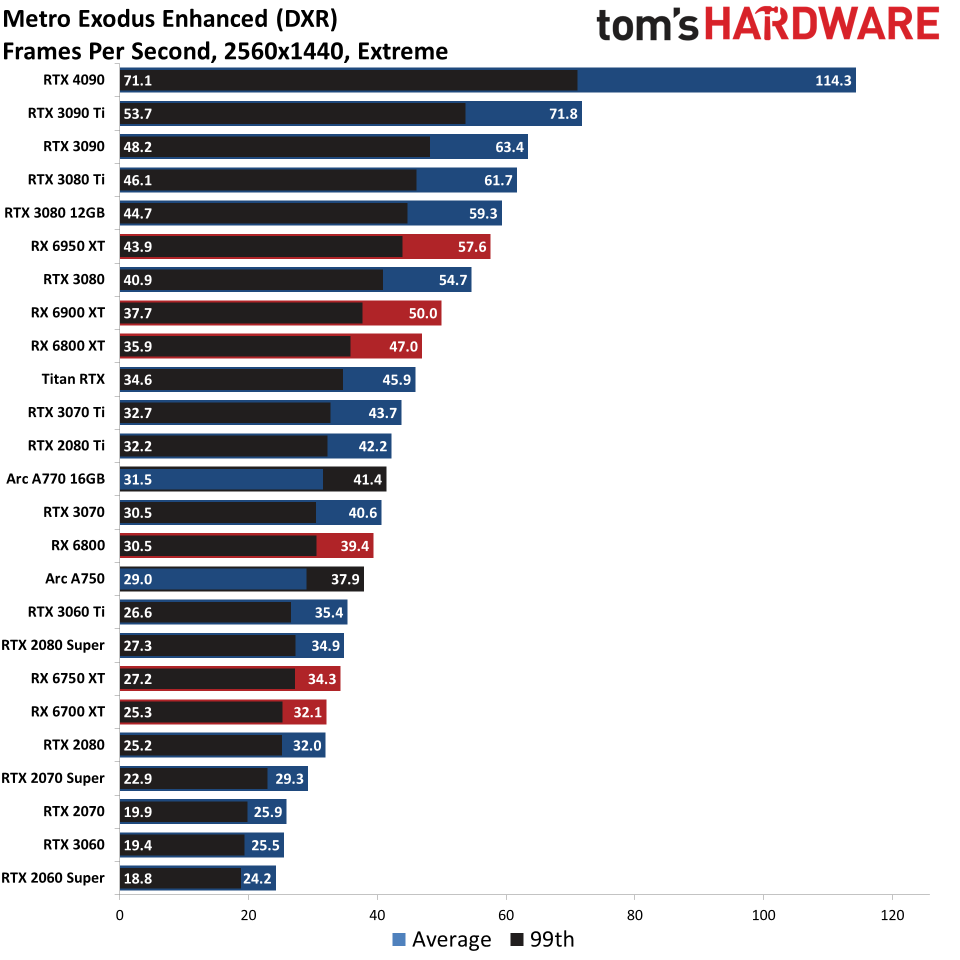
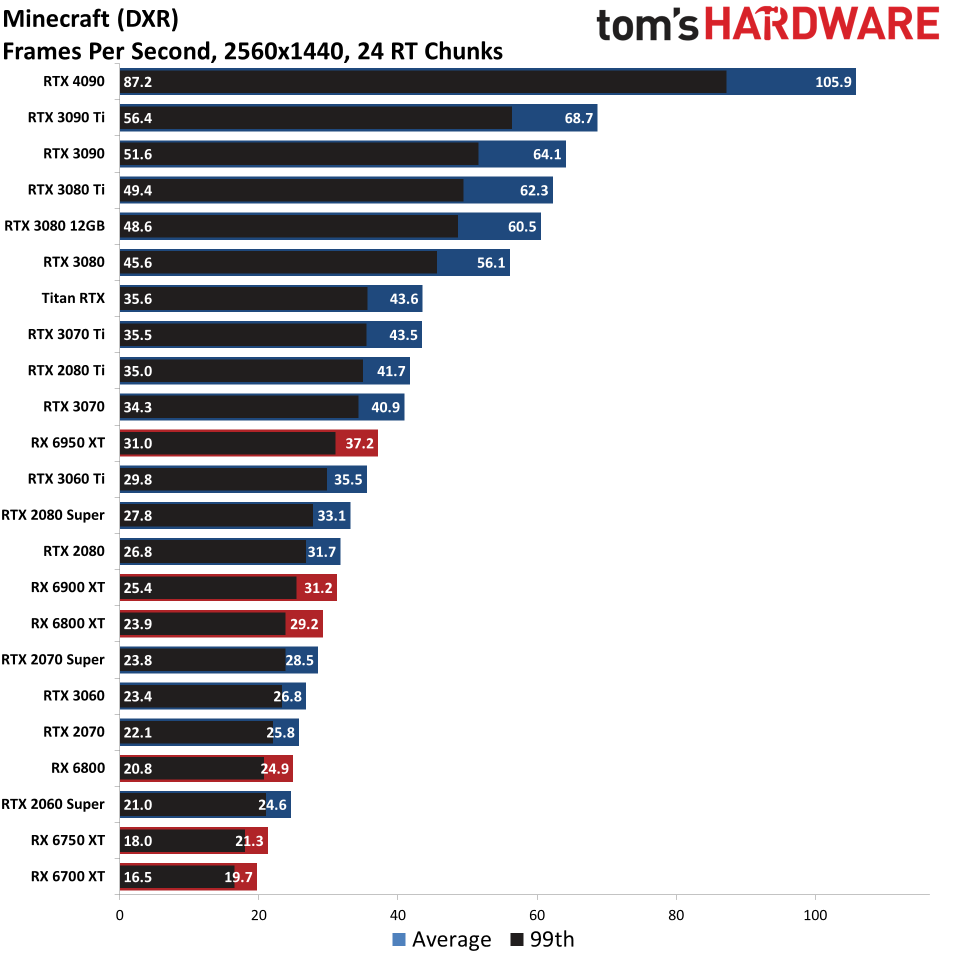
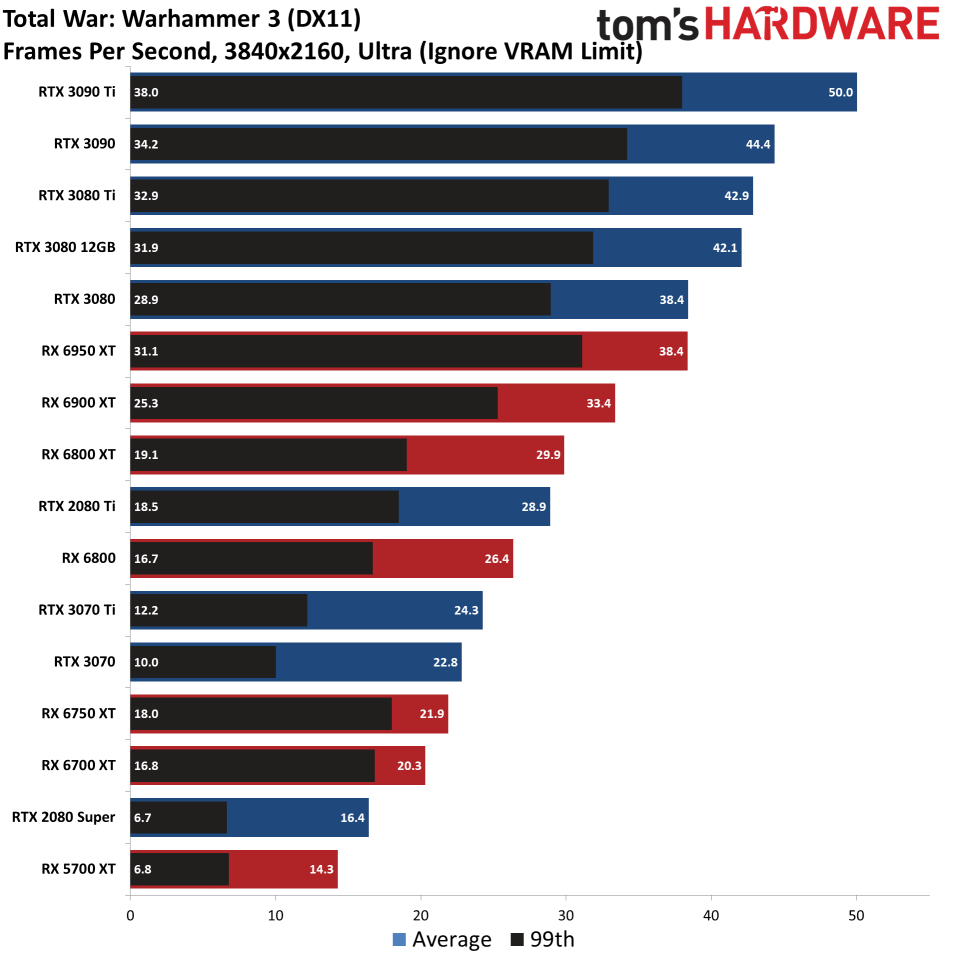
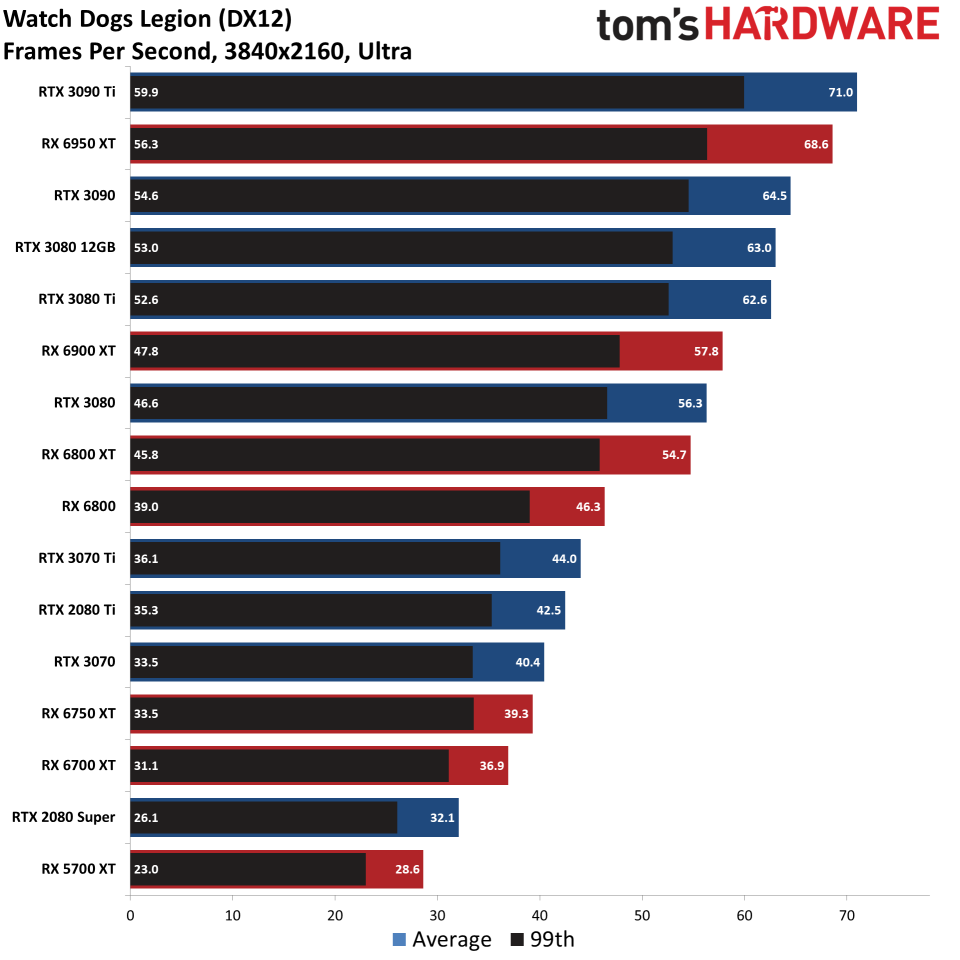
Best Graphics Cards — 4K Ultra
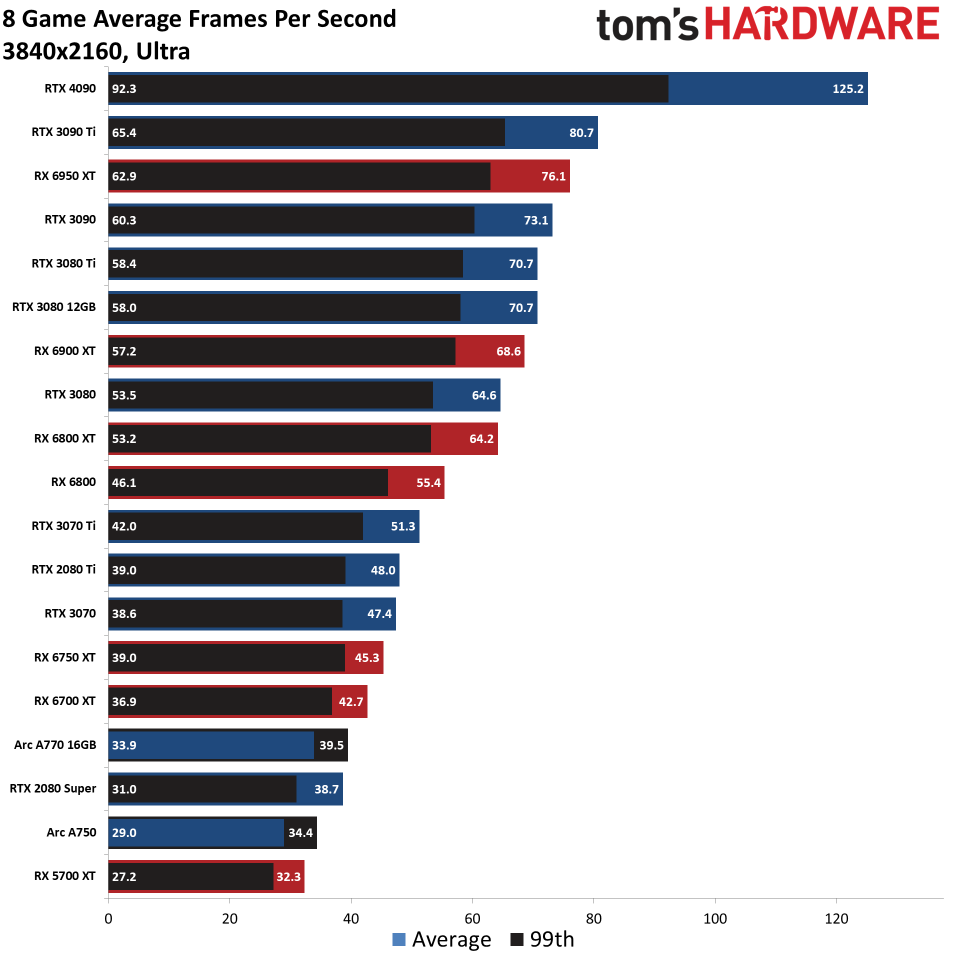
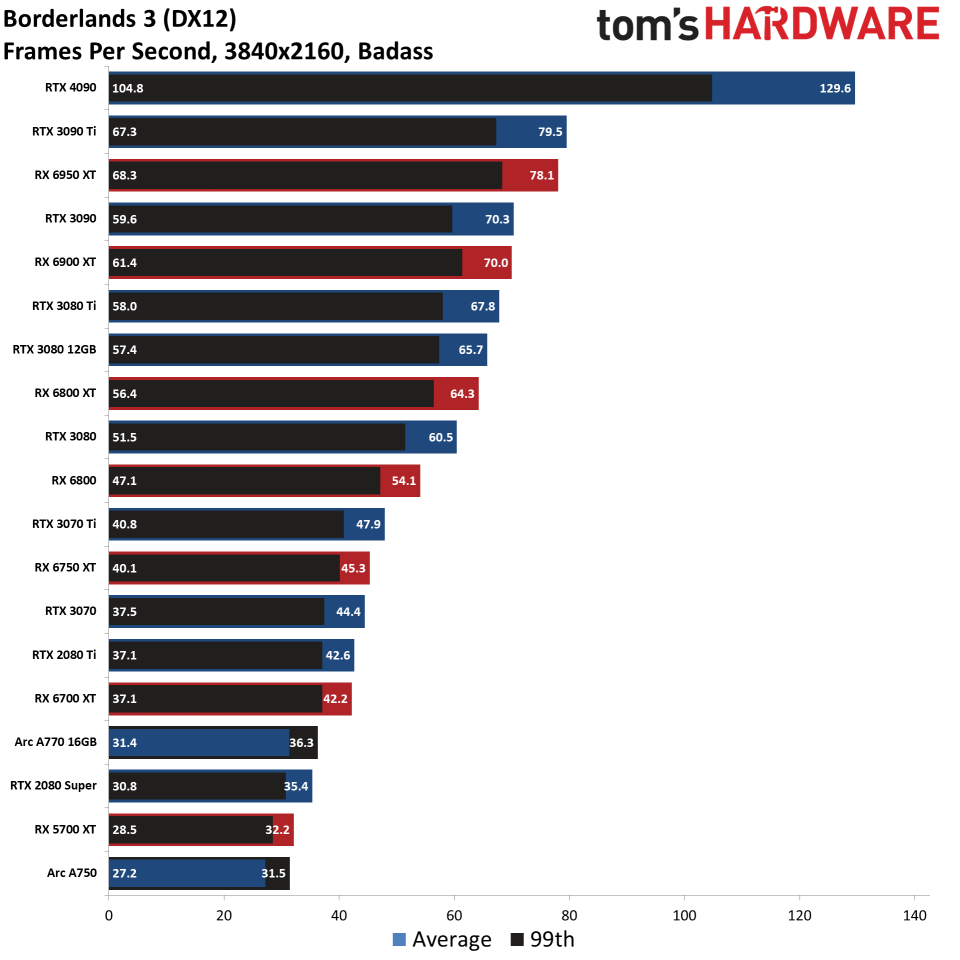

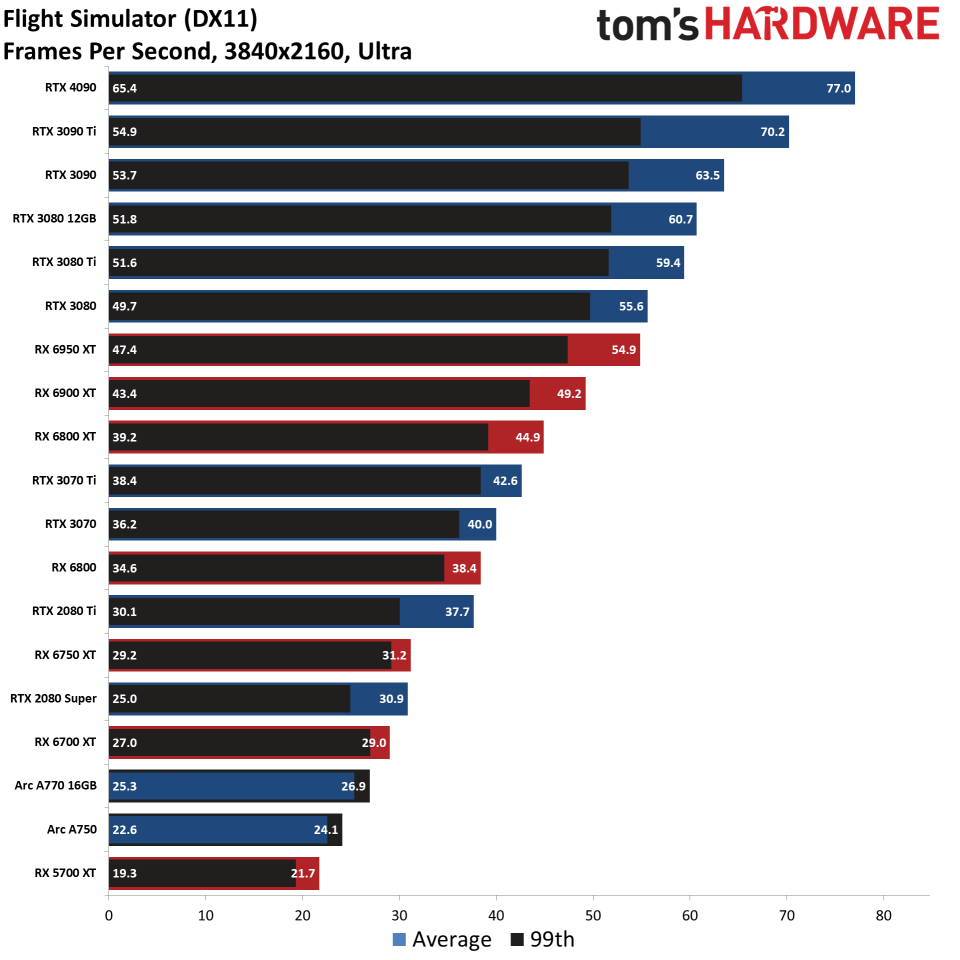
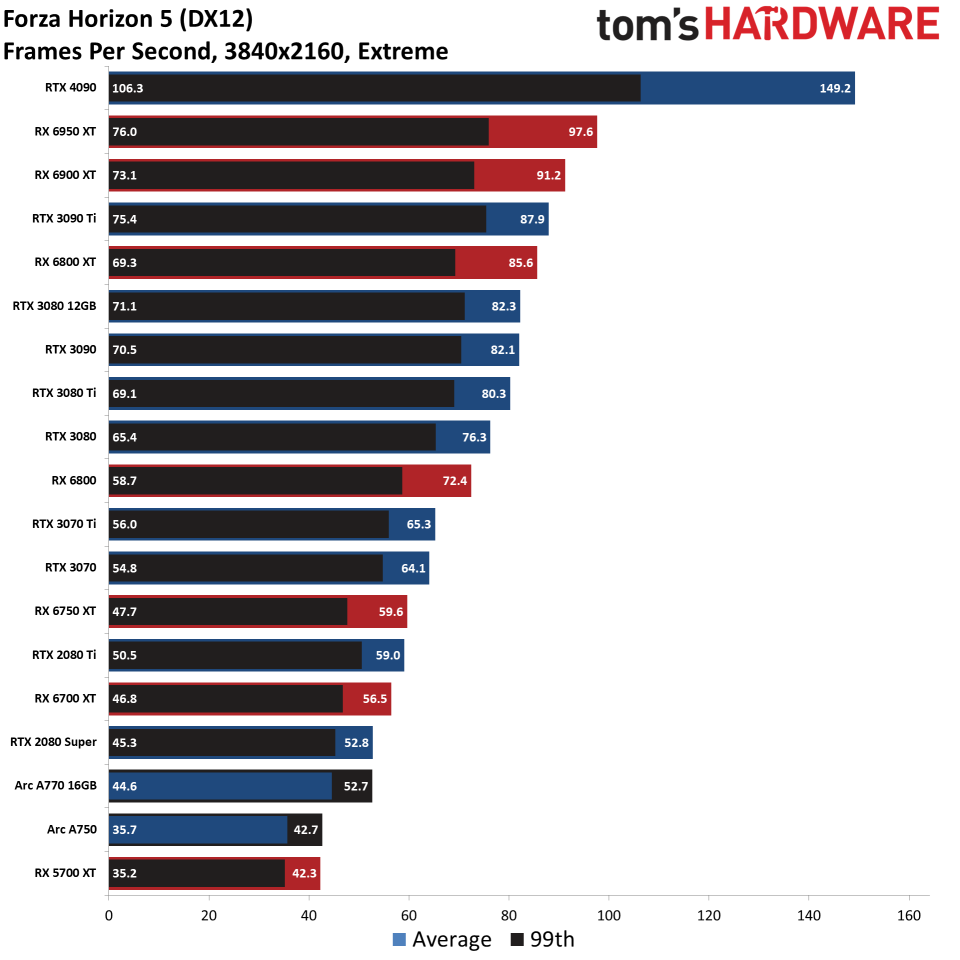
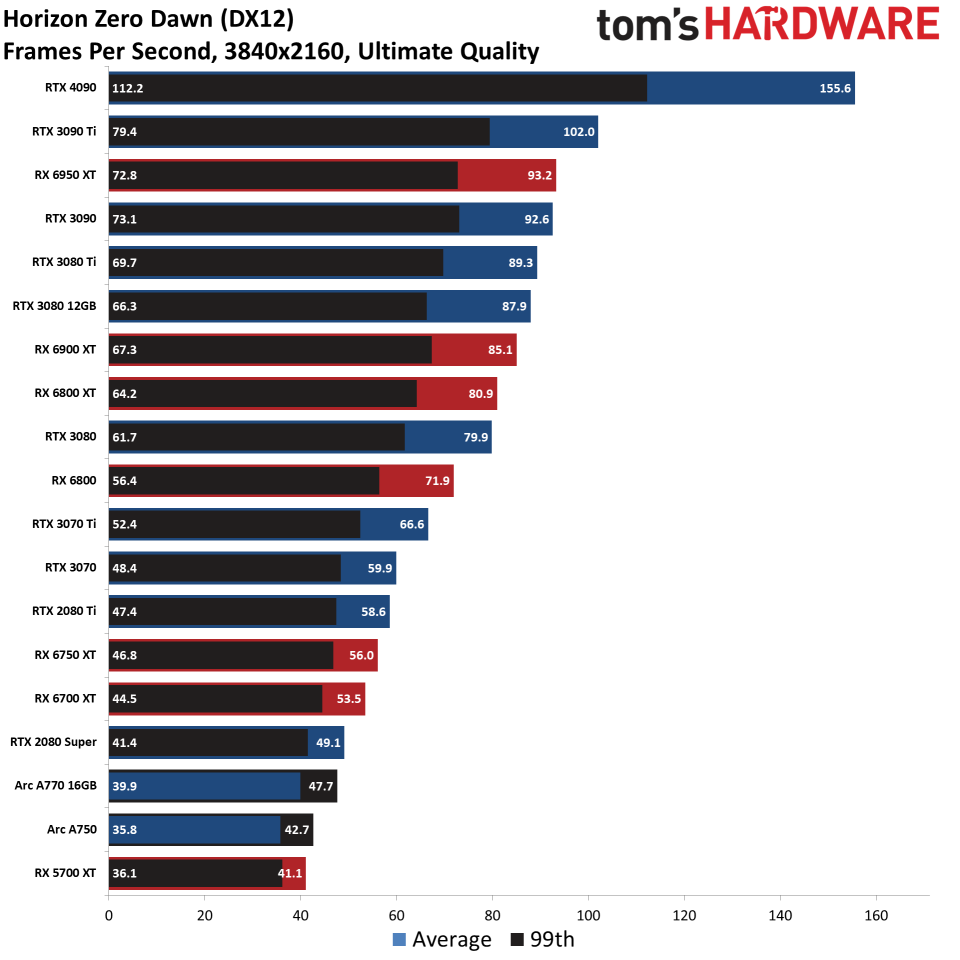
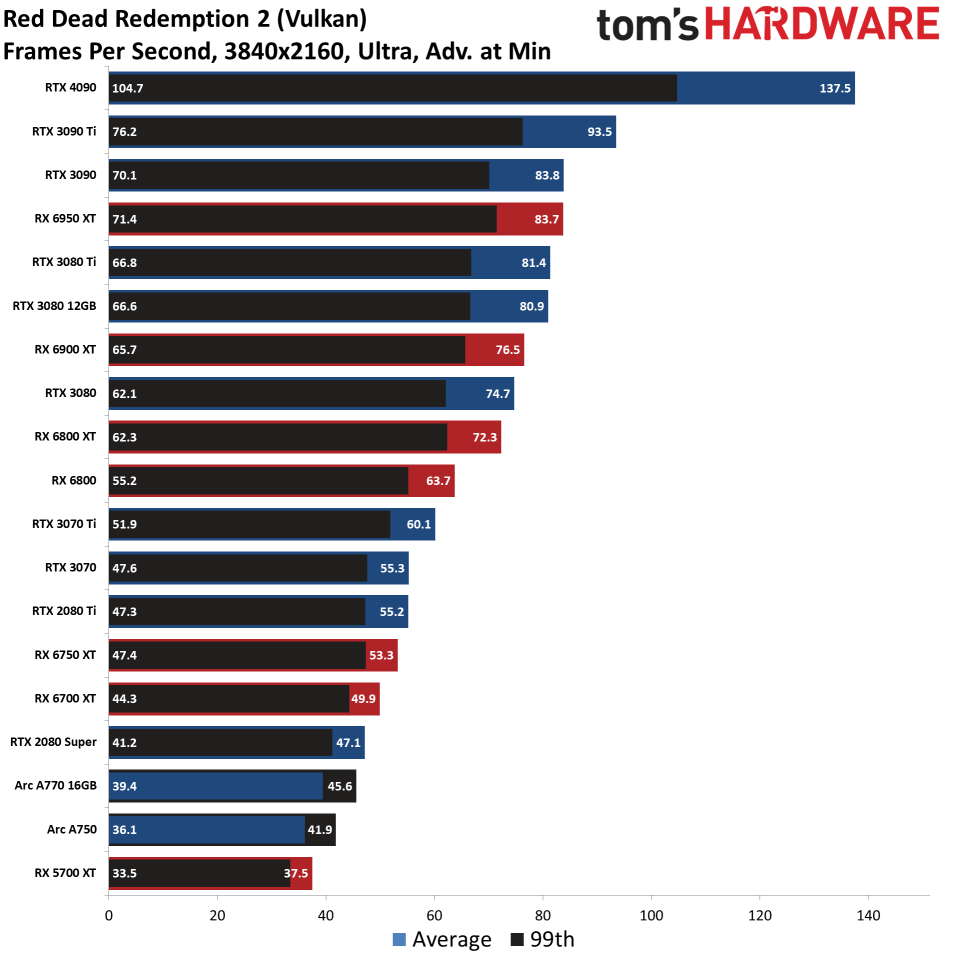
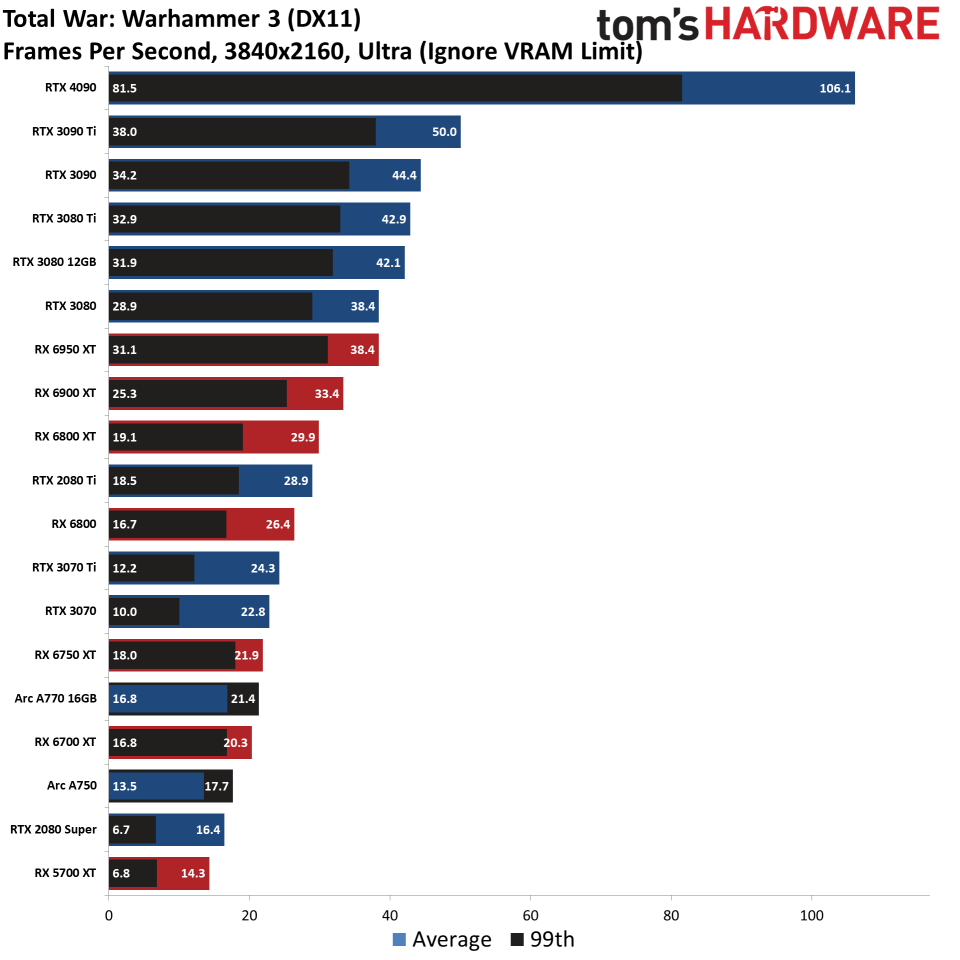
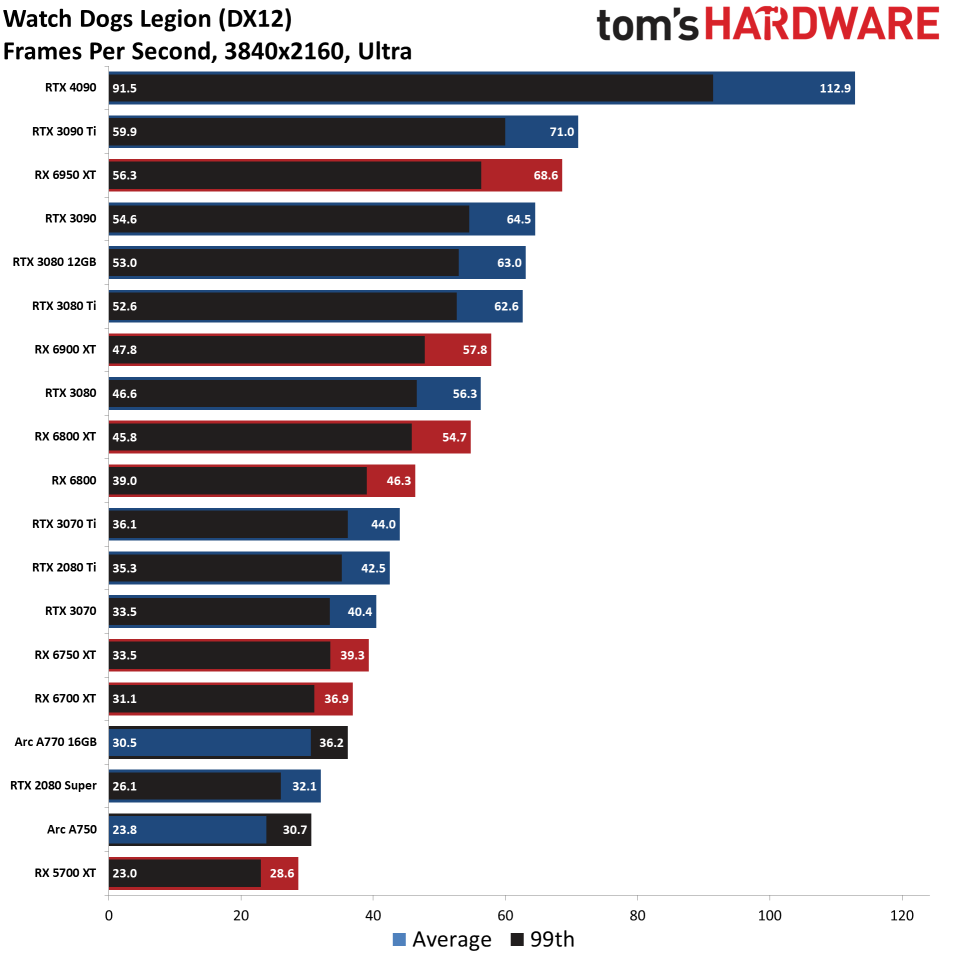
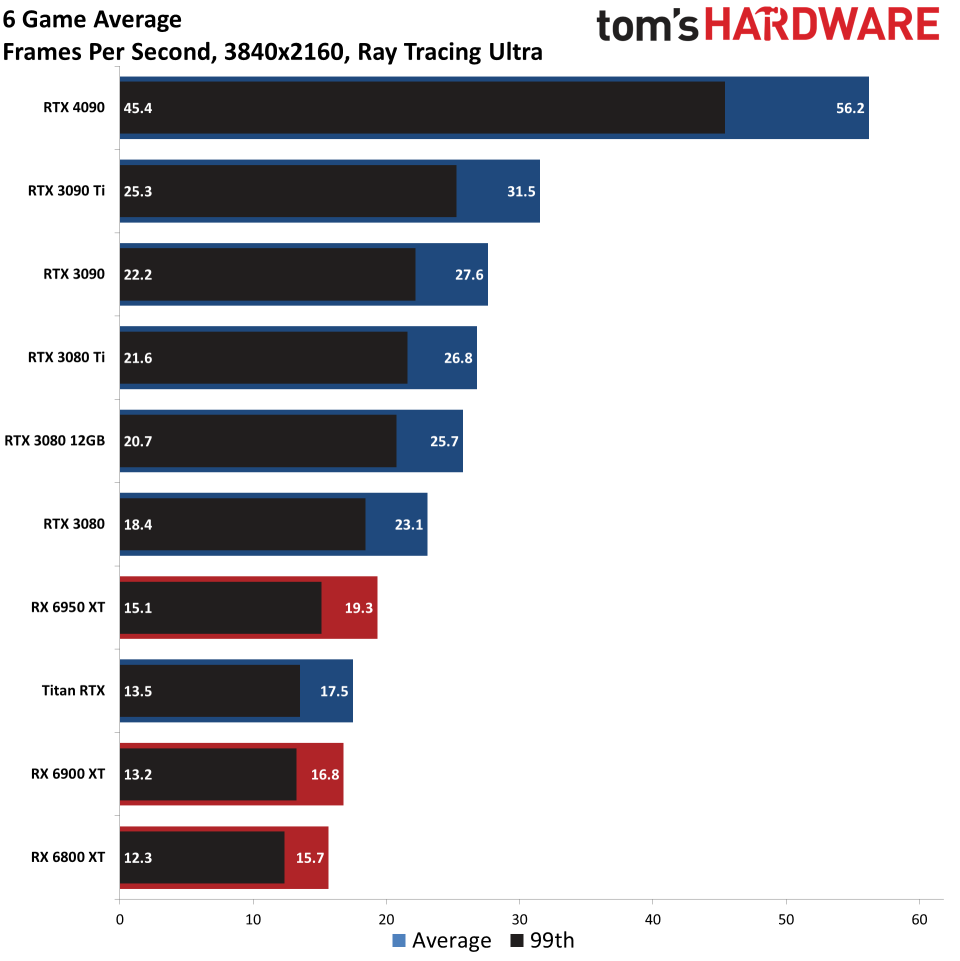
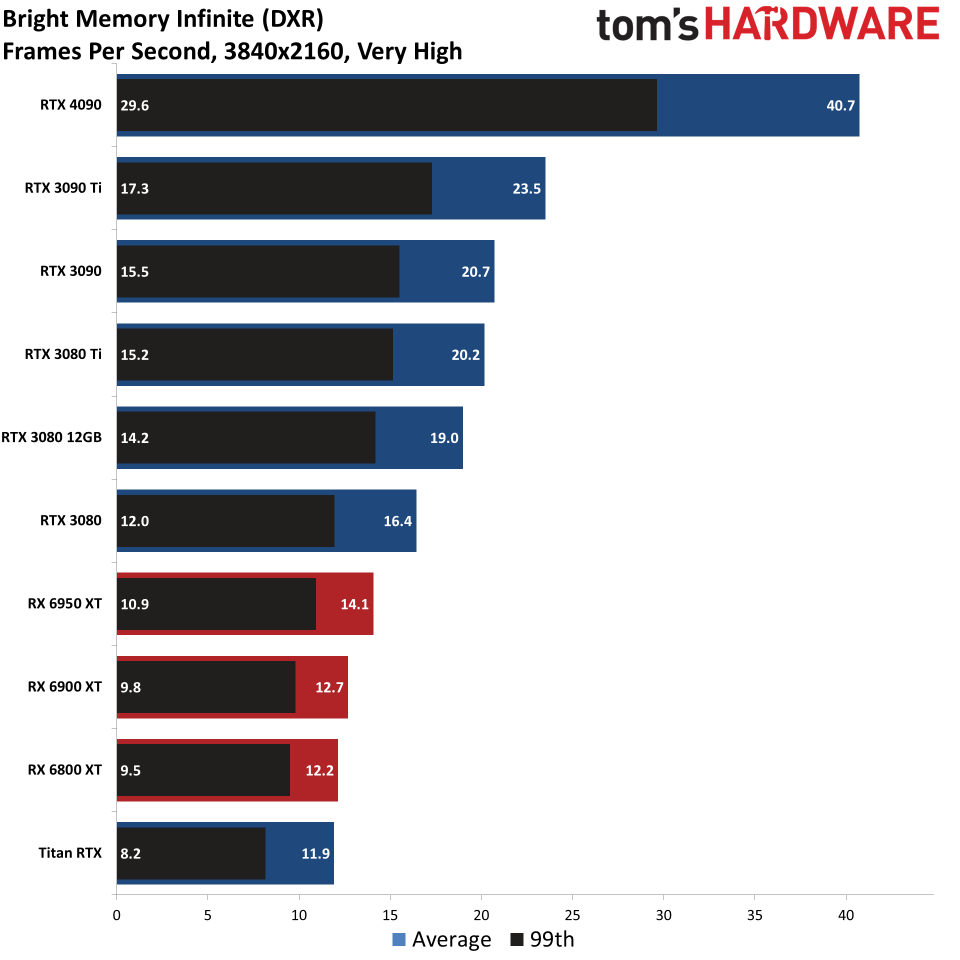
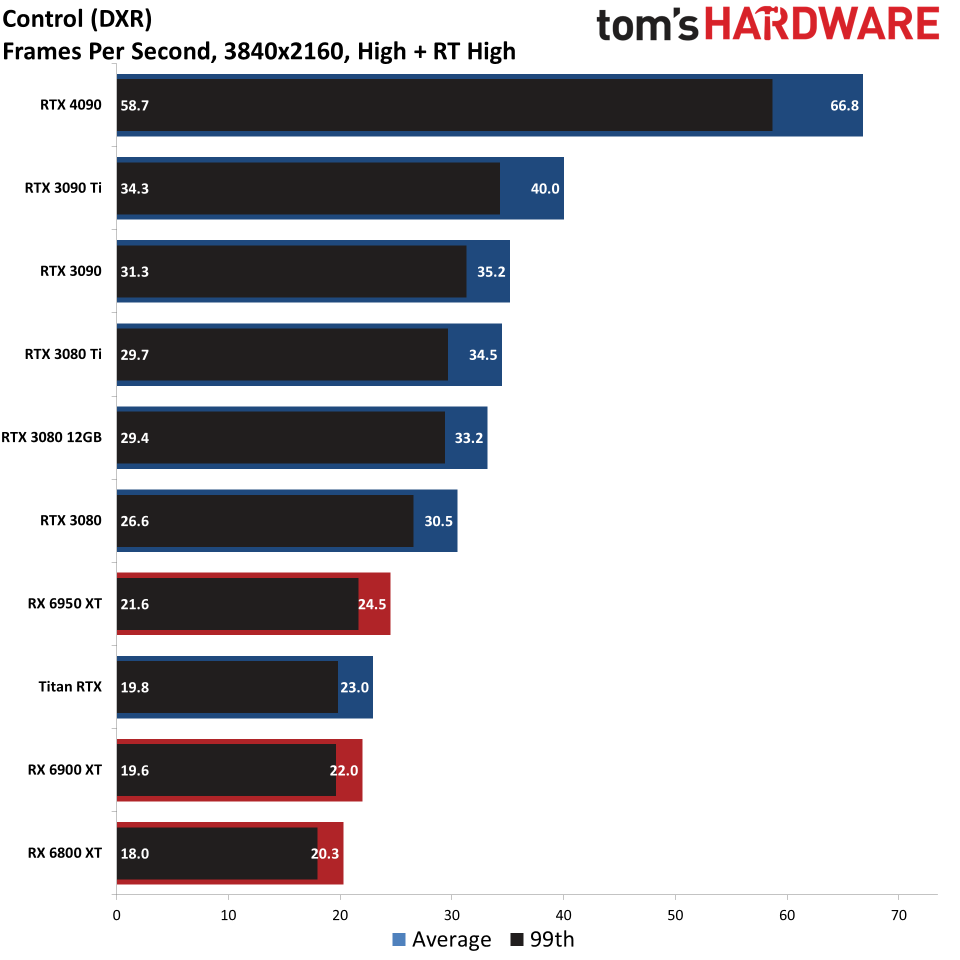
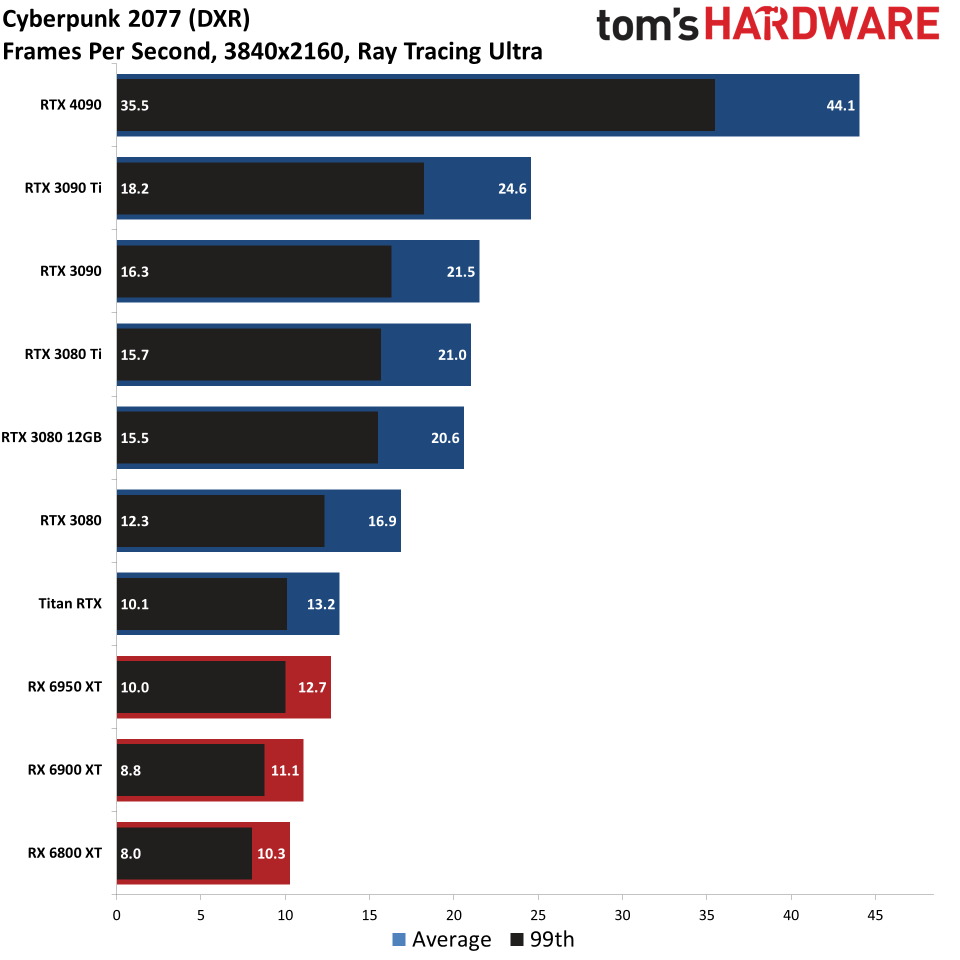
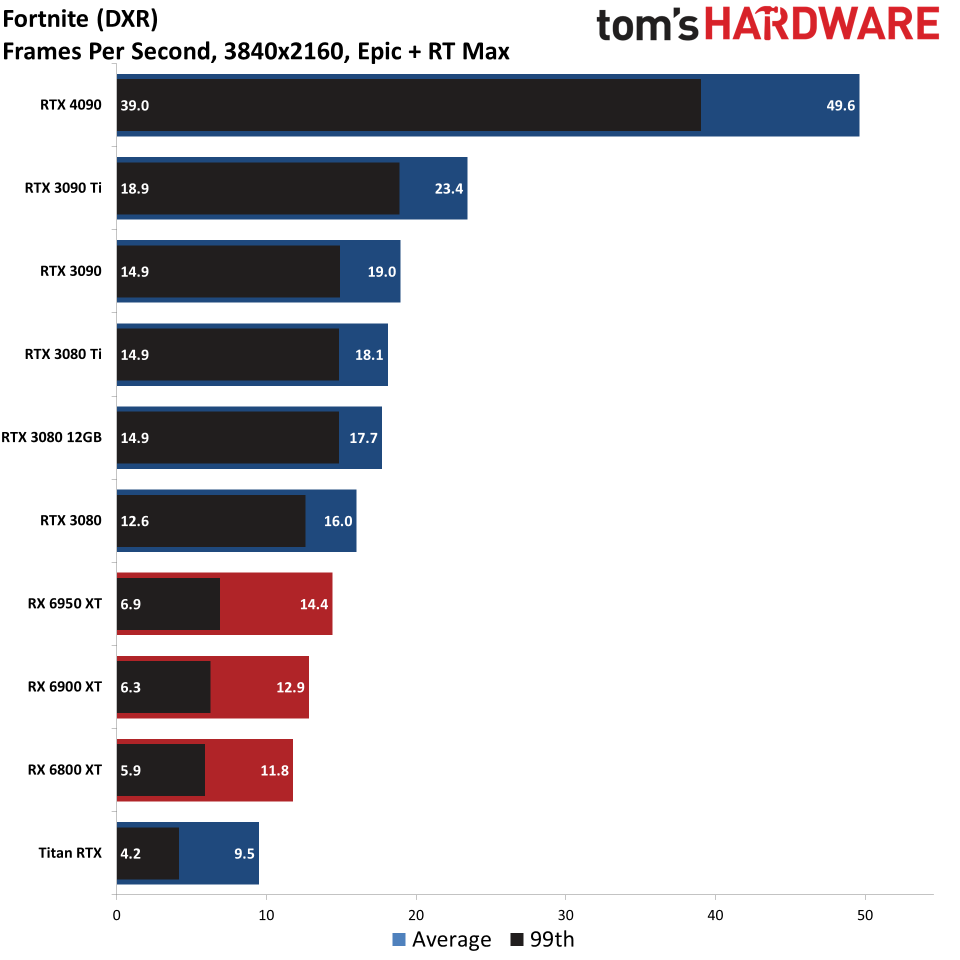
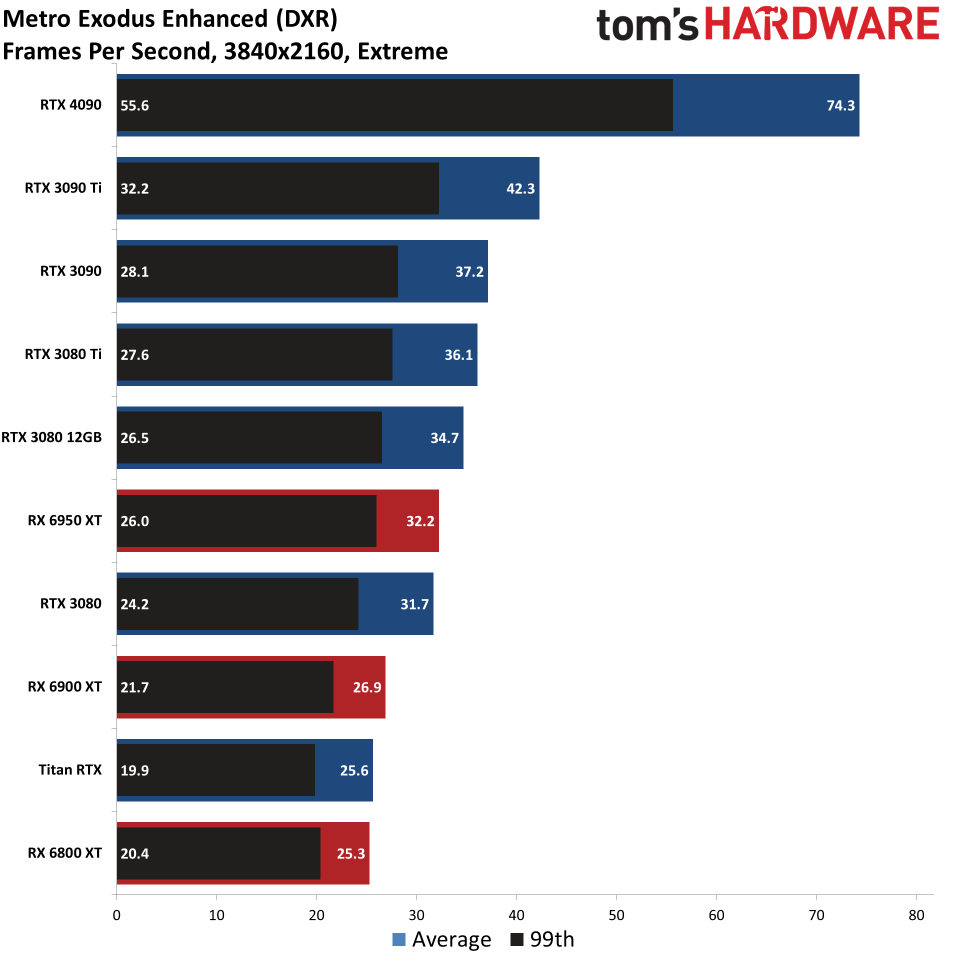
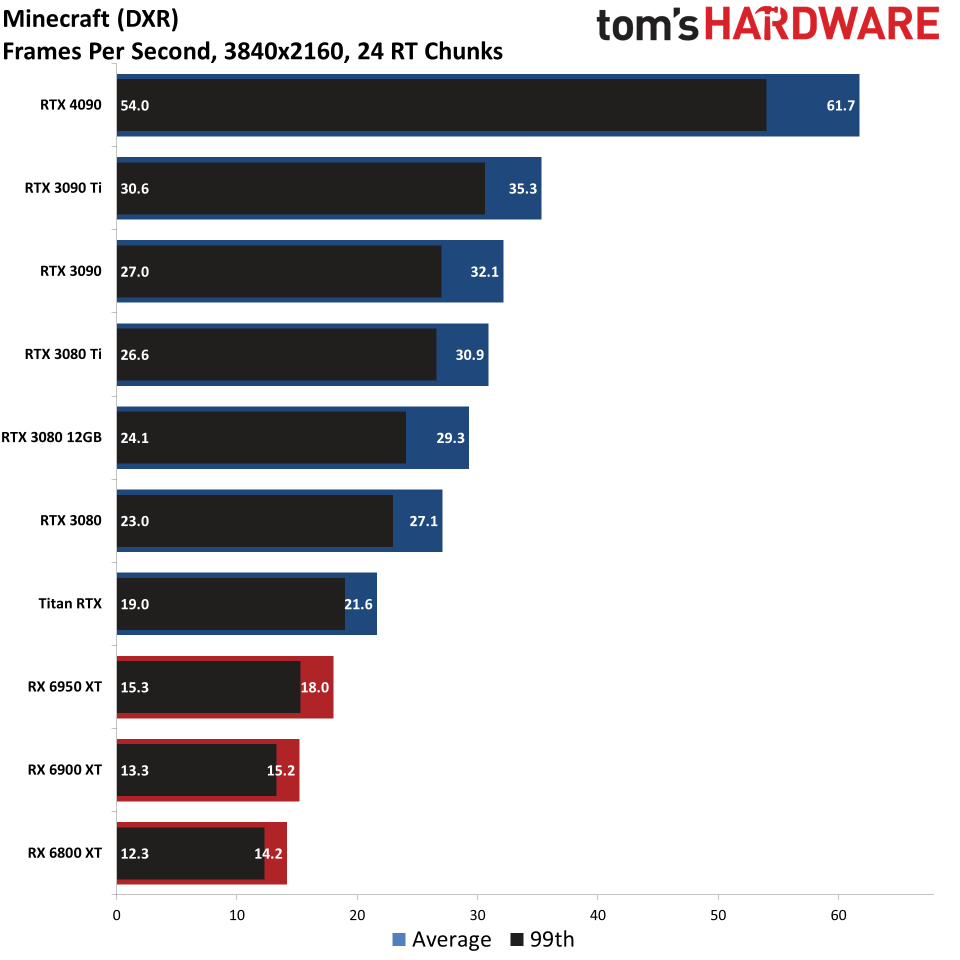
Best Graphics Cards — Power Consumption
Besides performance, we also test graphics card power consumption, clock speeds, fan speeds, and temperatures. We tested all current GPUs using Powenetics equipment and software, and while Nvidia generally had an efficiency lead on previous generation parts, AMD's RDNA2 GPUs now rate as the most efficient options in most cases. Here are the charts from our testing.
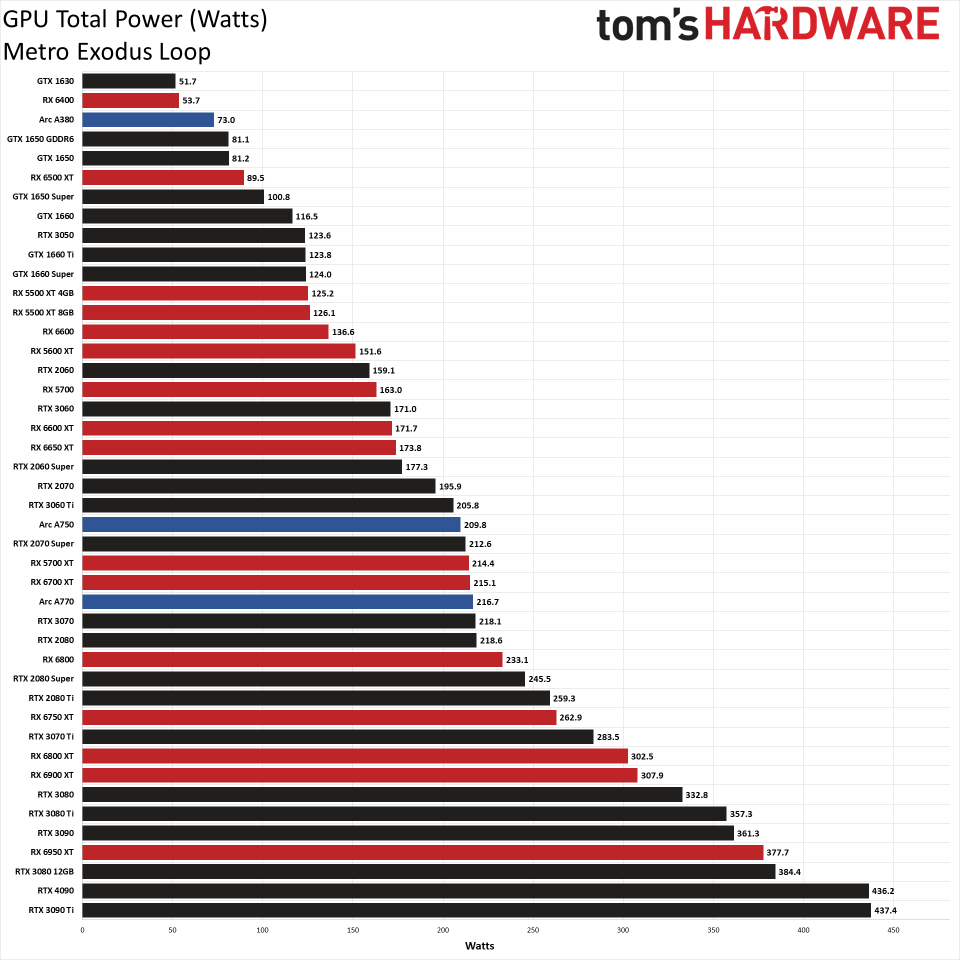
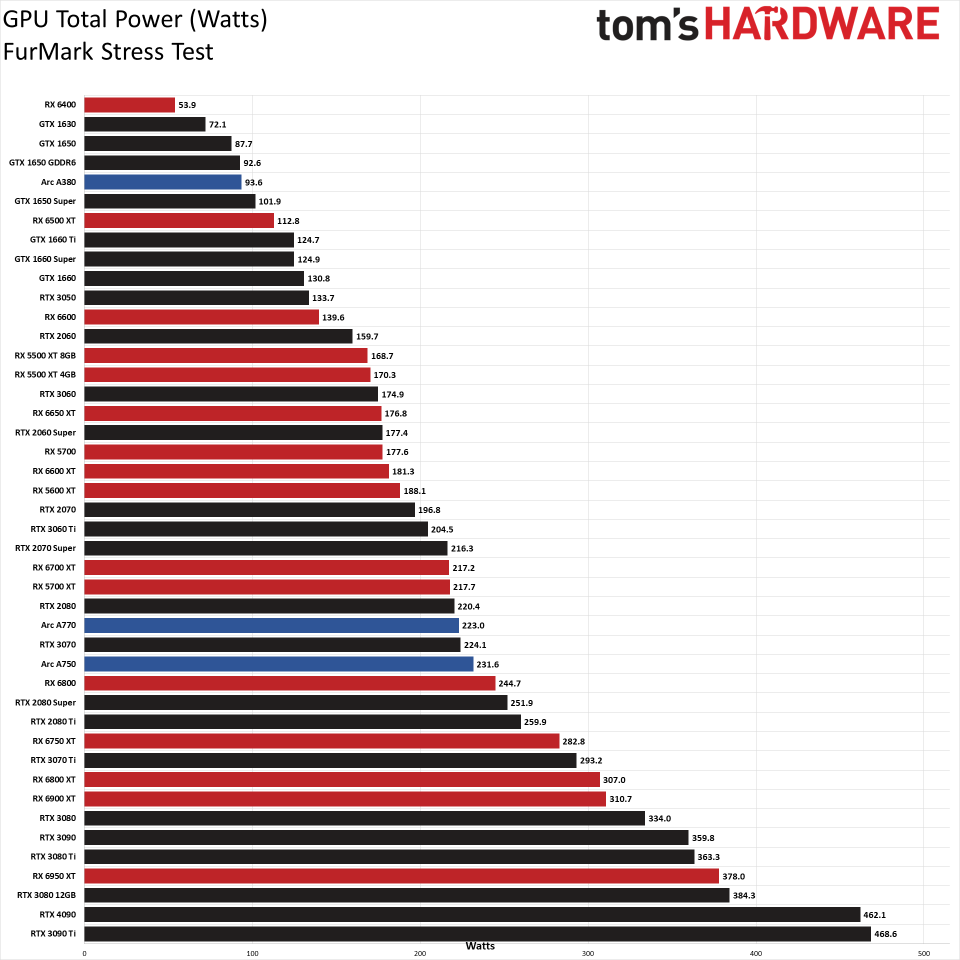
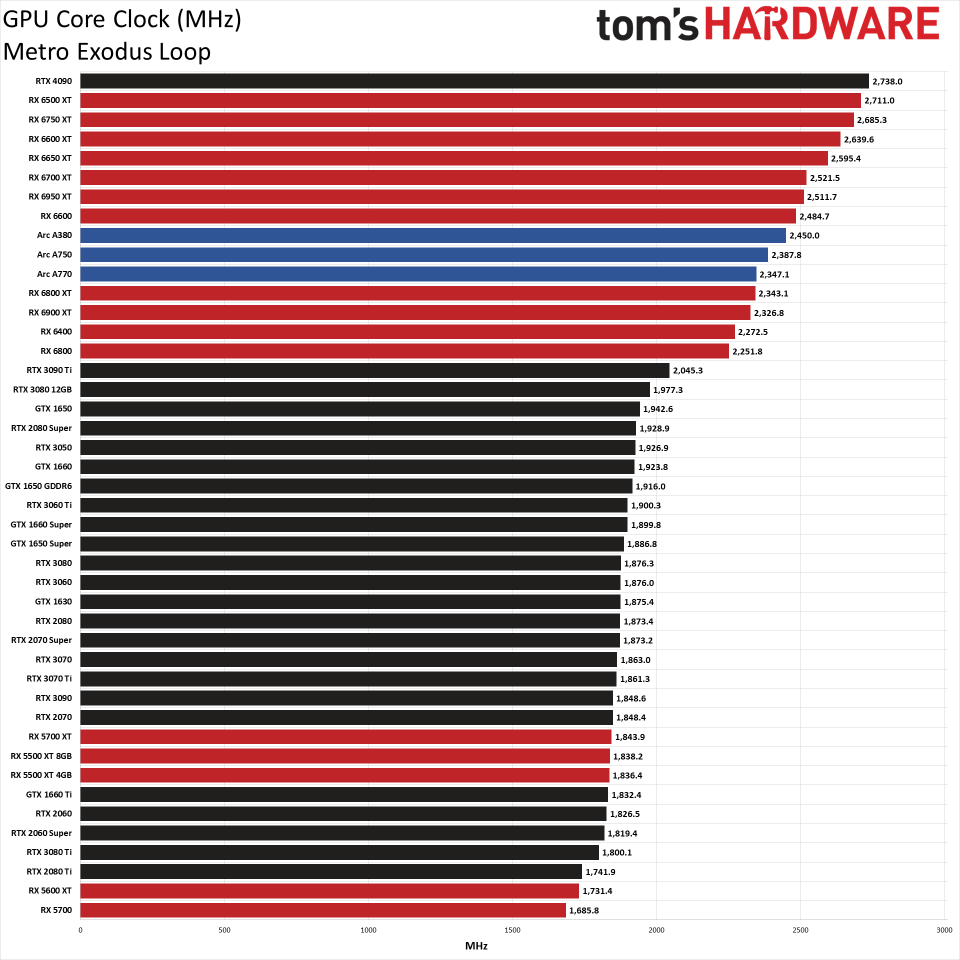
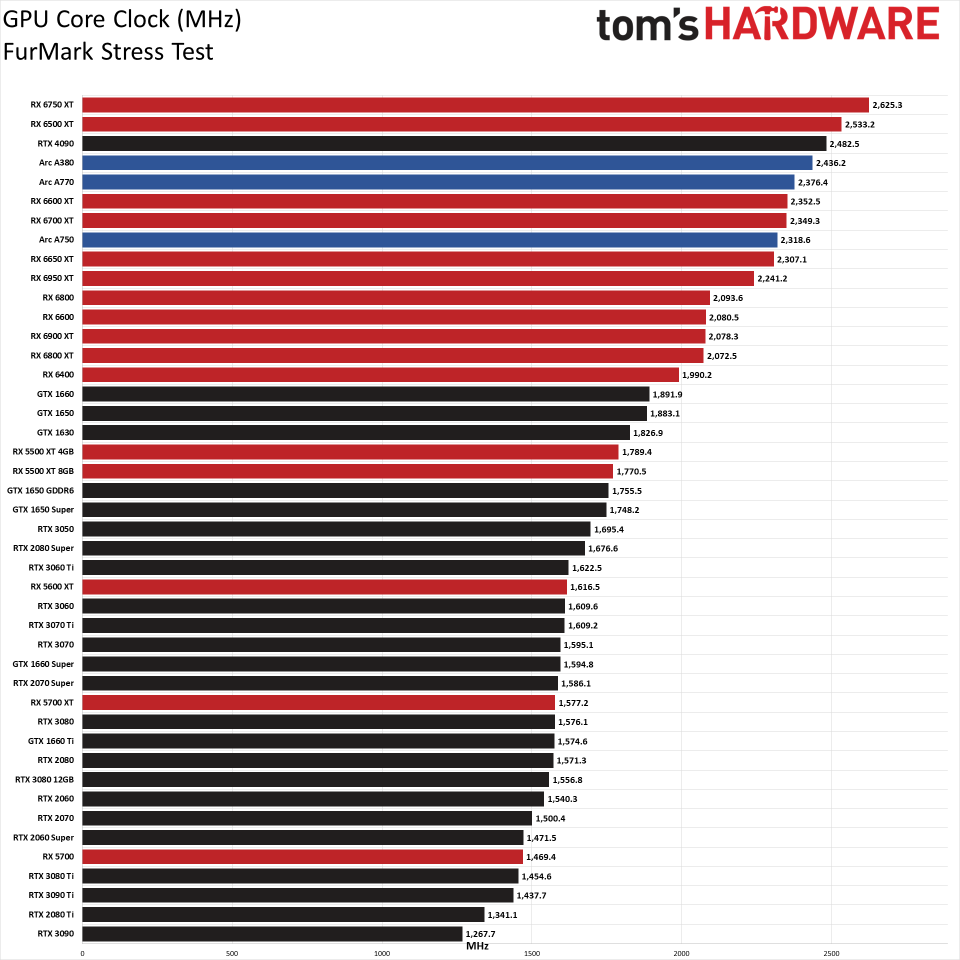
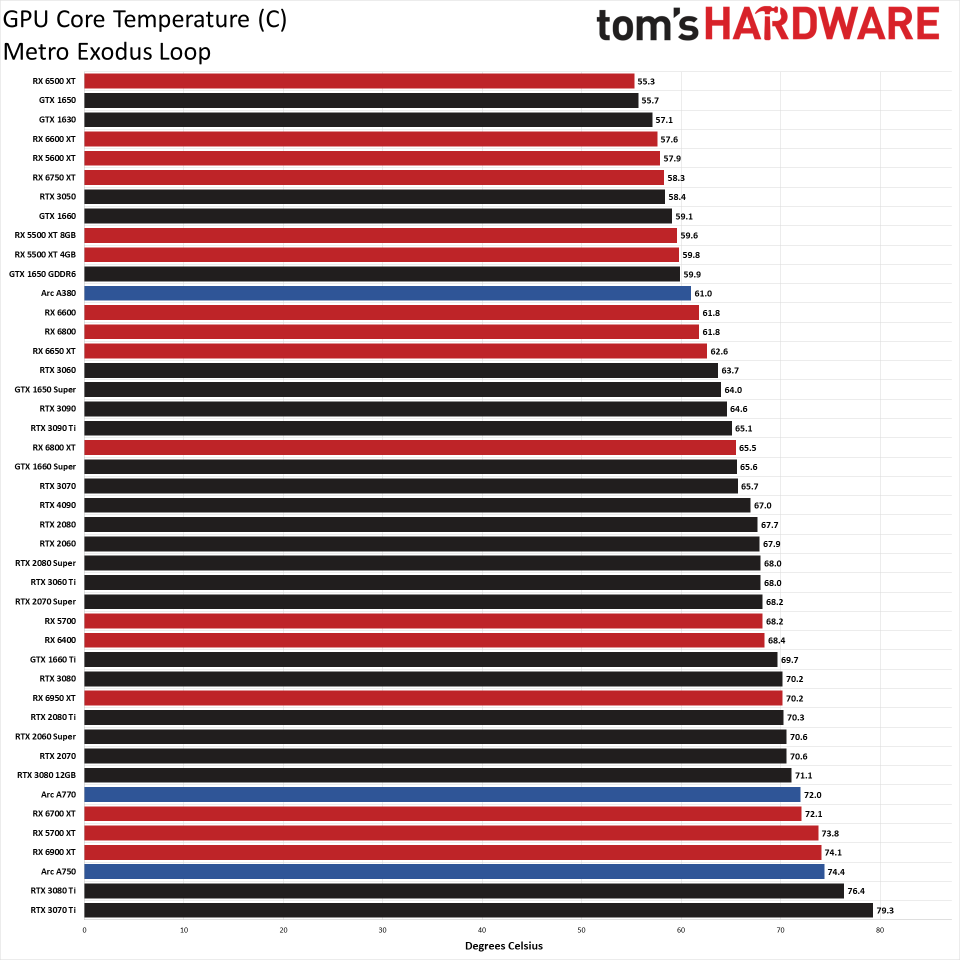
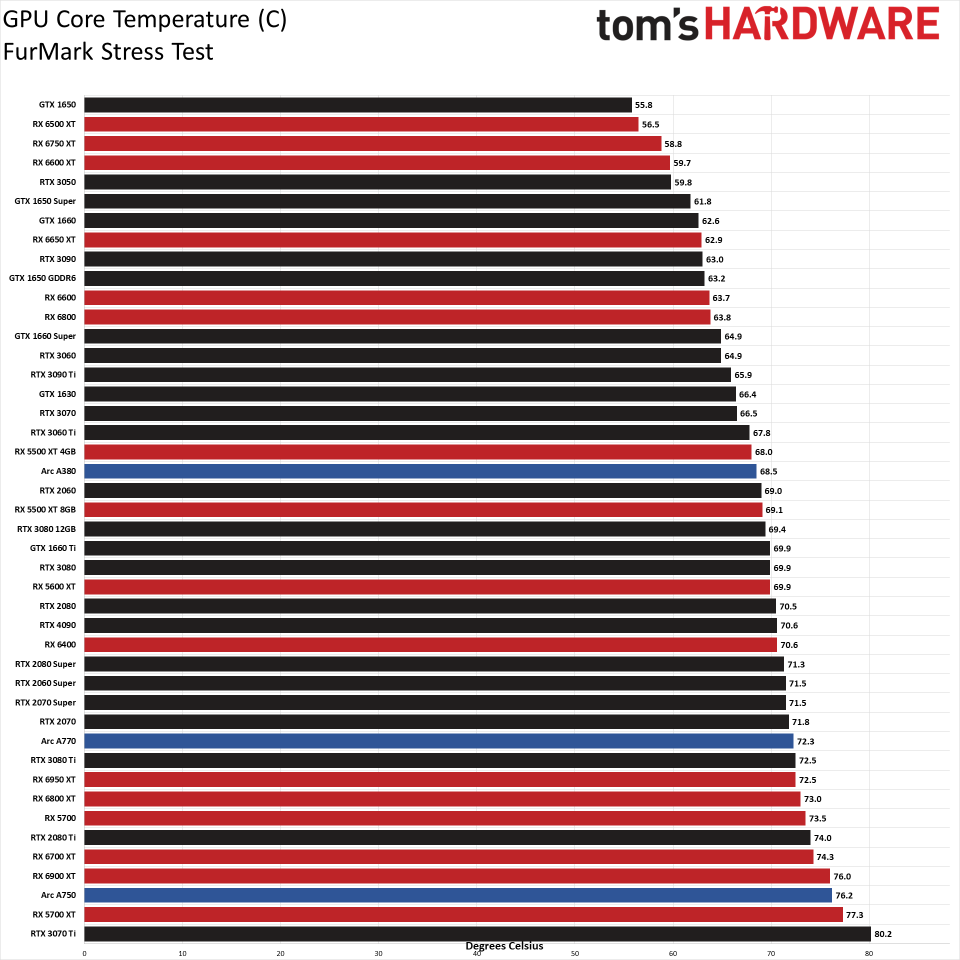
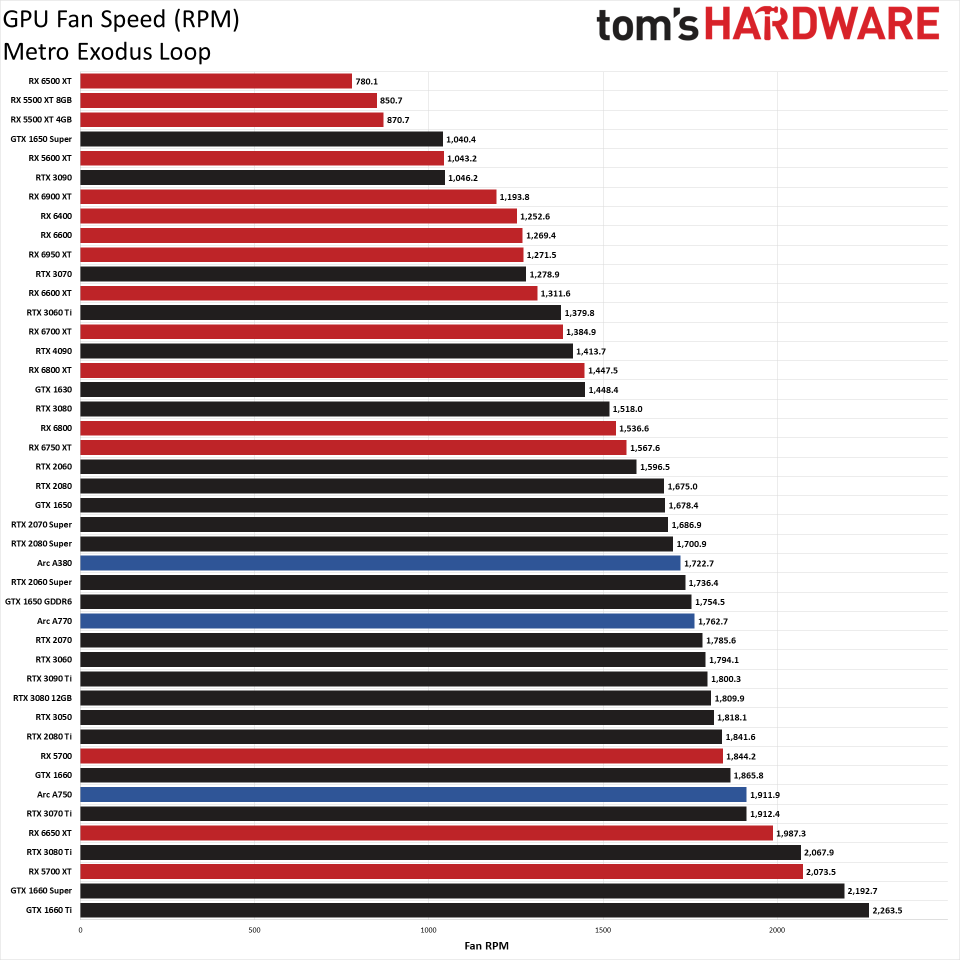
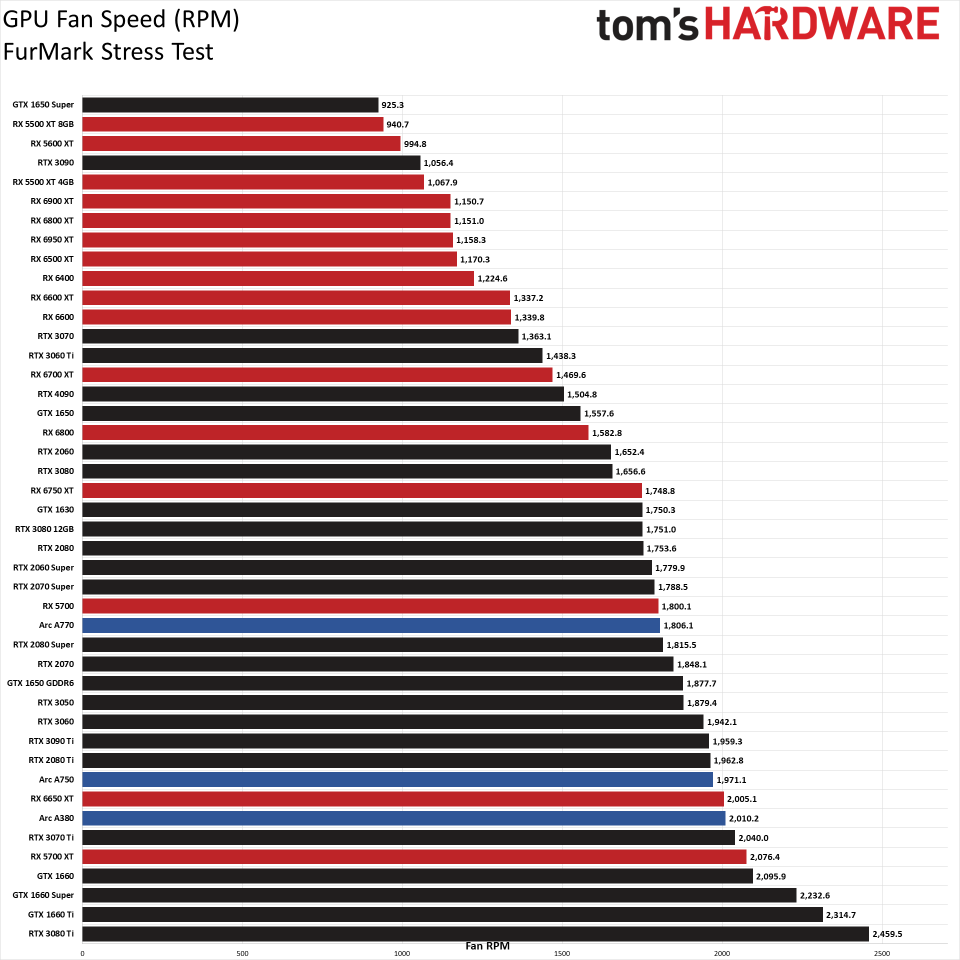
Finding Discounts on the Best Graphics Cards
With all the GPU shortages these days, you're unlikely to see huge sales on a graphics card, but you may find some savings by checking out the latest Newegg promo codes, Best Buy promo codes and Micro Center coupon codes.
Want to comment on our best graphics picks for gaming? Let us know what you think in the Tom's Hardware Forums.

